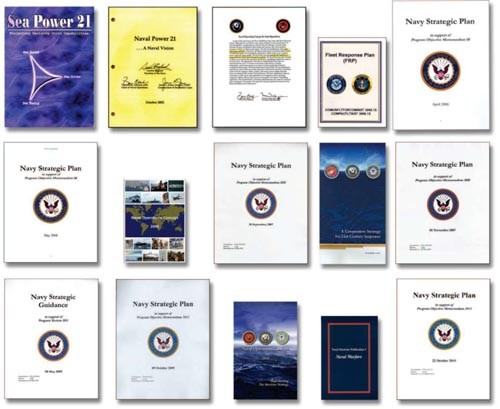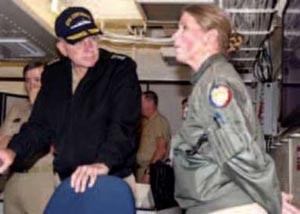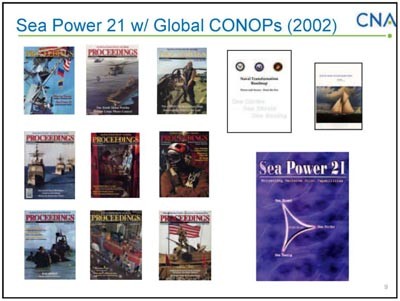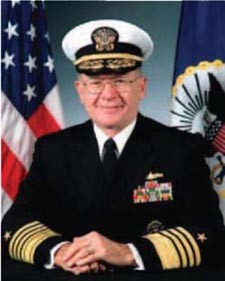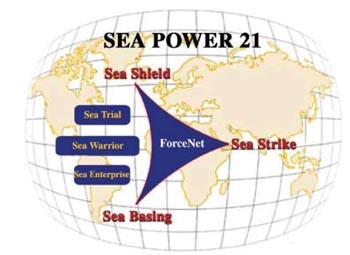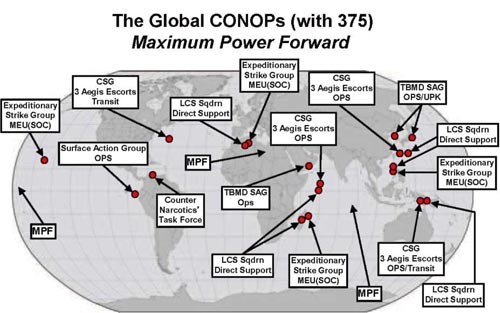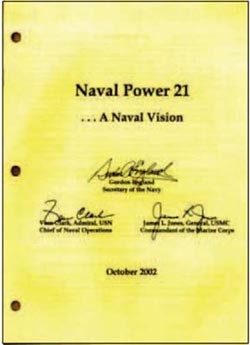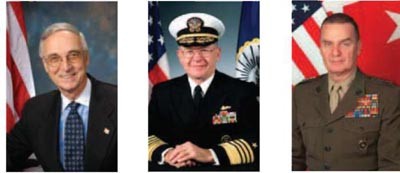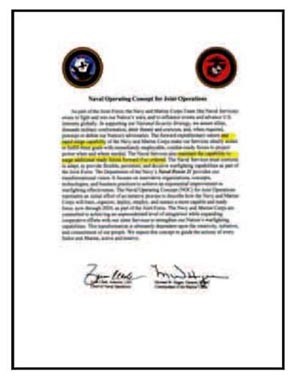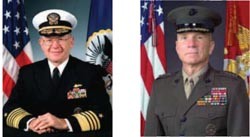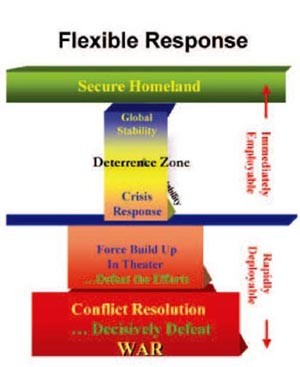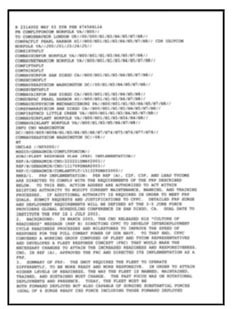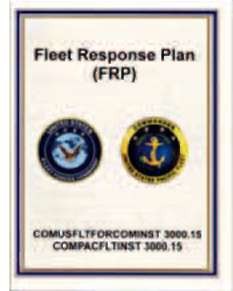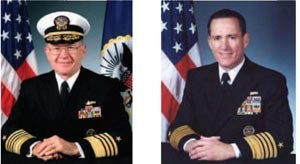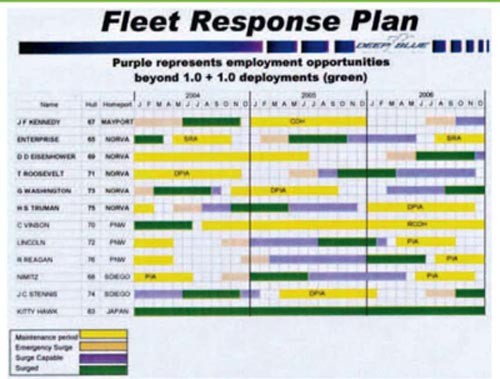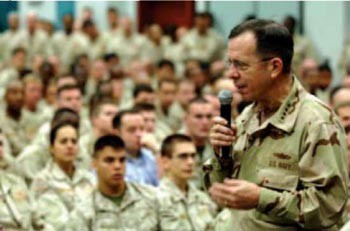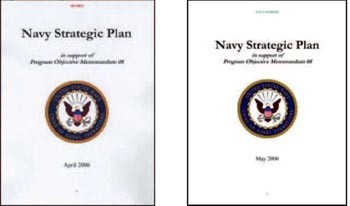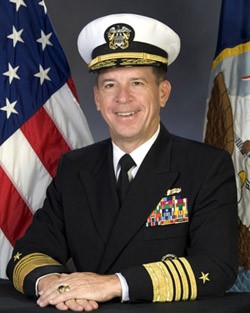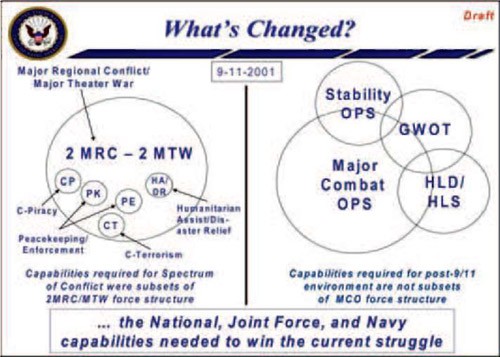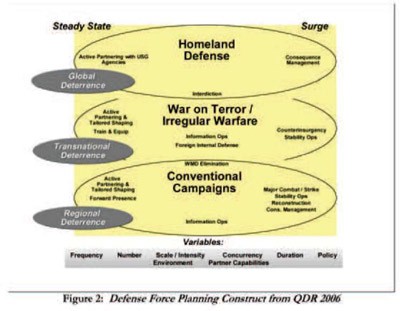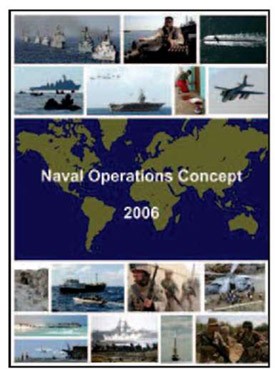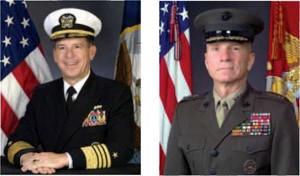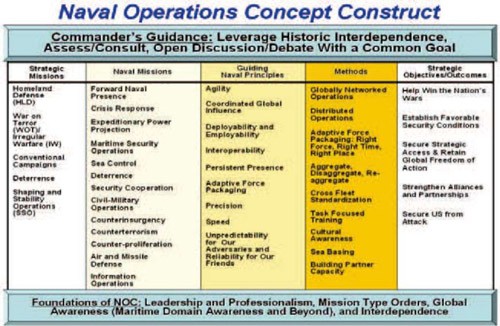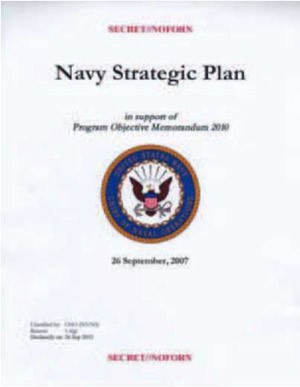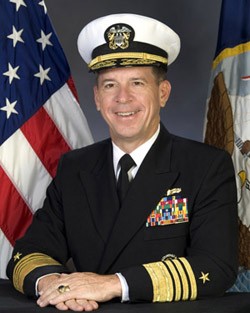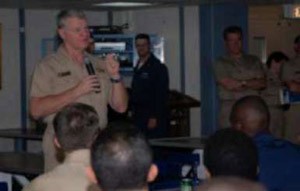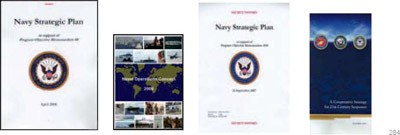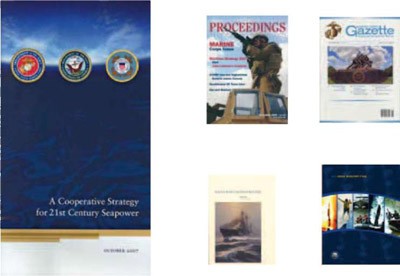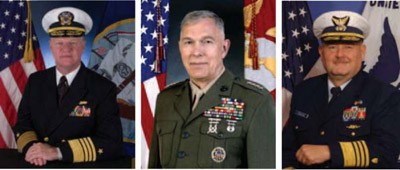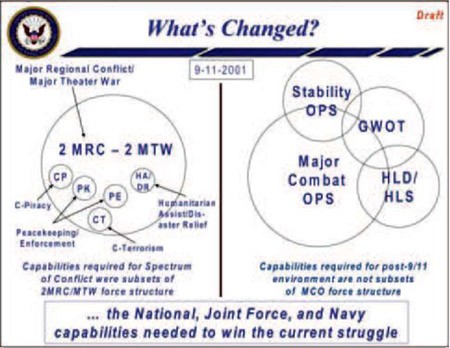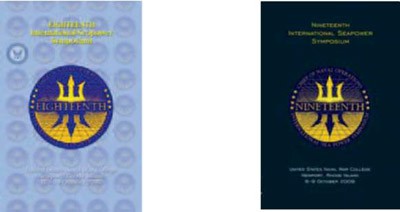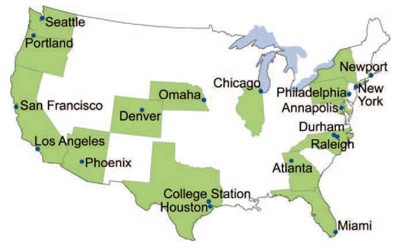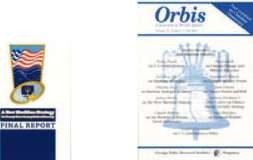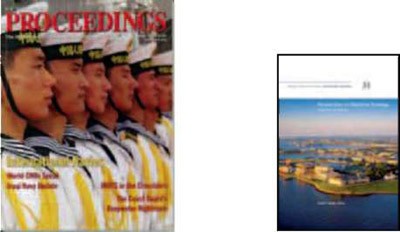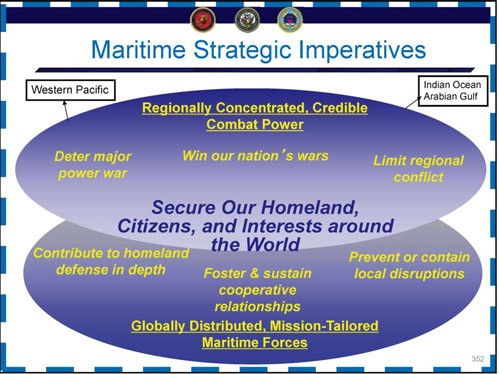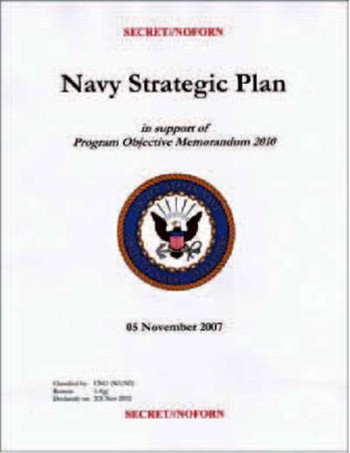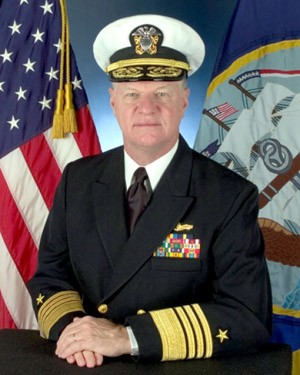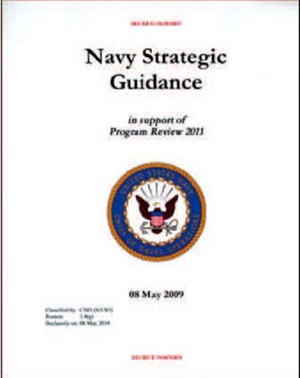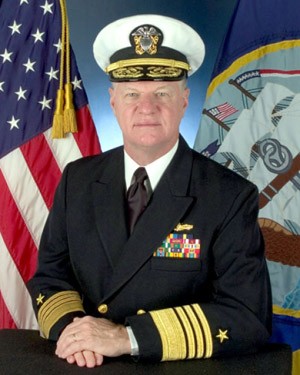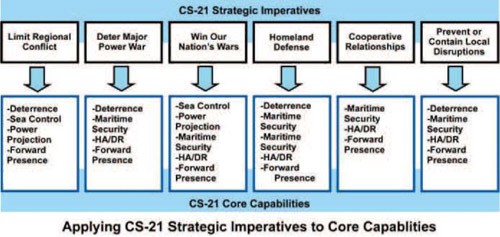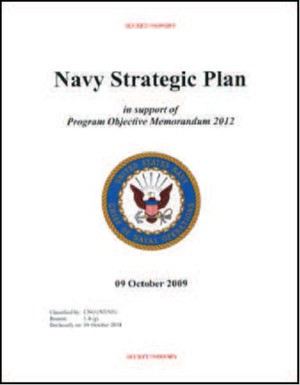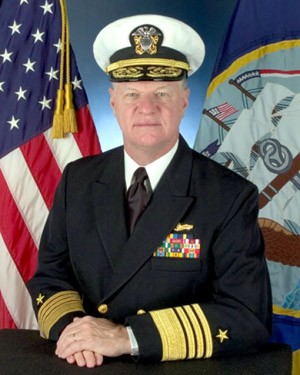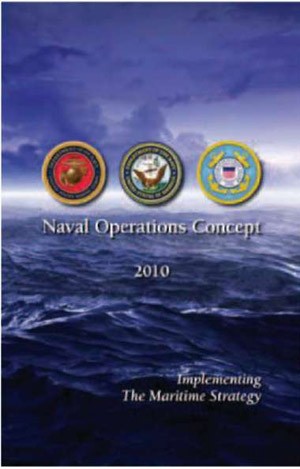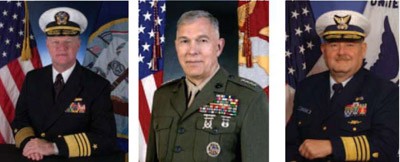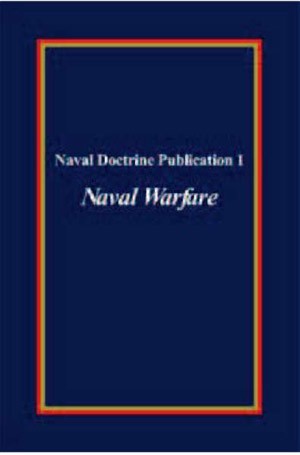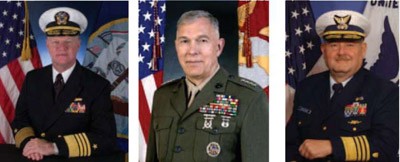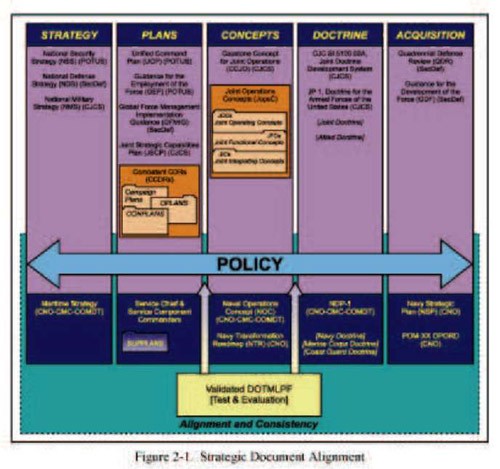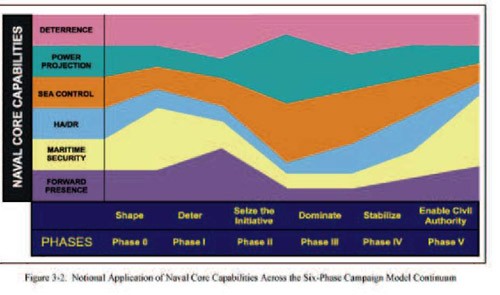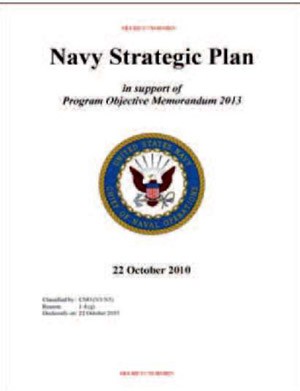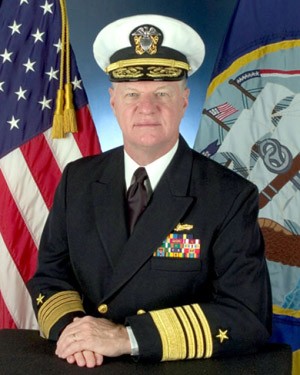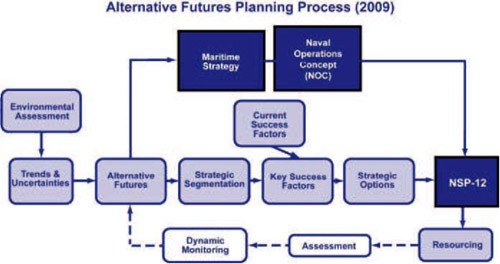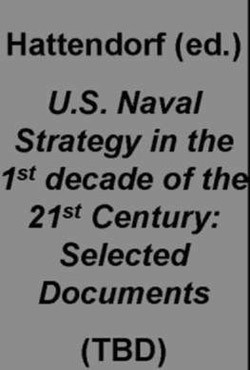
The Navy Department Library
US Navy Capstone Strategies and Concepts (2001-2010)
Strategy, Policy, Concept, and Vision Documents
Peter M. Swartz with Karin Duggan
MISC D0026241.A2/Final
December 2011
CNA
ANALYSIS & SOLUTIONS
CNA is a not-for-profit organization whose professional staff of over 700 provides in-depth analysis and results-oriented solutions to help government leaders choose the best courses of action. Founded in 1942, CNA operates the Institute for Public Research and the Center for Naval Analyses, the federally funded research and development center (FFRDC) of the U.S. Navy and Marine Corps.
CNA Strategic Studies (CSS), created in 2000, conducts high-quality research on and analysis of issues of strategic, regional, and policy importance. CSS' analyses are based on objective, rigorous examination and do not simply echo conventional wisdom. CSS provides analytic support to U.S. Government organizations and the governments of partner countries. CSS also maintains notable foundation-sponsored and self-initiated research programs. CSS includes a Strategic Initiatives Group, an International Affairs Group, and a Center for Stability and Development.
The Strategic Initiatives Group (SIG) looks at issues of U.S. national security, and military strategy, policy and operations, with a particular focus on maritime and naval aspects. SIG employs experts in historical analyses, futures planning, and long-term trend analysis based on scenario planning, to help key decision makers plan for the future. SIG specialties also include issues related to regional and global proliferation, deterrence theory, threat mitigation, and strategic planning for combating threats from weapons of mass destruction.
The Strategic Studies Division is led by Vice President and Director Dr. Eric V. Thompson, who is available at 703-824-2243 and on e-mail at thompsoe@cna.org. The executive assistant to the Vice President and Director is Ms. Rebecca Martin, at 703-824-2604.
The principal author of this study thanks especially Karin Duggan for graphic assistance; Loretta Ebner for administrative assistance; Gregory Kaminski, Laurie Ann Lakatosh, and Rhea Stone for library assistance; and Dana Smith and Anwar Fry for production assistance. A full listing of substantive contributors can be found in Peter M. Swartz and Karin Duggan, U.S. Navy Capstone Strategies and Concepts: Introduction and Background: Volume I, (D0026421.A1, December 2011). A full listing of all volumes in the CNA Navy Strategy series can be found on the inside back cover of this document.
Approved for distribution: March 2012
This document represents the best opinion of the author at the time of issue. It does not necessarily represent the opinion of the Department of the Navy.
Approved for public release. Distribution unlimited.
Copies of this document can be obtained through the Defense Technical Information Center at www.dtic.mil or contact CNA Document Control and Distribution Section at 703-824-2123.
Copyright 2012 CNA
This work was created in the performance of Federal Government Contract Number N00014-11-D-0323. Any copyright in this work is subject to the Government's Unlimited Rights license as defined in DFARS 252.227-7013 and/or DFARS 252.227-7014. The reproduction of this work for commercial purposes is strictly prohibited. Nongovernmental users may copy and distribute this document in any medium, either commercially or noncommercially, provided that this copyright notice is reproduced in all copies. Nongovernmental users may not use technical measures to obstruct or control the reading or further copying of the copies they make or distribute. Nongovernmental users may not accept compensation of any manner in exchange for copies. All other rights reserved.
Dr. W. Eugene Cobble, Jr.
Director, Strategic Initiatives Group
Contents
| CNO Admiral Vern Clark (2000-5) Sea Power 21 & Global CONOPS Naval Power 21: A Naval Vision Naval Operating Concept for Joint Operations Fleet Response Plan |
2 5 31 42 57 |
| CNO Admiral Michael Mullen (2005-7) Navy Strategic Plan in Support of POM 08 Naval Operations Concept 2006 Navy Strategic Plan in Support of POM 10 |
77 79 102 126 |
| CNO Admiral Gary Roughead (2007-2011) The "trifecta" A Cooperative Strategy for 21st Century Seapower Navy Strategic Plan in Support of POM 10 (Ch 1) Navy Strategic Guidance in Support of PR 11 Navy Strategic Plan in Support of POM 12 Naval Operations Concept 2010 Naval Doctrine Publication 1: Naval Warfare Navy Strategic Plan in Support of POM 13 |
140 142 143 194 203 219 235 273 300 |
| The Navy Strategic Planning Process | 316 |
| Companion references on USN 2000s documents | 320 |
--1--
ADM Vern Clark (CNO Jul 2000-Jul 2005)
Jun 2002 Sea Power 21
A "vision"; Included "Global CONOPs"
Oct 2002 Naval Power 21...A Naval Vision
Apr 2003 Naval Operating Concept for Joint Operations
May 2003 Fleet Response Plan
From "concept" to "plan"
Surface warfare officer
Served an unusually long 5-year CNO tour
Served Presidents Clinton, Bush; SECDEFs Cohen, Rumsfeld; SECNAVs Danzig, England
Saw himself as "the joint guy" & a business manager
1st CNO with an MBA; changed Navy business procedures
Had been Director of the Joint Staff (DJS) & of Operations (DJ3) on Joint Staff; TRANSCOM DJ5, DJ8
Candidate for Chairman of the Joint Chiefs of Staff
Sensitive to SECDEF, OSD concerns & direction
E.g.: Transformation Roadmaps, Fleet Response Plan
Effected numerous internal Navy reorganizations & realignments
--2--
Improved relations with USMC (e.g.: NOCJO)
Advocated 375-ship Battle Force goal (2003)
Then advocated range of 260-325 ships (2005)
In wake of 9/11 attacks, called repeatedly for "Maritime NORAD"
His concept was global, however, & multinational
Signature programs:
Littoral Combat Ship (LCS)
High-speed vessel (HSV) leases
Navy Expeditionary Combat Command (NECC)
New USN riverine & civil affairs capabilities
Optimal manning
Fleet readiness for Operation Enduring Freedom & Operation Iraqi Freedom surges
Fleet Response Plan
Navy Enterprises
OPNAV & fleet reorganizations & re-alignments
--3--
Saw POM as his strategy (as a service chief)
Initial concern for current readiness, not the future
No initial interest in promulgating a "glossy pub"
"I didn't come to the job with the idea of publishing another "vision" document...But it became apparent that I needed something to build on my top-five priorities...to mobilize and focus our energies, and to provide a 'stake in the ground' for the future."
Interview with Dr. Scott Truver, Mar 2003
Chose strategy-focused VADM John Morgan to be his last N3/N5 (2004)
But did not approve any new Morgan-originated strategy-oriented documents
Directed at least 5 OPNAV offices working on USN vision, strategy and concepts simultaneously
N00K & CNO Executive Panel (CAPTs Benkert, Clemente)
N00Z (CAPT Pandolfe)
OPNAV "Deep Blue" (RDMLs Sestak, Stavridis, Crowder, Mahon)
N513 (CDR Dolan, CAPTs Dossel, Klepper, Mangold, CDR Nagy)
N81 (RDML Sestak (2003-4)
Headed & at least partially staffed by the most well-educated and experienced leaders of the Navy's strategic planning community
Yet on his watch little was done to foster & sustain management & development of that community, which atrophied 8
--4--
Sea Power 21 w/Global CONOPs (2002)
Overview
Signed by CNO ADM Clark & numerous other admirals (Jun 2002 & subsequently)
NAVWARCOL speech & Transformation Roadmap
UNCLAS US Naval Institute Proceedings 9-article series; stand-alone 5-article medium-length pamphlet; on web
Billed as a "vision"
Principal target: Many, esp. USN officer corps
Drafted principally in OPNAV N00Z (& N81: CONOPS)
Threat to USN: Evolving regional challenges and transnational threats
8-concept framework: Sea Strike, Sea Shield, Sea Basing, FORCEnet, Sea Warrior, Sea Trial, Sea Enterprise, Global Concept of Operations
Very influential within OPNAV, NWDC, ONR, etc.
--5--
Signed by:
CNO ADM Vern Clark
During 2nd year in office
Individual admirals & a general signed amplifying portions
What it was
Billed as a Navy "vision" document
Subtitle: "Projecting Decisive Joint Capabilities"
Included a "Concept of Operations" (CONOPs)
NWC Current Strategy Forum speech (Jun 2002)
Naval Transformation Roadmap (Jun 2002)
UNCLAS 9-part US Naval Institute Proceedings series (Oct 02-Jan 04)
48 pages (incl. 10-page overview article; 4-page CONOPS)
Also stand-alone pamphlet (1st 5 parts only): 36 pages
Posted on web
President NAVWARCOL RADM Rempt "President's Forum" article, Naval War College Review (Spring 2003)
--6--
Why it was written (I)
To codify, rationalize & publicize CNO ADM Clark's many key initiatives to grow & change the fleet
CNO thought timing was right
New administration elected and in place
9/11 attacks had occurred
2001 DOD QDR & Nuclear Posture Review completed
Initial CNO goals for "current readiness" being achieved
To flesh out CNO ADM Clark's 375-ship goal rationale
Why it was written (II)
To re-energize sea and area control
To advertise the Navy as a joint player, and as more than just an enabling force
To bring USN & USMC together by elevating Sea Basing status & visibility, expanding ARG to include organic fire support ships (& thus capable of CLF command)
--7--
Context (I)
2nd year of Bush administration (2001-9)
Lackluster US economy pulling out of recession
Return to U.S. government deficit spending
Oil price starting to climb again
SECDEF Rumsfeld (2000-6)
CNO ADM Clark (2000-05)
Failed Al Qaeda attack on USS Sullivans (1999)
Al Qaeda attack on USS Cole (DDG-67) (2000)
9-11 attacks on America & responses (2001)
Continuing terrorist threat to US homeland
Numerous post-9/11 US joint ops launched
Noble Eagle (homeland defense)
Operation Enduring Freedom (OEF) (Afghanistan)
USN CVBGs provided majority of initial US air support
Context (II)
NATO invoked Article 5 for 1st time, to assist US following Al Qaeda attack (2001)
Customs & Border Patrol (CBP) Container Security Initiative (CSI) (from Jan 2002)
USS Greenville collision with Japanese fishing vessel (2001)
SORT Treaty (2002)
US withdrawal from US-Russian ABM Treaty (2002)
SECDEF prohibited "glossy" publication of Navy & other service posture statements (2001)
--8--
Context (III)
Taiwan elected 1st pro-independence president (2000)
Rising cross-Strait tensions
USN EP-3 collision with PLAN interceptor over South China Sea (Apr 2001)
President Bush approved arms sales to Taiwan, incl/diesel submarines, Kidd-class DDGs, P-3 maritime patrol aircraft (Apr 2001)
1st PLAN out-of-area global circumnavigation cruise (2002)
PRC-funded construction of Gwadar port, Pakistan on Indian Ocean began (2002)
USN port calls to PRC resumed (Nov 2002)
Occasional meetings under the US-PRC Military Maritime Consultative Agreement (MMCA) (1998)
Context (IV)
OSD push for military "Transformation"
VADM (Ret) Art Cebrowski headed new OSD Office of Force Transformation (2001-5)
Increased role of SECDEF & OSD
Declining USN force levels; increasing DON annual budgets
New USN 375-ship Battle Force goal
USN in 2002: 313 Battle Force ships & declining; 6 new ships authorized
CNO Clark satisfied with progress made in 1st 2 yrs in increasing current readiness. Turn to future readiness
--9--
Context (V)
Littoral Combat Ship (LCS) concept announced (2001)
Evolved from "Streetfighter" concept (1999) Industry developing proposals (2002)
For operations in the littorals
Strong CNO ADM Clark support
DOD canceled USN area-wide BMD program (2001)
MDA created new Aegis BMD midcourse program (2002)
CNA conference on Naval Forward Presence (2001)
Continued USN-USMC differences on amphibious ops command & control, especially fire support
NAVWARCOL Global War Games focused on Effects Based Operations (EBO) (1999, 2000, 2001)
Last Global War Games until 2008
Context (VI)
Fleet Forces Command created (2001)
NAVNETWARCOM created (May 2002)
Atlantic & Med no longer US focal theaters of war (2002)
JFCOM lost geographic responsibilities,
Atlantic Ocean divided among NORTHCOM, SOUTHCOM, & EUCOM
Med combat-credible forward presence hub disappeared
Unofficial DC-area Navy Study Group (1992-2005)
Convener: Dr. David Rosenberg
Participants included Sea Power 21 & CONOPS contributors
OPNAV Dir. of Navy Staff elevated to 3 stars (Aug 2001)
CNO Strategic Actions Group (OPNAV N00Z) created (2002)
--10--
Context (VII)
OPNAV N513 (Strategic Concepts branch) temporarily short-manned following 9/11 Pentagon attack
Had successfully argued vs. transfer from Pentagon to Crystal City
Branch head CDR Bob Dolan & 4 action officers killed
USN began JFMCC experiments & exercises
USN began "Sea Swap" experiments, rotating crews to forward deployed destroyers (2002-6)
CNO ADM Clark post-9/11 calls for a "Maritime NORAD"
NWDC placed under new Fleet Forces Command (2001), vice Naval War College
Naval postgraduate School 2-year Strategic Planning masters' degree curriculum terminated (summer 2001)
Cited references
The Maritime Strategy (1986)
...From the Sea (1992)
Forward...From the Sea (1994)
Did not reference 2nd (1st Bush) QDR (2001)
But did reference QDR "1-4-2-1" force sizing construct
Placed Sea Power 21 in USN historical strategic conceptual context
--11--
Context: Other contemporary publications (I)
7th and last Clinton National Security Strategy for a Global Age (2000)
2nd (1st Bush) QDR (2001)
Nuclear Posture Review (2001)
Added conventional weapons to strategic deterrent
"New Triad"
DoD Global Force Posture Review (underway)
Joint Staff Operational Availability 2003 planning effort (underway in 2002)
CJCS GEN Shalikashvili National Military Strategy (1997)
CJCS Joint Vision 2020 (2000)
CJCS Chairman's Risk Guidance
Context: Other contemporary publications (II)
SPG, CPG, JSCP, OPLANS & CONPLANS
Joint Pub 1, Joint Warfare of the Armed Forces of the United States (2000)
OPNAVINST 3000.13B, Personnel Tempo of Operations (Feb 2000)
Naval Power 21 and NOCJO (being drafted)
Large family of USMC warfighting concepts (1996-8)
MCDP 1 Warfighting (1997)
CMC Gen Jones, Marine Corps Strategy 21 (Nov 2000)
CMC Gen Jones Expeditionary Maneuver Warfare Marine Corps capstone concept (Nov 2001)
Navy-Marine Corps Tactical Air Integration Plan (2002)
--12--
Context: Other contemporary publications (III)
NWDC, Network Centric Operations: A Capstone Concept for Naval Operations 2000 draft; never approved)
Revised (2nd) USN-USCG National Fleet policy statement (Jul 2002)
SECAF Peters & CSAF Ryan, America's Air Force Vision 2020: Global Vigilance, Reach & Power (2000)
Brig Gen David Deptula USAF, Effects-Based Operations (2001)
Rebuttals by LtGen Van Riper USMC (Ret) & others
Hart-Rudman Commission Reports (1999-2001)
Context: Other contemporary publications (IV)
SACEUR/SACLANT Military Implementation of the Alliance Strategic Concept - The Maritime Dimension (Jul 2001)
VADM Cebrowski & John Garstka, "Network-Centric Warfare: Its Origin and Future," US Naval Institute Proceedings, Jan 1998)
Alberts, Garstka & Stein, Network Centric Warfare: Developing and Leveraging Information Superiority (1999)
BR 1806, British Maritime Doctrine (2nd ed.) (1999)
ADM William Owens, Lifting the Fog of War (2000)
CAPT Bernard Cole (Ret), The Great Wall at Sea (2001)
--13--
Context: Other contemporary publications (V)
Michelle Flournoy, CAPT Sam Tangredi USN et al., Report of the NDU QDR 2001 Working Group (2000)
NIC, Global Trends 2015 (Dec 2000)
Daniel Whiteneck & Richard Weitz, Naval Forward Presence and Regional Stability (CNA) (Sep 2001)
Sherry Sontag & Chris Drew, Blind Man's Bluff: The Untold Story of American Submarine Espionage (1998)
Friedman, Lexus and the Olive Tree: Understanding Globalization (1999)
John Mearsheimer, The Tragedy of Great Power Politics (2001)
Profs Looney, Schrady, Porch, Economic Impact of Naval Forward Presence: Benefits, Linkage & Future Prospects (NPS Monterey) (Dec 2001)
How it was written (I)
Conceptual roots in
...From the Sea, NSPG 2000
CNO SSG products, 1996-2001
Especially FORCEnet
CNO saw a need for a forward-looking vision for future readiness beyond his "Goals" (2002)
Current readiness goals well on the way to achievement
--14--
How it was written (II)
Drafted in new CNO Strategic Actions Group (N-00Z) OPNAV office (Spring 2002)
Global CONOPS drafted in OPNAV N81 (Spring 2002)
Based on operational concepts germinated in OPNAV Deep Blue
Personalities:
ADM Vern Clark, CNO
CAPT Frank Pandolfe, 1st N00Z Director (principal author)
CDR Steve Richter, N81, (Global CONOPS)
RDML Stavridis, OPNAV Deep Blue (ESG concept)
Many others subsequently contributed
How it was written (III)
Timing moved up to meet OSD Naval Transformation Roadmap tasking deadline (Jun 2002)
CNO then decided to use in NAVWARCOL Current Strategy Forum speech (Jun 2002)
"Global CONOPS" sometimes a stand-alone & sometimes subsumed under general introduction or under "Sea Strike"
Extensively socialized through briefings to Navy flag officers & staffs (Spring-Summer 2002)
--15--
How it was written (IV)
Series of 9 US Naval Institute Proceedings articles (2002-4)
I. CNO ADM Vern Clark, "Sea Power 21: Projecting Decisive Joint Capabilities" (Oct 2002)
a. Overview, including Global CONOPS
II. C3F VADM Michael Bucchi & OPNAV N8 VADM Michael G. Mullen, "Sea Shield: Projecting Global Defensive Assurance" (Nov 2002)
III. C2F VADM Cutler Dawson & OPNAV N6/N7 VADM John Nathman, "Sea Strike: Projecting Persistent, Responsive, and Precise Power' (Dec 2002)
How it was written (V)
Series of 9 US Naval Institute Proceedings articles (2002-4) (continued)
IV. OPNAV N4 VADM Charles W. Moore & CG MCCDC LtGen Edward Hanlon, Jr. USMC, "Sea Basing: Operational Independence for a New Century" (Jan 2003)
V. COMNAVNETWARCOM VADM Richard W. Mayo & OPNAV N6/N7 VADM John Nathman, "FORCEnet: Turning Information into Power," (Feb 2003)
VI. OPNAV N8 VADM Mike G. Mullen, "Global Concept of Operations" (Apr 2003)
--16--
How it was written (VI)
Series of 9 US Naval Institute Proceedings articles (2002-4) (concluded)
VII. CNET VADM Alfred G. Harms, CHNAVPERS VADM Gerald L. Hoewing, & COMNAVRESFOR VADM John B. Totushek, "Sea Warrior: Maximizing Human Capital" (Jun 2003)
VIII. CFFC/CLF ADM Robert J. Natter, "Sea Trial: Enabler for a Transformed Fleet" (Nov 2003)
IX. VCNO ADM Michael G. Mullen, "Sea Enterprise: Resourcing Tomorrow's Fleet" (Jan 2004)
President NAVWARCOL RADM Rempt "President's Forum" article, Naval War College Review (Spring 2003)
Outline
Our vision
Transformation for a violent era
Sea Strike: Projecting precise and persistent offensive power
Sea Shield: Projecting global defensive assurance
Sea basing: Projecting joint operational independence
FORCEnet: Enabling 21st century warfare
Global Concept of Operations
Achieving our vision
Sea Trial: The process of innovation
Sea Warrior: Investing in sailors
Sea Enterprise: Resourcing tomorrow's fleet
Our way ahead
--17--
Key ideas (I)
A "clear vision," not a strategy; with a "Global CONOPS"
Evolving regional challenges and transnational threats
Unified battlespace"
Advantages of sea-based forces throughout integrated sea-land-airspace-cyberspace
Naval forces "fully integrated" in joint force
Navy more than an "enabler"
Growing importance of sea & area control
Transformation; new cross-cutting categories to transcend platform communities & demonstrate change
Re-label categories for USN force structure decisions
Key ideas (II)
Tight accordance with "national military strategy," i.e.: SECDEF Rumsfeld 2001 QDR
New emphasis on "global joint operations against regional and transnational dangers"
Return to focus on global threats
No longer just "regional challenges." De-emphasis of MCOs
DoD "1-4-2-1 "force sizing construct
Defend the homeland
Deter adversaries in 4 critical forward regions
Swiftly defeat 2 enemies at the same time in 2 of those regions
Win one of those conflicts decisively
--18--
Sea Power 21 (2002)
Key ideas (I)
3 "fundamental concepts," "operations, "capabilities"
Sea Strike
Sea Shield
Includes forward-deployed ops for Homeland Defense
Sea Basing
USN accepts USMC label
USN-USMC conceptual (& spelling) differences remain
Enabler: FORCE Net
Supporting organizational processes
Sea Trial
Sea Warrior
Especially reductions in crew size
Sea Enterprise
Call for shared technologies & systems with other services
Global CONOPs
New distributed force packages
--19--
Key ideas (II)
4 "capability pillars" descend from 2 earlier frameworks
...From the Sea
Command Control and Surveillance
Battlespace Dominance
Power Projection
Force Sustainment
NSPG 2000
Knowledge superiority
Battlespace control
Battlespace attack
Battlespace sustainment
Sea Power 21
FORCEnet
Sea shield
Sea strike
Sea basing
Key ideas (III)
Also mentioned
"the continuum of warfare from the maritime domain - deterring forward in peacetime, responding to crises, and fighting and winning wars"
And a Turner variant: "enduring missions":
Sea control
Power projection
Strategic deterrence
Strategic sealift
Forward presence
Sea Power 21 overview article ended with the words: "anywhere, anytime"
--20--
Key ideas
Implement 2nd QDR (2001) "1-4-2-1" planning construct
Downgrade importance of forward "hubs"
Increase global presence
Widely disperse combat striking power
Simultaneous responses to crises around the world
New force packages
Integrate new SSGNs & BMD ships into force
USN accepted USMC-backed MPF(F) as important new capability
375 ships; 37 tailored independent strike groups
Recreated from a briefing: "Joint Global CONOPs for the Navy, CNA working group meeting," 12 Aug. 2002.
--21--
What was new?
Sea Power 21
Return to global approaches vice solely a set of regions
New vocabulary applied to earlier frameworks
Multiple signed articles by multiple flag officer authors
Global CONOPS
New force packages: CSGs, ESGs, TBMD SAGs, etc.
Integration of new SSGNs into force
Downgraded "hubs"
No CSG in the Mediterranean
More options for the President
MPF included in Battle Force
Littoral combat ships (LCS)
Possible USMC command of some ESGs
Not addressed (I)
Specific named regional & transnational threats & challenges
Allies (Mentioned in Sea Power 21, but not in Global CONOPS
Relationship to Marine Corps Strategy 21
Priorities among concepts, force packages presented
Globalization; world system
Humanitarian assistance/disaster response ops
Maritime security operations
Coastal & riverine operations & capabilities
--22--
Not addressed (II)
Piracy
Counter-drug operations
U.S. Merchant Marine
Non-Governmental Organizations (NGOs)
Post-hostilities ops
Surge capability & operations
Protection of or attacks on commerce at sea
Blockade operations
Convoy operations
Was it a "CONOPS?"
What is a "CONOPS" (officially)?
"Concept of operations: A verbal or graphic statement that clearly and concisely expresses what a joint force commander intends to accomplish and how it will be done using available resources. The concept is designed to give an overall picture of the operation. Also called commander's concept or CONOPS."
Joint Pub 1-02 DOD Dictionary of Military and Associated Terms (July 2001)
--23--
Subsequent analyses & critiques (I)
CDR (Ret) Terry McKearney, "Comment and Discussion," US Naval Institute Proceedings (Nov 2002)
Norman Polmar, "Comment and Discussion," US Naval Institute Proceedings (Jan 2003)
VADM (Ret) Robert Dunn, "Comment and Discussion," US Naval Institute Proceedings (Jun 2003)
ADM (Ret) Stansfield Turner, "Is the U.S. Navy Being Marginalized?" Naval War College Review (Summer 2003)
Peter Dombrowski & Andrew Ross, "Transforming the Navy: Punching a Feather Bed?" Naval War College Review (Summer 2003)
Subsequent analyses & critiques (II)
LCDR Jon Olson, "An Alternative Vision of Sea Power 21," US Naval Institute Proceedings (Oct 2003)
CDR (Ret) Jeff Huber, "Invasion of the Transformers," US Naval Institute Proceedings (Oct 2003)
RADM (Ret) Jerry Holland, "The Navy is More than Hauling Marines," US Naval Institute Proceedings (May 2004)
Naval Studies Board, Naval Analytical Capabilities: Improving Capabilities-Based Planning (2005)
Milan Vego, "Searching for a Strategy," Armed Forces Journal (Apr 2007)
CAPT (Ret) Sam Tangredi, "Sea Basing: Concept, Issues, and Recommendations," Naval War College Review (Autumn 2011)
--24--
Subsequent analyses & critiques (III)
Joe Overton, "Speaking of the Long War: Trawling for Historical Value in the Speeches of Navy Leadership, 2001-2011" (Paper delivered at USNA McMullen Naval History Symposium, 30 Sep 2011)
Amund Lundesgaard, U.S. Navy Strategy and Force Structure after the Cold War (Nov 2011)
CAPT Peter Haynes USN, "American Naval Thinking in the Post-Cold War Era: The U.S. Navy and the Emergence of Maritime Strategy, 1989-2007" (Ph.D. dissertation: Naval Postgraduate School, Monterey (Dec 2011))
Criticisms (I):
Focus too tactical
Should have been focused on "strategy" and/or "operational level of war"
Deliberately created to preclude development of a new Navy strategy
Mere programmatic repackaging & re-labeling
Nothing new
Not visionary or transformational enough
Just incremental modernization
Not joint enough:
"Sea-" prefixes a step backwards
Not congruent with DOD capabilities-based planning framework
--25--
Criticisms (II):
Not sufficient emphasis on Sea Control as fundamental purpose of the Navy
Dividing "sea control" conceptually among Sea Strike/Shield/Basing blurred understanding of the core mission of the Navy (ADM Turner)
Making "Sea Basing" a pillar was an unwarranted concession to USMC
Litany of programs & programmatic packages overshadowed the vision
Scant attention paid to amphibious ships was deliberate and ill-advised
Criticisms:
Merely a justification for 375 ships & the LCS
375 ships an impossible goal; Not enough $ available
Too focused on forward presence vice surge posture
Constructed from flawed ship & force package counting schemes & comparisons
"CSGs" and "ESGs" merely moved a few surface combatants and an SSN from each CVBG to each ARG "CSGs" and "ESGs" were constructs for training & workups only. Forward CCDRs & NCCs typically dispersed their assets in theater. CCDRs & NCCs had no need for ESGs, just separate ARG/MEUS & SAGs
Surface Action Groups not particularly visionary; Reminiscent of Battleship SAGs of 1980s
Too jargon-laden for comprehension & use
Distorted Sea Basing concept by downplaying amphibs
--26--
Sea Power 21 influence (I):
Wide within OPNAV & other USN headquarters
Reflected in changed organizations & processes
Far more influence on internal OPNAV, FFC, NWDC and ONR frameworks than as a statement of Navy vision
Sea Power 21 influence (II):
"Capability Pillars" became the organizing template (2003-2010+) for:
"Sea Shaping" pillar added in 2005
CFFC assignment of numbered fleet commanders and NNWC as "operational agents" (OA) for Fleet warfighting CONOPS, concept development & experimentation (continuing as of 2010)
NWDC concept development & experimentation
ONR Future Naval Capability (FNC) technology development program aligned with "pillars" (2005 through 2010+e)
--27--
Sea Power 21 influence (III):
Resource for flag speeches, testimony
Cited in new CNO-CMC naval concepts
Enhanced Networked Seabasing (2003)
FORCEnet: A Functional Concept for the 21st Century (2005)
Ideas & terminology used in annual Navy Program Guides (through 2007)
Ideas & terminology used in annual Highlights of the Department of the Navy Budget (through May 2009)
Helped increase DOTMLPF focus on Sea Shield (esp. missile defense), Sea Basing, FORCEnet
Cited in ONR Naval S&T Strategic Plans (2007, 2009, 2011)
Why did it have the influence it did?
Simple, catchy, easy-to-remember construct
Relentless repetition in speeches, testimony, articles
Interest, power & influence of CNO ADM Clark
Continued support by successor ADM Mullen
"Sea Power 21 is still germane and operative...I'm very supportive of Sea Power 21" (Oct 2005)
"Sea Power 21 will remain the framework for our Navy's ongoing transformation" (Testimony, Mar 2006)
Institutionalization of categories into OPNAV organizations & analytic processes
As a single-service document, was of limited influence on subsequent bi-service & tri-service efforts
--28--
Global CONOPs influence
OPNAVINST 3501.316A finally officially codified policy for composition, capabilities of CSGs, ESGs, SSGs (Sep 2007)
Signed by CNO ADM Mullen just before his relief
Lasted only 3 years
OPNAVINST 3501.316B (Oct 2010) undid many of the changes
CSG force packages endured in the fleet as of 2010
ESG force packages abolished (2009)
ESGs had not operated as units; Replaced by ARG/MEUs
Term "ESG" still used for ARG/MEUs commanded by general/flag officers
375-ship, 37-group Navy force goals lasted only a few years
Why did it have what influence it did? (I)
Advocacy & repetition by CNO
Published as a detailed US Naval Institute Proceedings article, but omitted from stand-alone pamphlet
Discussed, however, in basic Sea Power 21 article text
Article author was upwardly-mobile flag officer VADM Mullen
Repeated & expanded upon in NOCJO
Fleet became comfortable working up CSGs & ESGs
--29--
Why did it have what influence it did? (II)
Forward deployment emphasis moderated by Fleet Response Plan focus on surge (2003)
ESG concept dissipated as fleet ship numbers declined:
MEUs deployed separately to Iraq, Afghanistan
Surface combatants, submarines and individual amphibious ships deployed separately
COCOM/NCC demand for ARG/MEUs, SAGs, not ESGs
375-ship force level goal superseded by 260-325-range goal (2005) & 313-ship goal (2006)
Influence on subsequent capstone documents
Spurred SECNAV England drafting of Naval Power 21 (2002)
Reflected heavily and expanded upon in NOCJO (2003)
Cited in NOCJO, NSP ISO POM 08 (2006), & Naval Operations Concept (2006)
"Capability Pillars" used in:
NOCJO
Navy Strategic Plan ISO POM 08
Navy Strategic Plan ISO POM 10 (2007)
Global CONOPS reflected and fleshed out in NOCJO
--30--
Naval Power 21...A Naval Vision (2002)
Overview
Signed by SECNAV England, CNO ADM Clark, CMC Gen Jones (Oct 2002)
Billed as a "vision"
Principal target audience: USN & USMC leadership
Very short (6 pp). UNCLAS. Published on the web
Drafted in new OPNAV "Deep Blue" office
To counter threats from our nation's enemies
Central theme: Navy-Marine Corps team
USN-USMC TACAIR integration
Brought together Sea Power 21, Global CONOPS, (& Marine Corps 21) concepts & initiatives
Sea Strike, Sea Shield, Sea Basing, FORCEnet, Sea Warrior, Sea Trial, Sea Enterprise; 25% increase in size of the fleet goal
Little lasting influence
--31--
Signed by:
SECNAV Gordon R. England
CNO ADM Vern Clark
During 3rd year in office
CMC Gen James L. Jones
What it was
Billed as a "Vision"
Short (6 pages)
UNCLAS
Published on the web (Oct 2002)
--32--
Why it was written
To assert visibility of new SECNAV England & his agenda of bringing USN & USMC closer together
To bring USN Sea Power 21 & USMC Strategy 21 visions and concepts together in one overarching consensual document, endorsed by SECNAV
To provide a conceptual basis for USN-USMC TACAIR integration - essentially a cost-saving measure
Tie DON to Bush Administration & SECDEF Rumsfeld "transformation" agenda
To call for increasing fleet size by 25%
In wake of 9/11 attacks, to assert USN role in homeland security is primarily far forward, but also at home
Principal target: USN & USMC leadership
Context (I)
Late in 2nd year of Bush (R) administration (2001-9)
Lackluster US economy pulling out of recession
Oil price starting to climb again
Return to U.S. government deficit spending
SECDEF Rumsfeld (2001-6)
SECNAV England (2001-06)
CNO Clark (2000-05)
--33--
Context (II)
Al Qaeda terrorist attack on USS Cole (DDG-67) (2000)
9-11 attacks on America (2001)
USN strategy office briefly decimated
Numerous post-9/11 US joint ops launched
Noble Eagle (homeland defense)
Operation Enduring Freedom (OEF) (Afghanistan)
USN CVBGs provided majority of initial US air support
Continuing terrorist threat to US homeland
PLAN-USN aircraft collision (2001)
Context (III)
SECDEF Rumsfeld push for "transformation"
2nd (1st Bush) QDR (2001)
310-ship Battle Force goal
"1-4-2-1" force sizing construct
Decline - but not demise - of "2 MCO" construct
"Capabilities-based planning"
"New triad," to include offensive precision-strike conventional weapons
USN in 2002: 313 Battle Force ships & declining; 6 new ships authorized
DON annual budgets rising modestly
USN began JFMCC experiments (1999)
--34--
Context (IV)
NOCJO being drafted
OEF: Marine general commands USN-USMC TF
SECDEF-directed integration of OPNAV & Secretariat
Fleet Forces Command created (2001)
OPNAV Deep Blue created (2001)
For innovative concepts ISO current GWOT combat ops
NAVNETWARCOM created (May 2002)
Cited references
2nd (1st Bush administration) DOD Quadrennial Defense Review (2001)
CMC Gen Jones, Expeditionary Maneuver Warfare USMC capstone concept (Nov 2001)
CMC Gen Jones, Marine Corps Strategy 21 (Nov 2000)
Sea Power 21 (2002)
--35--
Context: Other contemporary publications (I)
MCDP 1 Warfighting (Jun 1997)
MCDP 1-0 Marine Corps Operations (Sep 2001)
CJCS GEN Shelton Joint Vision 2020 (2000)
Revised Joint Pub 1: Joint Warfare of the Armed Forces of the United States (2000)
CJCS Chairman's Risk Guidance
Navy-Marine Corps Tactical Air Integration Plan (2002)
Context: Other contemporary publications (II)
ADM William Owens, Lifting the Fog of War (2000)
SECAF Peters & CSAF Ryan, America's Air Force Vision 2020: Global Vigilance, Reach & Power (2000)
Brig Gen Deptula USAF, Effects-Based Operations (2001)
Rebuttals by LtGen Van Riper USMC (Ret)
Profs Looney, Schrady, Porch, Economic Impact of Naval Forward Presence: Benefits, Linkage & Future Prospects (NPS Monterey) (Dec 2001)
Whiteneck & Weitz, Naval Forward Presence and Regional Stability (CNA) (Sep 2001)
--36--
How it was written
Drafted in new OPNAV N3/N5 Deep Blue shop
Contributions by OPNAV N513
Personalities: SECNAV England, RDML Jim Stavridis (Deep Blue), CAPT Will Dossel (N513)
Outline
The naval vision
Qualities that matter: What it takes to win
People: The heart of the team
Homeland security
Projecting power and influence: Winning at sea and beyond
Future naval capabilities: Transformational by design
Sea enterprise: Capturing business efficiencies
The future: An expanded naval force
Organizing the force: A naval operational concept
Refining the way ahead: Navy and Marine Corps strategies
Conclusion: Charting the way ahead
--37--
Key ideas (I)
"3/4/8" framework
3 "fundamental pillars"
We assure access; We fight and win; We are continually transforming to improve
4 "fundamental qualities of naval forces"
Decisiveness; Sustainability; Responsiveness; Agility
7 Seapower 21 "concepts"
Sea Strike, Sea Shield, Sea Basing, enabled by FORCEnet
Sea Warrior, Sea Trial, Sea Enterprise
To counter threats from "our nation's enemies"
Concept of "continually transforming"
Focus on Navy-Marine Corps team
Call for Navy-Marine Corps strike fighter integration
Described Marine Corps Strategy 21
"Homeland Security: We will engage potential adversaries and address threats to our security as far from the United States and our interests as possible...Additionally, in partnership with the U.S. Coast Guard and other federal agencies the Navy-Marine Corps team will continue defense at home"
--38--
What was new?
1st joint USN-USMC capstone document in 8 years
SECNAV endorsement of Sea Power 21 framework
Call for doubling number of strike groups & increasing fleet size by 25%
Navy role in homeland security seen as primarily far forward but also at home
Not addressed (I)
Nature of threats, beyond "our nation's enemies"
"Global CONOPs" portion of Sea Power 21
Priorities among concepts discussed Globalization, world system, world trade issues
Maritime security operations
Anti-terrorism, counter-drug, Anti-piracy operations
Convoys, blockades
--39--
Not addressed (II)
Sealift
U.S. Merchant Marine
Coastal & riverine capabilities and operations
U.S. industrial base & shipbuilding industry
Non-Governmental Organizations (NGOs)
Surge
Subsequent analyses & critiques
CAPT Peter Haynes, "American Naval Thinking in the Post-Cold War Era: The U.S. Navy and the Emergence of Maritime Strategy, 1989-2007" (Ph.D. dissertation: Naval Postgraduate School, Monterey (Dec 2011))
--40--
Criticisms
Document too disjointed
"Never heard of it"
Neither publicized nor used
Never gained much traction beyond those directly involved in its development and promulgation
Influence:
Little, but...
Cited in FORCEnet: A Functional Concept for the 21st Century (2005)
Cited in ONR Naval S&T Strategic Plans (2007, 2009, 2011)
Why?
Overwhelmed by Sea Power 21, Marine Corps 21, & Naval Transformation Roadmaps 2002 & 2003
No strong SECNAV public push or follow-up effort to build consensus
25% increase in fleet size never achieved
--41--
Influence on subsequent capstone documents
Minimal
Recorded SECNAV push for more USN-USMC integration. Set stage for NOCJO & NOC
Cited in NOCJO as "our transformational vision"
Naval Operating Concept for Joint Operations (2003)
--42--
Overview
Signed by CNO ADM Clark & CMC Gen Hagee (Apr 2003)
Billed as an "Operating Concept"
Principal target: USN, USMC officer corps
Medium-length (23 pages). UNCLAS. Published on web
Navy drafters: OPNAV N513 (Strategy Branch) & Navy Warfare Development Command (NWDC)
Amplified Sea Power 21 & Global CONOPS concepts
Elevated ready-force surge alongside forward presence Near-term, mid-term & long-term (to 2020) visions
Capabilities-based approach: To counter conventional & unconventional threats challenging US military superiority
Explicit relationships to joint & sister service concepts
Tentative USN-USMC Sea Basing consensus
Little influence in Navy. More in Marine Corps
Signed by:
CNO ADM Vern Clark
3rd year in office
CMC Gen Michael W. Hagee
--43--
What it was
Billed as an "operating concept" & a "capstone concept"
Tasked in Naval Power 21 (Oct 2002) Signed April 2003
UNCLAS. Published on web
Medium-length: 23 pages
Almost triple the length of 1997 Navy Operational Concept (8 pages)
Explicitly superseded by Naval Operations Concept (NOC) (2006)
Why it was written
To lay out vision for near-term and far-term naval capabilities and operations
To lay out USN-USMC contributions to the joint force (including SOF), implementing "1-4-2-1" defense strategy & Joint Vision 2020
As USN-USMC input to proposed Joint Operations Concepts
To achieve USN-USMC consensus on USMC Sea Basing, the Maritime Prepositioning Force (Future) (MPF(F)) & other USMC-originated concepts
To expand upon & implement vision of Seapower 21
Principal target: USN, USMC officer corps
--44--
Context (I)
3rd year of Bush administration (2001-9)
Modest US economic growth
Oil price climbing
Increasing U.S. government deficit spending
SECDEF Rumsfeld (2001-6)
SECNAV England (2001-2006)
CNO ADM Clark (2000-05)
Al Qaeda terrorist attacks on USS Cole (2000) & MV Limburg (2002)
9-11 Al Qaeda attack on America
Continuing terrorist threat to US homeland
SECDEF Rumsfeld policy of spurring defense "transformation"
Context (II)
OEF operational experience & lessons learned
USN CVBGs provided majority of initial US air support
Continued subsequent heavy USN air support
More post-9/11 joint ops launched
Planning for, conducting Iraq invasion, occupation
Invasion (Mar 20, 2003); Iraq occupied (Apr 2003)
OIF appeared to have secured "defeat of Iraq"
President Bush "Mission Accomplished" speech on USS Abraham Lincoln (CVN-72) (1 May 2003)
Continuing counter-insurgency & stabilization ops unforeseen
Heavy USN, coalition MSO ops in Arabian Sea
Desert Shield/Desert Storm strike & MPS experience assimilated
CVNs as AFSBs routinized
--45--
Context (III)
1st PLAN out-of-area global circumnavigation cruise (2002)
PRC-funded construction of Gwadar port, Pakistan on Indian Ocean (from 2002)
USN port calls to PRC resumed (Nov 2002)
Occasional meetings under the US-PRC Military Maritime Consultative Agreement (MMCA) (1998)
USJFCOM Millenium Challenge 2002 war game
Crystallized US military conceptual debates
LtGen USMC (Ret) Van Riper critique
Container Security Initiative (from Jan 2002)
Proliferation Security Initiative (PSI) (2003)
Declining USN force levels; increasing DON annual budgets
375-ship Battle Force USN force goal
USN in 2003: 297 Battle Force ships & declining; 5 new ships authorized
Context (IV)
Fleet Forces Command created (2001)
CNO Clark post-9/11 calls for a "Maritime NORAD"
MV Westpac Express under MSC charter as HSV 4676 (2002); Swift HSV2 being leased (2003)
New littoral Combat Ship (LCS) classes under development
New "Hybrid Sailor" concept under development, to man LCSs
USN "Sea Swap" experiments, rotating crews to forward deployed destroyers (2002-6)
Unofficial DC-area Navy Study Group (1992-2005)
Convener: Dr. David Rosenberg
Participants included NOCJO contributors
--46--
Cited references (I)
1st Bush National Security Strategy (2002)
Unilateral, pre-emptive strike; maintenance of US military superiority
CJCS Shelton Joint Vision 2020 (2000)
Naval Power 21 (2002)
Sea Power 21 (2002-3)
CMC Gen Jones Marine Corps Strategy 21 (Nov 2000)
Cited references (II)
Naval Transformation Roadmap (2002)
Family of USMC concepts
CMC Gen Jones, Expeditionary Maneuver Warfare Marine Corps capstone concept (Nov 2001)
Operational Maneuver From the Sea (OMFTS) (1996)
Ship-to-Objective Maneuver (STOM) (1997)
USN-USMC Enhanced Networked Sea Basing concept draft
--47--
Context: Other contemporary publications (I)
NATO Strategic Concept of the Alliance (1999)
Emphasis on crisis management
SACEUR/SACLANT Military Implementation of the Alliance Strategic Concept - The Maritime Dimension (Jul 2001)
National Strategy to Combat Weapons of Mass Destruction (2002)
2nd (1st Bush) QDR (2001)
310-ship BF goal; "1-4-2-1" force sizing construct
Joint Staff Operational Availability 2003 report (2002)
CJCS Chairman's Risk Guidance
SPG, CPG, JSCP, OPLANS & CONPLANS
Context: Other contemporary publications (II)
Joint Pub 1, Joint Warfare of the Armed Forces of the United States (2000)
Joint Pub 3-0, Doctrine for Joint Operations (2001)
Outlined 4 phases of joint operations
NIC, Global Trends 2015 (Dec 2000)
Large family of USMC warfighting concepts (from 1996)
MCDP 1 Warfighting (Jun 1997)
MCDP 1-0 Marine Corps Operations (Sep 2001)
Navy-Marine Corps Tactical Air Integration Plan (2002)
Revised USN-USCG National Fleet policy statement (2002)
--48--
Context: Other contemporary publications (III)
SECAF Peters & CSAF Ryan, America's Air Force Vision 2020: Global Vigilance, Reach & Power (2000)
US Army FM 3-0 Operations (2001)
BR 1806, British Maritime Doctrine (2nd ed.) (1999)
Kugler & Frost (eds.) The Global Century (2001)
CDR Steve Benson chapter on USN & Globalization
CAPT Sam Tangredi (ed.) Globalization and Maritime Power (2002)
Col Bob Work USMC (Ret) Challenge of Maritime Transformation: Is Bigger Better? (2002)
CAPT Edward Smith USN, Effects-Based Operations: Applying Network-Centric Warfare in Peace, Crisis, and War (2002)
Context: Other contemporary publications (IV)
OPNAVINST 3000.13B, Personnel Tempo of Operations (Feb 2000)
DoD Military Power of the PRC (2002)
First Annual Report to Congress
CAPT Bernard Cole (Ret), The Great Wall at Sea (2001)
Friedman, Lexus and the Olive Tree: Understanding Globalization (1999)
CAPT Wayne Hughes (Ret) Fleet Tactics & Coastal Combat (1999)
Sherry Sontag & Chris Drew, Blind Man's Bluff (1998)
--49--
How it was written (I)
SECNAV England tasked in Naval Power 21 (Oct 2001)
Initial draft by OPNAV N513 & MCCDC (2002)
CAPT Will Dossel, CAPT Tommy Klepper, CDR Tim Groelinger, CDR Paul Nagy (OPNAV N513)
Col Art Corbett & staff (MCCDC)
Col Corbett had been assigned (as Maj) to N513 (1994-5)
N5/N51 oversight: VADM Green/RDML Wachendorf
Contentious USN-USMC issues, esp. seabasing specificity
Never got beyond 3-star level
How it was written (II)
Effort resurrected by NWDC, MCCDC (2003)
NWDC: CAPT Brian Barrington
MCCDC: LtCol Mike Raimondo
OPNAV N513 & HQMC PP&O contributed to end-game
OPNAV oversight: VADM Kevin Green (N3/N5) & RDML Eric Olson (N51) (SEAL officer)
SOF role highlighted
--50--
Outline
Introduction
Strategic environment
Implications for the joint force
FORCEnet: Enabling an integrated Navy and Marine Corps team
Naval operations in the near and mid terms
Naval operations in the far term
The way ahead
Conclusion
Key ideas (I)
"How the Navy & Marine Corps will operate across the full range of military operations in the near, mid & far terms through 2020"
NOCJO meets US "1-4-2-1" national defense strategy requirements
Navy-Marine Corps Team seeks to do it all
Elevated ready-force surge alongside forward presence
Near-term, mid-term & long-term (to 2020) visions
Meet conventional and unconventional threats
Meet nation-state and non-state adversaries
Priorities not discussed
--51--
Key ideas (II)
Amplified Sea Power 21 & Global CONOPS concepts
Expanded discussion of Sea Strike, Sea Shield, Sea Basing, FORCEnet
Full discussion of Global CONOPS
Endorsed new Global CONOPS force packages
Did not refer to Global CONOPS by name, however
Limited discussion of Sea Warrior & Sea Trial
No discussion of Sea Enterprise
Integrated USMC concepts of Expeditionary Maneuver Warfare (EMW), Operational Maneuver From the Sea (OMFTS), Ship-to-Objective Maneuver (STOM) throughout
Key ideas (III)
Tentative USN-USMC Sea Basing consensus
Capabilities-based approach, vs. generic threats
State & non-state actors
Conventional & unconventional threats that challenge US military superiority
Call for new, revised version of NDP 1, Naval Warfare (1994)
Call for more integrated USN-USMC education, training, doctrine, experimentation, research & development
Explicit relationships to joint & sister service concepts & operations, including Special Operations Forces (SOF)
--52--
What was new?
USN-USMC operating concept
Rigorous look at near-term, mid-term, long-term
Effort to specifically & comprehensively link to joint & sister service concepts, especially SOF
Sea Basing elevated
Surge elevated for 1st time since The Way Ahead (1991)
--53--
Not addressed
Priorities among the concepts presented
Specific conventional & unconventional threats
Maritime security, anti-piracy operations, blockade, convoys
Coastal & riverine capabilities & operations
Globalization, world system
U.S. Merchant Marine
U.S. industrial base & shipbuilding industry
Non-governmental organizations
Link to force level planning, programming, budgeting
Subsequent analyses & critiques
CAPT Peter Haynes, "American Naval Thinking in the Post-Cold War Era: The U.S. Navy and the Emergence of Maritime Strategy, 19892007" (Ph.D. dissertation: Naval Postgraduate School, Monterey (Dec 2011))
--54--
Criticisms
Unnecessary & unused Overwhelming USMC influence
Navy should have had it's own single-service NOC.
USN-USMC Sea Basing consensus soon unraveled
Influence
Little in Navy, except (small) concept development community
More in USMC
Helped spawn 2 CNO-CMC-signed concepts
Enhanced Networked Seabasing operational concept (2003)
FORCEnet: A Functional Concept for the 21st Century (2005)
--55--
Why this influence?
Little USN interest in formal long-range concept development in general, & in conformance to joint concept development processes & definitions in particular
Useful to small USN/USMC concept development groups, however
Little CNO ADM Clark involvement or follow-through
No USN fanfare. USMC cited sometimes
Eclipsed in Navy by wide Sea Power 21 internal & external publicity, and use in USN POM development
Published only on the web
Influence on subsequent capstone documents
Minimal
2003 NOCJO tasking to update 1994 NDP 1 largely ignored until 2010
Futurist orientation & conformance to joint practices of NOCJO (2003) not continued in NOC (2006)
Precedent considered valuable by OPNAV, HQMC, MCCDC. Superseded by NOC 2006
--56--
Fleet Response Plan (2003)
Overview
Put out by CNO ADM Clark, CFFC ADM Natter (Mar 2003)
First a "concept"; then a "plan; then a "program"
To increase & maintain USN surge capability, to meet short-notice demands for significant naval combat forces forward
To change Navy culture from "deployment-centric" to "readiness-centric;" to enable "presence with a purpose"
Advertised as tested in Summer Pulse 04
Principal targets: DOD civilian leadership, USN officers. Later, USN enlisted & families
Series of short internal USN directives (1 made into glossy); numerous external flag interviews/speeches/articles; web
Initially conceived in OPNAV, esp. "Deep Blue" office
Big internal USN influence, esp. waterfront; OSD impressed.
Institutionalized: 2007; Specific goals evolved; Policy in 2010
--57--
Promulgated by:
CNO ADM Vern Clark
3rd year in office
COMFLTFORCOM ADM Robert Natter
What it was (I)
Billed first as a "concept"; then as a "plan"; later - occasionally - a "program"
Implementing OPNAVINST called it an "operational framework" (2006)
2007 fleet implementing instruction contained a "vision"
--58--
What it was (II)
Published in internal USN directives & external flag officer interviews, speeches & articles & on web
CNO concept (Mar 2003)
Short: 3 pages
COMFLTFORCOM ADM Robert Natter, "Creating a Surge Ready Force," US Naval Institute Proceedings (Sep 2003)
Short: 3 pages
What it was (III)
Flag officer testimony, speeches, articles & interviews, e.g.:
COMFLTFORCOM ADM William Fallon, "The Navy's New Operational Construct," The Hook (Spring 2004)
"Surge Protectors: Submarines Prove Vital to the Navy's Fleet Response Plan," Undersea Warfare (Fall 2004)
Institutionalized
OPNAVINST 3000.15, Fleet Response Plan (FRP) (Aug 2006)
COMUSFLTFORCOMINST 3000.15/COMPACFLTINST 3000.15, Fleet Response Plan (FRP) (Aug 2007)
Also published as booklet (51 pp)
--59--
Why it was written (I)
US Navy concern that forward presence had waned as an effective argument within the US government for a robust US Navy
To change Navy culture & practices to better link Navy to Bush Administration policies & priorities re: preventive war & anti-terrorism crisis response
To respond to SECDEF & OSD demand for more, faster surge capability from all DoD components, post-9/11 (2003)
To argue to SECDEF & OSD that more Navy force structure was usable to the nation - through surging forward on demand - beyond the fraction that was forward deployed
To bolster arguments for follow-on to Nimitz-class CVN ("CVN-21")
To satisfy CCDR plans and force requirements
Why it was written (II)
To change a host of Navy policies, practices & procedures in order to ensure significant surge forces were ready
To sustain these changes by creating new deliberate processes & changing Navy culture from "deployment-centric" to "readiness-centric"
To forge a new internal Navy consensus regarding its deployment strategy and policies "To give the President more options" & "presence with a purpose"
Principal targets: DOD civilian & joint leadership, USN planners. Later, USN enlisted & families
--60--
Context (I)
3rd year of Bush administration (2001-9)
Modest US economic growth
Oil price climbing
Increasing U.S. government deficit spending
Bush administration advocacy of "preventive wars'
National Security Strategy of the United States (Sep 2002)
"the greater the threat, the greater is the risk of inaction - and the more compelling the case for taking anticipatory action to defend ourselves..."
"To forestall or prevent such hostile acts by our adversaries, the United States will, if necessary, act preemptively in exercising our inherent right of self-defense"
SECDEF Rumsfeld push for military transformation
Context (II)
"9-11" Al Qaeda attacks on America (Sep 2001)
OEF, OIF, Noble Eagle, Active Endeavor, JTF GITMO, OEF Philippines, CJTF HOA all recently begun & ongoing
USN OEF surge (2001)
USN CVBGs provided majority of initial US air support
USN OIF surge: 7 CVNs, 9 LHA/LHDs (2003)
OIF appeared to have secured "defeat of Iraq"
President Bush "Mission Accomplished" speech on USS Abraham Lincoln (CVN-72) (1 May 2003)
Continuing counter-insurgency & stabilization ops unforeseen
Al Qaeda terrorist attacks on USS Cole (2000) & MV Limburg (2002)
1st PLAN out-of-area global circumnavigation cruise (2002)
Turkey refused US military access to ports, air space, en route to OIF (Mar 2003)
Proliferation Security Initiative (PSI) (2003)
--61--
Context (III)
CNO ADM Clark (2000-5)
Priority to date: Improved readiness
USN in 2003: 297 Battle Force ships & declining; 5 new ships authorized
Increasing annual DON budgets
375-ship Battle Force USN force goal
Navy plans for follow-on to Nimitz-class CVNs
Some push-back within Pentagon
USN forces allocated to CCDRs through CJCS-run Global Naval Force Presence Policy (GNFPP) (since 1991)
USN began "Sea Swap" experiments, rotating crews to forward deployed destroyers (2002-6)
RADM John Morgan (senior SECNAV MA) initiative to reexamine "Principles of War" (2003)
Cited references
Global Naval Force Presence Policy (GNFPP)
CNO 2003 "Culture of Readiness" message
Other previous CNO messages
2007 CFFC/CPF FRP implementing instruction mis-cited 2006 Naval Operations Concept (as Naval Operating Concept)
--62--
Context: Other contemporary publications (I)
OPNAVINST 3000.13B, Personnel Tempo of Operations (Feb 2000)
Dan Goure, "The Tyranny of Forward Presence," Naval War College Review (Summer 2001)
Sea Power 21 (Jun 2002)
No mention of surge
National Security Strategy of the United States (Sep 2002)
Advocacy of "preventive wars," implying surge capabilities
Context: Other contemporary publications (II)
3rd (2nd Bush) QDR (2005, later 2006) impending
DoD Global Defense Posture Review underway
Post-OIF "Navy Reconstitution Plan" briefings
Joint Staff Operational Availability 2003 report
CPG, JSCP, OPLANS & CONPLANS
--63--
How it was written (I)
SECDEF & OSD demand for more, faster surge capability from all DOD components, post-9/11 (2001) & Iraq War (2003) surges
Joint Staff Operational Availability (OA) 2003 report
Focus on service support for CCDR needs
Emphasis on increasing strategic speed to implement 2 near-simultaneous MCOs
"10-30-30" force sizing construct
Seize the initiative within 10 days
"Swiftly defeat" one enemy within 30 days
Commence "swiftly defeat" operations vs. 2nd enemy in another theater 30 days later
Adopted by OSD in Strategic Planning Guidance (SPG)
Catalyst: USD (P&R) Dr. David Chu remark:
"There is in the Navy and Marine Corps a substantial portion of the structure that is unavailable to the president on short notice, short of heroic measures"
Enabler: Expanding USN carrier operating cycle (from about 1986)
Origin: USN PERSTEMPO policy (6-month maximum deployments, etc.) (1986)
GNFPP (1993), 3.0 CVBG TAR minimum rule, IMP maintenance, etc. contributed
Gave appearance of increasing "slack time" in carrier schedules; provided increased surge potential
--64--
How it was written (III)
Development methodology
Concept incubated in OPNAV (Deep Blue)
Later passed to CFFC for plan development & implementation
Initial OPNAV role
VADM Willy Moore (OPNAV N4) originated concept
Initial concept papers and briefings drafted in new OPNAV Navy Operations Innovation Group ("Deep Blue")
RDML Doug Crowder (Director, 2002-4)
CAPT Joe Bouchard
How it was written (IV)
CNO tasked Commander, Fleet Forces Command (ADM Robert Natter) to further develop concept, plan (Mar 2003)
ADM Natter published FRP implementation plan (May 2003)
Major internal and external relations effort to socialize FRP concepts and procedures (2003-7)
Numerous flag officer interviews & articles
Advertised as tested in Summer Pulse 04
Near-simultaneous global forward deployment of 7 CSGs
Included 2-CSG Majestic Eagle 2004 exercise of Morocco
Institutionalized in 2007
Comprehensive Fleet Forces Command/Pacific Fleet instruction
--65--
Outline (COMFLTFORCOM May 03 msg)
FRP implementation
Background
Summary of FRP
Create a culture of readiness
Meet new readiness and surge thresholds
Change maintenance, manning and training processes to support surge and deployment
Lengthen inter-deployment cycle
Key implementation milestones
Key ideas (I)
Create USN "culture of readiness" to supplant "culture of deployment"
Replace "D-minus" thinking with "R-plus" thinking
Focus on output (strategic speed in support of CCDR plans)
Increase USN capability to surge combat-ready CSGs & - later - other fleet elements, on short notice
Elevate priority of USN short-notice surge capability, within the Navy
Permanent combat-credible USN forward presence no longer the main peacetime goal
--66--
Key ideas (II)
Capitalize on recently improved fleet readiness
Change current USN training, maintenance, manning policies & practices
Redesign and lengthen fleet Inter-Deployment Training Cycle (IDTC) to increase ship, aircraft & personnel short-notice surge availability
New phases, timelines, vocabulary, goals
Not intended to cost more than GNFPP process
Key ideas (III)
FRP could enable a new "Flexible Deployment Concept"
Intermittent planned focused surges & pulses of varied duration to various locations in support of CCDR requirements and specific national priorities
Would reduce - but not eliminate - combat-credible forward presence in permanent forward "hubs"
Could reduce predictability of USN forward operations
More options for the President, the SECDEF and the CCDRs
More effective "presence with a purpose"
--67--
The FRP goal: An evolving metric
2003-5: "6 & 2"
6 CSGs deployable within 30 days; 2 within 90 days
2005-7: "6 & 1"
6 CSGs deployable within 30 days; 1 within 90 days
2007: "3+3+1"
3 CSGs deployed; 3 deployable within 30 days; 1 in 90 days
2007: "5 +1"
USS John F. Kennedy decommissioned
By 2010: "3+2+1"
Evolution
Total USN carrier numbers declined from 12 to 11 (2004-2007)
USS John F. Kennedy (CV-67) in commission but did not deploy (2004-2007)
Planned to decline temporarily to 10 in 2012
USN relaxation of PERSTEMPO deployment length rules (2007)
FRP extended to ESGs (2007)
By 2007, explicit FRP cycle goals promulgated for numerous USN ship, aircraft, unit types
COMUSFLTFORCOMINST 3000.15 (Aug 2007)
--68--
Key supporting graphics
None in basic FRP documents (naval messages, instructions, etc.)
But ubiquitous in internal Navy briefings on FRP
Most important were depictions of carrier and other ship scheduling options
E.g.: "Before FRP" and "After FRP"
Actual "After FRP" example provided in following slide, for illustrative purposes
--69--
What was new?
Emphasized surge and strategic speed
"6 & 2" goal metric & "progressive readiness" concept
Attempt to change USN culture: "R+" vice "D-" thinking
Formalized training milestones
Major OPNAV Deep Blue-orchestrated CHINFO campaign (Summer Pulse 04)
Implications for changing USN deployment to a "Flexible Deployment Concept" (FDC)
Not addressed
Most things not directly related to deployment policy & increased surge capability
Document - while arguing for a basic cultural change within the Navy - was narrowly focused on cultural & administrative changes necessary to improve USN readiness to surge
Did not purport to be a comprehensive Navy policy or strategy statement
Only threat & policy driver mentioned was war on terrorism
--70--
Subsequent analyses & critiques (I)
CNA studies
K. Smith et al., Explorations of the Fleet Response Plan (CNA 2005)
GAO reports
Defense Logistics: GAO's Observations on Maintenance Aspects of the Navy's Fleet Response Plan (Jun 2004)
Military Readiness: Navy's Fleet Response Plan Would Benefit from a Comprehensive Management Approach and Rigorous Testing (Nov 2005)
Military Readiness: Navy is Making Progress Implementing its Fleet Response Plan, but Has Not Fully Developed Goals, Measures, and Resource Needs (Feb 2008)
RAND report
Benjamin Lambeth, American Carrier Air Power at the Dawn of a New Century (2005)
Subsequent analyses & critiques (II)
U.S. Naval Institute Proceedings articles
CDR Donald H. Braswell, "Carrier Strike Groups Need a Combat Surge Capability," (Sep 2004)
LT B.W. Stone, "A Bridge Too Far" (Feb 2005)
LCDR Keith Harrison, "Comment and Discussion" (Mar 2005)
CAPT Peter Haynes, "American Naval Thinking in the Post-Cold War Era: The U.S. Navy and the Emergence of Maritime Strategy, 1989-2007" (Ph.D. dissertation: Naval Postgraduate School, Monterey (Dec 2011))
--71--
Criticisms (I)
Admiral Clark had unduly tried to "garrison the fleet"
By the time the FRP was implemented, US government policies had already changed again regarding efficacy of launching "preventive wars" & the surges that could enable them
US military encountered major difficulties in pacifying Iraq following successful surge & invasion; US enthusiasm for more such surge operations waned
"Culture of readiness" never fully supplanted "culture of deployment"
Original FRP metric goals were based on questionable baseline data, so had to be progressively scaled back
Destabilized Sailor home life & reduced retention
Criticisms (II)
"Flexible Deployment Concept" (FDC) never approved or implemented
Joint, CCDR, & some Navy staff opposition to FDC as degrading combat-credible forward presence in permanent forward hubs, which they preferred
Preferred "Presence is our Purpose" to "Presence with a Purpose"
By 2010, continued forward operational demands & looming tightened budgets foreseen as potentially constraining - indeed, reversing - USN FRP implementation
Poor USN surface combatant maintenance track records
--72--
Criticisms (III)
Not really transformational
Merely tweaked the carrier schedule
Centrality of the two forward deployment hubs remained
Focus on surge and strategic speed meant neglect of extended "Phase 0" and "Phase IV" operations
Actually reduced air wing training, readiness, cohesion
Actually increased Navy costs in several areas
Looming tightened budgets seen as potentially constraining Navy capability to continue implementing FRP (2010)
Actually reduced USN responsiveness to CCDR demands, until new PERSTEMPO rules instituted (2007)
Criticisms (IV)
Not applicable beyond CSGs
Continued national (GNFPP) forward presence requirements prevented true implementation
Navy never asked to surge again for the remainder of the decade
GNFPP surge response time goals were actually faster than FRP goals (although for fewer ships)
Even more measures were needed to increase fleet surge responsiveness. FRP itself was not enough
Fleet maintenance process changes actually driven by shipyard requirements & practices, not the need for surge
--73--
Influence (I):
GW Bush-era SECDEF & OSD were impressed
E.g.: Former SECDEF Rumsfeld cited ADM Clark & FRP favorably in his memoir (2011)
Summer Pulse 2004 exercise may have influenced PRC & Taiwan
Led to increased DOTMLPF focus on improving USN readiness to surge
Ironically, helped enable extended forward deployments
FRP still an on-going, established USN concept of fleet operations as of 2010
But staffs discussing "FRP reset" (2010)
Influence (II):
Great influence within USN
In schoolhouses, on the waterfront, in shipyards, & at sea
Fleet schedules altered
Multiple-CSG exercises scheduled occasionally
Summer Pulse 2004
Valiant Shield 2006 and 2007
Short-notice surges accepted as fact of life; USN culture shifted away from sole fixation on forward naval presence
--74--
Influence (III):
Continued through CNOs ADM Mullen & ADM Roughead terms (but with changed metrics)
FRP extended to ESGs in 2007
Influenced 2007 USN PERSTEMPO rules changes
Cited in DON FY 09 Budget Statement (Feb 2008)
CNO ADM Roughead discussed FRP positively in Congressional testimony (Feb 2010)
New internal USN consensus on value of surge readiness was indeed forged
Flexible Deployment Concept yet to be endorsed, implemented as national policy
Why did it have the influence it did? (I)
Responded to an important SECDEF demand quickly & - by all appearances - effectively
Deployment readiness lay within CNO purview to change
Deployment strategy driven by SECDEF, CCDRs, not Navy, however
Heavy CNO ADM Clark endorsement & follow-through
Continued public endorsement by succeeding CNOs
--75--
Why did it have the influence it did? (II)
FRP fit DoD Operational Availability (OA) 2003 & SPG "10-30-30" increased strategic speed deployment strategy metric
Post-9/11 Global War on Terror (GWOT) (later renamed Overseas Contingency Operations (OCO)) supplemental defense funding funded many changes enabling FRP
Assumption over succeeding years that there might be more "short-notice Iraqs"
Increasingly debated, however, following Obama presidential election victory (2008)
Influence on subsequent capstone documents
"Surge" concept discussed in Navy Strategic Plan in support of POM 08 (May 2006)
Fleet Response Plan itself not mentioned
Fleet Response Plan cited in Dec 2007 CNO ADM Roughead testimony on A Cooperative Strategy for 21st Century Seapower
"Surge" mentioned only in passing in A Cooperative Strategy text itself (2007)
"Surge" - but not Fleet Response Plan - defined and mentioned frequently in Naval Operations Concept (2010)
But "surge" seldom mentioned, however, in NDP 1: Naval Warfare (2010)
--76--
ADM Michael Mullen (CNO Jul 2005-Sep 2007)
Apr 2006 Navy Strategic Plan ISO POM 08 (S) & (U)
Sep 2006 Naval Operations Concept (U)
Sep 2007 Navy Strategic Plan ISO POM 10 (S)
Surface warfare officer
Served under President Bush; SECDEFs Rumsfeld & Gates; SECNAVs England, Winter
Became CNO following tours as OPNAV N8 and VCNO then NATO Commander, Joint Force Naples & Commander, US Naval Forces Europe
Considerable professional growth in each tour
Oversaw Balkan, Iraq, Med operations for US, NATO
As N8 & VCNO, had helped create, implement Seapower 21
Had signed out three of its defining articles: On "Sea Shield," "Sea Enterprise," "Global CONOPS"
--77--
Embraced & expanded on VADM John Morgan (OPNAV N3/N5) strategic planning vision for the Navy
Kept & supported VADM Morgan as OPNAV N3/N5
After a year in office, signed out
Navy Strategic Plan in support of POM 08 (NSP 08)
Naval Operations Concept (NOC) (with CMC)
Signed out NSP ISO POM 10 in last week as CNO
Actively started & presided over development of A Cooperative Strategy for 21st Century Seapower
Pushed for USMC & USCG participation & signatures
New USN Ship Battle Force goal: 313 ships
Signature initiatives:
New maritime strategy
"1000-Ship Navy"
"Global Fleet Stations"
Cost control to build 2 Virginia-class SSNs per year
Unexpectedly named CJCS before Cooperative Strategy drafting completed (2007)
--78--
Navy Strategic Plan ISO POM 08 (2006)
Overview
Signed by CNO ADM Mullen (Apr, May 2006)
A "strategic plan." SECRET and UNCLAS versions
Principal target: USN planners & programmers
Mid-length (23/42 pp); distributed on UNCLAS, CLAS webs
Drafted by OPNAV Strategy, Plans & Policy Director (N5SP)
Effects-based & capabilities-based planning
Used modified Sea Power 21 "pillars"
Non-traditional missions not solely sub-sets of MCOs
Emphasis throughout on programming for GWOT
Risk is inherent
"1000-ship navy" initiative
Influence: Too late to affect POM 08 directly, but set stage for A Cooperative Strategy & NSP ISO POM 10
--79--
Navy Strategic Plan ISO POM 08 (2006)
Signed by:
CNO ADM Michael Mullen
During 1st year in office
What it was
Billed as a "Strategic plan"
Subtitle: "in support of Program Objective Memorandum 08"
Although Navy POM 08 already submitted
Included a CNO "vision"
CNO ADM Mullen tasked 29 July 2005
SECRET version April 2006
Medium length (42 pages)
UNCLAS version May 2006
Shorter (23 pages)
Navy-only. Not tri-service or bi-service
Announced intent: Publish every 2 years
Superseded by Navy Strategic Plan ISO POM 10 (2007)
--80--
Why it was written (I)
To build consensus around emerging new national security & naval concepts within the Navy, especially:
Need for naval capabilities beyond conventional conflict
Primarily for the Global War on Terrorism (GWOT) but also for Homeland Defense - especially Maritime Domain Awareness - & "1000-Ship Navy"
To socialize the ideas concomitantly being developed by the Navy for a "new maritime strategy"
Why it was written (II)
Provide N51-led, top-down strategic & policy guidance - including priorities - to USN staff elements responsible for building USN POM 08 submission (& PR-09, POM 10 submissions)
Link higher-level guidance to Navy PPBE process
Serve as capstone document for a new family of subordinate Navy strategic plans
Start a repeatable new OPNAV staff process linking strategy to programs more tightly
Principal target: USN leaders, planners, programmers & budgeters
--81--
Context (I)
2nd term of G.W. Bush administration (2001-9)
US economic growth slowing
US Foreign trade soaring
Oil price soaring
U.S. government deficit spending high but declining
SECDEF Rumsfeld (2001-6)
US voters re-endorsed Bush administration (2004)
New CNO ADM Mullen (2005-7)
New SECNAV Winter (2006-9)
DPRK withdrew from NPT, restarted nuclear weapons program (2003)
Iranian nuclear enrichment program discovered
President announced global partnership w/India (2005)
US-Libya rapprochement
Gaddafi renounces terror, WMD (2003)
Context (II)
OEF, OIF, other operations ongoing
US government focus on the Army, USMC & ground wars Rising levels of insurgency, sectarian violence in Iraq (2003-6)
Abu Ghraib Iraqi prison abuses aroused world vs. US (2004)
Increased USN, coalition, Iraqi protection of oil terminals following insurgent small boat attack (2004)
Declining US force levels in Iraq (since Nov 2005)
Taliban reorganizing & reconstituting in Afghanistan (2004-6)
Turkish refusal of US military access to ports, air space, en route to OIF (Mar 2003)
ASG Islamic separatist terrorist attack on Philippine ferry (2004)
Terrorist attack on USN Iraq oil terminal security force (2004)
--82--
Context (III)
New DOD PPBE system introduced (2004)
Global Defense Posture Review (2004)
USN Europe base drawdown & Guam increase
NAS Roosevelt Roads PR closed (2004)
3rd (2nd Bush) QDR (2006)
QDR 2001 "1-4-2-1" Force Planning Construct became 3-part separate but overlapping mission set ("Michelin Man Strategy")
Homeland Defense
War on Terror/Irregular Warfare
Conventional Campaigns
Pacific Ocean concerns, shifts
Directed USN to increase Pacific force posture
Goal of 11 CVNs: 6 in Pacific. 60% of USN submarines to Pacific
"Tailored deterrence" strategy
SECDEF Rumsfeld backing off on pressure for "transformation," "strategic speed," "surge," & "regime change," in the wake of stalemates in Iraq & Afghanistan
Context (IV)
Rise in pirate attacks worldwide
Malacca Strait ISR measures instituted
PACOM RMSI (aborted) (2003), MALSINDO (2004), Eyes-in-the-Sky (2005)
Somali pirate Seabourn Spirit cruise ship attack (2005)
USS Winston Churchill thwarted Somali coast pirate attack (Jan 2006)
--83--
Context (V)
Continuing terrorist threat to US homeland
Increased USN OEF & OIF contributions ashore in Iraq & Afghanistan, to relieve stress on ground forces
Exponential rise in USN IA assignments, ISO OIF & OEF
Heavy USN, coalition MSO ops in Arabian Sea, Caribbean, etc.
Proliferation Security Initiative (PSI) ops ongoing
Protocol to the Convention for the Suppression of Unlawful Acts (SUA) against the Safety of Maritime Navigation (2005)
Context (VI)
7th Fleet IO tsunami disaster response ops yield favorable US policy outcomes & publicity (2004-5)
USN-led Pakistan earthquake disaster response ops (2005)
Continued USN mid-frequency active sonar ASW training vs. quiet diesel submarines
Concerns raised globally over effect on marine mammals
USN committed to environmental research (Aug 2005)
Environmental groups sued to stop training (Oct 2005)
Litigation ongoing in US courts; widespread publicity
--84--
Context (VII)
PRC President Hu Jintao speech declaring "New Historical Missions of the PLA" (Dec 2004)
PLA IRBM buildup across from Taiwan
PLAN development of anti-ship ballistic missile (ASBM)
PRC-funded construction of Gwadar port, Pakistan on Indian Ocean continued (from 2002)
PLAN launched 1st new Jin-class SSBN (2004)
Russians delivered 8 more Kilo SSs & 2 more Sovremenny DDGs to PRC (2005-7)
Occasional USN port visits to China
Occasional meetings under the US-PRC Military Maritime Consultative Agreement (MMCA) (1998)
Unprecedented large Russian-PRC land-sea-air East Asian exercise: Peace Mission 2005
Context (VIII)
Increasing DON annual budgets; declining force levels
USN Battle Force goal of 313 ships (Feb 2006)
USN in 2006: 281 Battle Force ships & declining somewhat; only 4 new ships authorized
USN concluding "Sea Swap" experiments, rotating crews to forward deployed destroyers (2002-6)
Fleet Response Plan being implemented
7-CSG Summer Pulse 2004 global deployment
Fleet ASW Command established in Pacific (San Diego) (2004)
ISMERLO activated in Norfolk (2004)
NECC standup (including Riverine Group) (2005)
--85--
Context (IX)
4 Kidd-class DDGs transferred to Taiwan (2005-6)
Mine Warfare Command moved, subsumed under new Fleet Anti-Submarine & Mine Warfare Command (2006)
High speed vessels being leased, planned by MSC
Westpac Express (HSV-4676) chartered for USMC (2002)
Swift (HSV-2) chartered (2003)
Joint Venture (HSVX-1) chartered (2003-4)
New Littoral Combat Ship (LCS) classes under construction
New "Hybrid Sailor" concept under development to man LCSs
New San Antonio-class LPDs being built, commissioned
Significant, widely publicized cost overruns, delays & construction problems
Context (X)
New USN ASW CONOPS approved (Dec 2004)
CNO Mullen "1000-ship Navy" concept floated (2005)
USN FAO program revitalized, strengthened (Nov 2005)
USN Center for Language, Regional Expertise & Culture (CLREC) created (Feb 2006)
Increased focus on Maritime Domain Awareness (MDA)
VADM John Morgan, DCNO for Information, Plans & Strategy (OPNAV N3/N5) (2004-8)
Plans to overhaul USN strategy
Had stimulated "Principles of war" debates (w/Anthony McIvor)
All N3/N5 offices re-designated (2004)
N51 became N5SP; N513 became N5SC
--86--
Context (XI)
Demise of unofficial Rosenberg-convened "Navy Study Group" (2003)
Navy Global N5s/N39s Conferences began (2005)
Driver: RDML Charles Martoglio (N5SP)
JHU/APL, Lockheed Martin & CNA workshops on USN strategy (2005-8)
JHU/APL drivers: Duncan Brown, CAPT (Ret) Steve Richter
Lockheed Martin driver: CAPT (Ret) Robby Harris
CNA drivers: RADM (Ret) Michael McDevitt, CAPT (Ret) Peter Swartz
CNO ADM Mullen announced development of a new maritime strategy
CNO ADM Mullen tasked drafting of "Naval Operating Concept" (6 Jan 06)
Cited references (I)
2nd Bush National Security Strategy (2006)
National Strategy for Maritime Security (2005)
SECDEF Rumsfeld National Defense Strategy (2005)
New focus on need for capabilities vs. Traditional but also Irregular, Catastrophic, Disruptive challenges
"we will create conditions for a favorable international system"
Continued exhortations for transformation
3rd (2nd Bush) QDR (2006)
--87--
Cited references (II)
CJCS Myers National Military Strategy (2004)
National Military Strategic Plan for the War on Terrorism (2006)
Strategic Planning Guidance (Mar 2006), Joint Programming Guidance, Contingency Planning Guidance, Transformation Planning Guidance, JSCP
"CNO Guidance for 2006"
Sea Power 21 (2002)
Context: Other contemporary publications (I)
NSPD-41/HSPD-13, Maritime Security Policy (Dec 2004)
National Strategy for Combating Terrorism (2006)
DoD Nuclear Posture Review (2001)
DODDIR 3000.5: Military Support for SSTR Ops (Nov 2005)
National Military strategy for Homeland Defense and Civil Support (2005)
Maritime Operational Threat Response (MOTR) Plan (2006)
Security Cooperation Guidance, OPLANS, CONPLANS, CCDR TSC Plans
Capstone Concept for Joint Operations: Version 2.0 (Aug 2005) and Joint Operating Concepts
Seabasing Joint Integrating Concept (2005)
--88--
Context: Other contemporary publications (II)
DOD, Report to Congress: Strengthening U.S. Global Defense Posture (Sep 2004)
CJCS Chairman's Risk Guidance
Joint Global Force Management (GFM) Allocation Plan (superseded GNFPP) (2006)
DOD annual reports Military Power of the PRC (2002+)
DOD OFT, Military Transformation: A Strategic Approach (2003)
NIC, Mapping the Global Future: Global Trends 2020 (2004)
CGMCCDC & COMNWDC, Enhanced Networked Seabasing Operational Concept (2003)
ONI, Worldwide Maritime Challenges (2004)
CNO & CMC, FORCEnet Concept (Feb 2005)
3rd USN-USCG National Fleet policy statement (2006)
Context: Other contemporary publications (III)
Naval Transformation Roadmap 2002 & 2003
Bi-National Planning Group (US-Canada), Interim Report on CANUS Expanded Military Cooperation (Oct 2004)
Former UNDERSECNAV Jerry Hultin-sponsored globalization studies
CDR Steve Benson on "USN and Globalization", in Kugler & Frost (eds.) The Global Century (2001)
CAPT Sam Tangredi (ed.) Globalization and Maritime Power (2002)
RADM Morgan, D. McIvor, & SECNAV's "Action Team," "Rethinking the Principles of War" US Naval Institute Proceedings (Oct 2003)
VADM Morgan & RDML Martoglio "1000-Ship Navy," US Naval Institute Proceedings (2005)
Anthony McIvor (ed.), Rethinking the Principles of War (2005)
--89--
Context: Other contemporary publications (IV)
Barry Posen, "Command of the Commons: The Military Foundations of U.S. Hegemony," International Security (Summer 2003)
Blake Dunnavent, Brown Water Warfare (2003)
Max Boot, The Savage Wars of Peace (2003)
Goldman Sachs, Dreaming with the BRICs (2003)
The 9/11 Commission Report (2004)
Col T.X. Hammes, Sling and the Stone (2004)
Steven Budiansky, Air Power (2004)
Argues for air support of ground forces
Joseph Nye, Soft Power: The Means to Success in World Politics (2004)
Thomas P.M. Barnett, Pentagon's New Map (2004)
Thomas P.M. Barnett, Blueprint for Action (2005)
Context: Other contemporary publications (V)
CAPT Ed Smith (Ret) Effects Based Operations: Applying Network Centric Warfare in Peace, Crisis, and War (2002)
Booz Allen Hamilton, Energy Futures in Asia (Jan 2004)
Asserted PRC Indian Ocean "string of pearls" basing policy
CNA, Report to Congress Regarding Naval Force Architecture (Jan 2005)
Congressionally mandated (2003)
DOD OFT, Alternative Fleet Architecture Design (2005)
Congressionally mandated (2003)
CSBA reports on naval transformation, fleet architecture & seabasing (2002-2006)
CNA studies on PRC military
Earlier drafts of this briefing (April 2005-2006)
--90--
How it was written (I)
Intellectual foundation: "3/1 Strategy" construct (2004-5)
Thesis: Navy stability, anti-terrorism, and homeland defense missions were no longer merely "lesser included cases" & subsets of Major Combat Operations (MCOs), but critical Navy mission sets in their own right, needing their own dedicated force structure
Brainchild of VADM John Morgan (N3/N5 2004-8)
Undergrad major in economics (UVA)
Focus on strategy, globalization & functioning of global international economic and security system, post-OEF & OIF
During tenure of CNO ADM Vern Clark
Many workshops, briefings to US Navy, & Navy-affiliated audiences (including COMUSNAVEUR ADM Mullen) (from Nov 2004)
Spawned new N81 "sea shaping" analytical pillar for POM development (alongside Sea Power 21 pillars) (2005)
Progenitor of NSP, NOC, A Cooperative Strategy
But never officially promulgated or endorsed by CNO Clark
How it was written (II)
Intellectual foundation: "3/1 Strategy" construct (2005)
RDML Charles Martoglio (N5SP) "Bear Paw" graphic
--91--
How it was written (III)
Intellectual foundation: "3/1 Strategy" construct (2005)
Internal Navy pushback vs. "3/1 Strategy" briefs (20045)
Commander Fleet Forces Command ADM John Nathman a key opponent
ADM Nathman also looking to a post-OIF & OEF future, like VADM Morgan
But saw increased US competition vs. high end competitors as main future USN challenge, not US leadership in globalization & maintenance of the world system
Debates over 3/1 strategy content presaged future debates over content of Navy Strategic Plan (NSP), Naval Operations Concept (NOC), and A Cooperative Strategy for 21st Century Seapower (CS 21)
How it was written (IV)
New CNO ADM Mullen immediately tasked drafting a Navy Strategic Plan (NSP) (Jul 2005)
Personalities: VADM John Morgan (N3/N5) & RDML Charles Martoglio (N5SP) conceived & drafted
LCDR Joe Carrigan & LT Mark Lawrence supported
National Strategy for Maritime Security signed by President Bush provided concepts (Sep 2005)
RDML Martoglio vetted portions at 17th International Seapower Symposium (ISS) at Newport, esp. "1000-ship Navy" concept (Sep 2005)
Differing Navy outlooks debated (US Naval Institute Proceedings (Jan 2006)
CNO ADM Mullen, "What I Believe: Eight Tenets That Guide My Vision for the 21st Century Navy"
CFFC ADM John Nathman, "Shaping the Future"
--92--
How it was written (V)
SECDEF Rumsfeld Quadrennial Defense Review Report of 2006 (QDR) necessitated rewrite (Feb 2006)
RDML-SEL Phil Cullom (Director, OPNAV Deep Blue) relieved RDML Martoglio as OPNAV N5SP (Mar 2006)
Consensus-building among Navy senior flag officers
Push-back from Commander, Fleet Forces Command ADM Nathman & his staff
End-game:
CNO-led flag officer off-site meeting at CNA (Apr 2006)
NSP briefed by LCDR Audrey Snyder (N3/N5 SAG)
Significant re-writes
SECRET version signed by CNO ADM Mullen (Apr 2006)
UNCLAS version signed by CNO ADM Mullen (May 2006)
Outline (UNCLAS version)
Introduction
Vision
Objective
Desired effects
Assumptions
Strategic landscape
Higher-level guidance
Force Planning & capability development
Global Navy Concept: Distributed, networked operations
Directed analytical studies
Risk guidance
Family of strategic plans
Conclusion
--93--
Key ideas (I)
Re-application of 2005 "3/1 Strategy" "Bear Paw" concepts
Strategy should inform USN investments
USN plays key roles in GWOT, SSO, & HD
NSP links higher-level guidance to Navy program planning
SECDEF has identified GWOT as "the Department's highest priority"
Support for the Joint Force, Joint Force commanders, and Joint Force component commanders
Details on US Coast Guard ops & relationships
Continued to promote Sea Power 21 principles
Laid out Sea Power 21 "pillars" (less "FORCEnet")
Included new "Sea Shaping" pillar (N5SP lead) (2005)
Effects-based & capabilities-based planning
Key ideas (II)
The "international system"
American vision of peaceful, productive movement of international commerce
Deepened USN "cooperation with maritime forces of our strategic partners as well as emerging partner nations"
Global Network of Maritime Nations/"1000 Ship Navy"
There will be a forthcoming Navy Operating Concept
Directed drafting of comprehensive family of USN strategic plans
1st of a repeatable series of NSPs
--94--
Key ideas (III)
3 CNO focus areas, with desired effects
Keyed to 3 QDR 2006 "Michelin man" mission sets
1. Global War on Terror/Irregular Warfare
Global Maritime Domain Awareness
Theater Security Cooperation
Maritime portion of GWOT & additional capabilities to joint GWOT force
Navy deterrence of transnational threats
2. Homeland Security/Homeland Defense
Maritime Operational Threat Response (MOTR)
WMD interdiction
Navy deterrence of future competitors
3. Conventional Campaigns
Project defense from Joint Seabase to support Joint Force
Rapidly mass effects
Surge capacity for 2 campaigns; sustain 1 to win decisively
Deter regional threats through steady-state forward presence
Key ideas (IV)
3 "maritime focus areas" for USN
Text related almost exclusively to GWOT
1. Western Pacific
Particularly Southeast Asia
2. Middle East and Southwest Asia
3. Mediterranean
NATO ability allows USN ops elsewhere
Also briefly mentioned: South America, Gulf of Guinea, Swahili coast, Black Sea region
NATO lead in western Africa
--95--
Key ideas (V)
Threats to the US:
"a few hostile or potentially hostile states - some armed with nuclear weapons"
"terrorists, weapons proliferators, organized crime affiliates, drug traffickers, and cyber outlaws"
4 SECDEF-identified challenges:
Traditional - Irregular - Catastrophic - Disruptive
from National Defense Strategy (2005)
"There are unique capabilities that the Joint Force must develop that fall outside of the rubric of conventional warfighting capabilities"
Joint interdependence & joint dependence
Key ideas (VI)
313-ship Navy force goal
Call for new small force packages
Single amphibious ships acting as joint/coalition seabases
SEAL teams, USMC, USCG, USN expeditionary security forces on independently operating surface combatants, SSNs, SSGNs
"Global Navy Concept: Distributed, Networked Ops"
Risk Guidance
Risk is inherent (details in SECRET version)
Navy Enterprise Model
--96--
What was new?
Explicit direction to OPNAV to program for needed non-conventional capabilities
GWOT orientation of CNO focus areas
Effects-based planning
"1000-ship Navy"/"global maritime network" concept
Built on CNO ADM Clark "Maritime NORAD" concept
Adding "Sea Shaping" pillar to Sea Power 21 pillars
Risk Guidance
Tasked "Family of Strategic Plans"
USN operates in "coastal and internal," "green to brown" water (1st non-NSW mention since 1978)
Intent to publish every 2 years
--97--
Not addressed (in UNCLAS version)
Mine warfare
Maritime Security Operations
Sealift
Blockades, convoys
Non-Governmental Organizations (NGOs)
Global Fleet Stations
Globalization
Preventing wars
Arctic Ocean; Atlantic Ocean; North, Mid-, Eastern Pacific Ocean; US offshore waters
Little discussion of conventional campaigns, compared to discussion of GWOT
Were they "strategic plans"?
What is a "strategic plan" (officially)?
"A plan for the overall conduct of a war"
Joint Pub 1-02 DOD Dictionary of Military and Associated Terms (Oct 2008)
--98--
Subsequent analyses & critiques
CAPT Peter Haynes, "American Naval Thinking in the Post-Cold War Era: The U.S. Navy and the Emergence of Maritime Strategy, 19892007" (Ph.D. dissertation: Naval Postgraduate School, Monterey (Dec 2011))
Criticisms (I)
Reflected rather than drove Navy program planning
Came out too late to meaningfully affect POM 08
Disagreements over Risk Guidance specifics
Relationship to forthcoming "new maritime strategy" unclear
Process seemed backwards
Not officially circulated widely
Looked too much like 2005 "3/1" Strategy construct
Too focused on GWOT; not enough focus on conventional campaigns
Only one among many OSD, joint, SECNAV, CNO and VCNO front-end guidance documents that strove to influence POM development
--99--
Criticisms (II)
Did not encompass important emerging USN concepts (e.g., Global Fleet Stations)
Directed family of strategic plans never drafted
Cited forthcoming Navy Operating Concept never written
Needed more on assurance, dissuasion, deterrence objectives
CCDR priorities not well reflected
Influence
Modest for POM-08; some influence on PR-09
Effort considered valuable precedent, however. Kicked off a series of subsequent similar documents
Cited in USN FY 08 budget highlights document
Cited & used in OPNAVN6/Deputy DON CIO (Navy) Strategy document (Feb 2007)
Cited throughout Naval Studies Board study The Role of Naval Forces in the Global War on Terror (2007)
"Navy Strategic Plan series" mentioned as one of many possible sources for potential Navy CONOPS topics, in COMUSFLTFORCOMINST 5401.1A, Fleet Concept of Operations (CONOPS) Development (Mar 2009)
ONR Naval S&T Strategic Plans (Jan 2007 & Feb 2009)
--100--
Why did it have such influence as it had?
Issued 6 months too late to influence POM meaningfully
(But earlier drafts did have some influence)
CNO support
OPNAV consensus to continue effort & do better next time
Buy-in by other OPNAV flag officers beyond N3/N5
UNCLAS version allowed for widespread dissemination; SECRET version made for greater credibility within OPNAV
Influence on subsequent capstone documents
Example proved useful
CNO directed drafting of NSP ISO POM 10
Similar subsequent documents drafted
Began to build consensus around expanded "3/1 Strategy" construct ideas among Navy flag officers & staffs, to be revisited in
Naval Operations Concept (Sep 2006)
A Cooperative Strategy for 21st Century Seapower (Oct 2007)
Same themes re-visited in Naval Operations Concept 2006
Same maritime "focus areas"
Same message of importance of ability to conduct non-traditional missions
--101--
Naval Operations Concept (2006)
Overview
Signed by CNO ADM Mullen & CMC Gen Hagee (Sep 2006)
A "naval operations concept" & "unified vision for the future"
Principal targets: USN & USMC officers & enlisted
Medium-length (36 pages) UNCLAS booklet
Principal USN drafters & overall coordinator: OPNAV Deep Blue, then OPNAV Strategy, Plans & Policy Division (N5SP)
To counter threats from diverse nations & non-state actors, across the spectrum of operations 13 Mission areas, 9 guiding principles
9 Methods, 5 strategic objectives
More influence at HQs than in the fleet
Precedent seen as useful
Some influence on A Cooperative Strategy for 21st Century Seapower (2007)
--102--
Signed by:
CNO ADM Michael Mullen
During 2nd year in office
CMC Gen Michael W. Hagee
What it was
Billed as a "Naval Operations Concept" and a "unified vision for the future"
Navy & Marine Corps
UNCLAS, pocket-sized booklet for portability
Medium-sized: 36 pages
Half again as long as previous 2003 NOCJO (23 pages)
More than four times the length of 1997 Navy Operational Concept (8 pages)
Signed Sep 2006
Superseded 2003 NOCJO
(Superseded by 2010 NOC)
--103--
Why it was written (I)
To continue socialization within USN & USMC of new emerging national security & naval strategic concepts
To provide internal USN & USMC intellectual stimulus for evolving a new maritime strategy
To strengthen USN-USMC operational relations
To widen the focus of the USN and USMC to encompass the entire range of military operations
Vice focusing mostly on major regional combat operations
Why it was written (II)
To elevate visibility of naval missions for the Long War/GWOT & homeland defense
E.g.: maritime security operations, security cooperation, counterinsurgency, ballistic missile defense, information ops
To promote new Global Fleet Stations deployment concept
To replace NOCJO (2003)
"Written for a wide audience"
Principally "to guide...Sailors & Marines"
Also to promote public, joint, interagency & multinational understanding of Navy & Marine Corps operations & capabilities
--104--
Context: (I)
2nd term of G.W. Bush (R) administration (2001-)
US economic growth slowing
US foreign trade soaring
Oil price soaring
U.S. government deficit spending high but declining
SECDEF Rumsfeld (2001-6)
Context: (II)
OIF & OEF continuing, intensifying
US government focus on heavy Army, USMC engagement in ground wars
High levels of insurgency, sectarian violence in Iraq (2003-6)
Increased USN, coalition, Iraqi protection of oil terminals following insurgent small boat attack (2004)
US military Abu Ghraib prisoner mistreatment publicized (2004)
Decreasing US force levels in Iraq (from Nov 2005)
US "Revolt of the Generals" (2006)
Resurgence of violence in Afghanistan (2006)
Operations Noble Eagle, Active Endeavor, JTF GITMO, CJTF HOA, OEF Philippines, PSI ongoing
--105--
Context: (III)
Continuing terrorist threat to US homeland
Iranian nuclear enrichment program discovered (2003)
DPRK developing nuclear weapons
DPRK unsuccessful but highly publicized Taepo-dong 2 missile test (Jul 2006)
Context: (IV)
PRC President Hu Jintao speech declaring "New Historical Missions of the PLA" (Dec 2004)
PLA IRBM buildup across from Taiwan
PLAN development of anti-ship ballistic missile (ASBM)
PRC-funded construction of Gwadar port, Pakistan on Indian Ocean continued (from 2002)
PLAN launched 1st new Jin-class SSBN (2004)
Russians delivered 8 more Kilo SSs & 2 more Sovremenny DDGs to PRC (2005-7)
Occasional USN port visits to China
Occasional meetings under the US-PRC Military Maritime Consulative Agreement (MMCA) (1998)
Unprecedented large Russian-PRC land-sea-air East Asian exercise: Peace Mission 2005
--106--
Context (V)
3rd (2nd Bush) QDR (2006)
QDR 2001 "1-4-2-1" Force Planning Construct became 3-part separate but overlapping mission set ("Michelin Man Strategy")
Homeland Defense
War on Terror/Irregular Warfare
Conventional Campaigns
Pacific Ocean concerns, shifts
Directed USN to increase Pacific force posture
Goal of 11 CVNs: 6 in Pacific; 60% of USN submarines to Pacific
"Tailored deterrence" strategy
Call for conventional Trident SLBM
Context (VI)
Increased DoD attention to integration within US Diplomatic-Information-Military-Economic (DIME) policy, capabilities, ops
DoD "long war", Global War on Terror, partnership, MDA & SSTRO concepts predominate & in vogue
SECDEF Rumsfeld backing off on pressure for "transformation," "strategic speed," "surge," & "regime change," in the wake of stalemates in Iraq & Afghanistan
--107--
Context (VII)
Demands of OEF, OIF tempered "transformation" & global "capabilities-based" defense planning policies
Especially by USA & USMC
Very high levels of sectarian violence in Iraq
Increased search for specific threat-based solutions, e.g.: specific anti-IED, cultural & linguistic capabilities
Need to increase "boots on the ground" troop strength, as well as all services' precision strike & information capabilities
Push-back from Gens Dunlap, Deptula, other USAF thinkers
1st PACOM Valiant Shield exercise: 3 CVBGs (Jun 2006)
PLAN observers invited, attended
Context: (VIII)
Turks refused US military access to ports, air space, en route to OIF (Mar 2003)
Terrorists launched 2 missiles at USN amphibs visiting Aqaba, Jordan (2005)
USN BMD surveillance & tracking patrols in Sea of Japan (from 2004)
7th Fleet IO tsunami disaster response ops yielded favorable US policy outcomes & publicity (2004-05)
USN-led Pakistan earthquake disaster response ops (2005)
Hezbollah land-based anti-ship missile attack on Israeli corvette off Lebanon (Jul 2006)
--108--
Context: (IX)
Heavy USN, coalition MSO ops in Arabian Sea, Caribbean, etc.
Stepped-up USN & coalition anti-piracy ops off Somalia
Somali pirate Seabourn Spirit cruise ship attack (2005)
USS Winston Churchill thwarted Somali coast pirate attack (Jan 2006)
MALSINDO Malacca Strait anti-piracy ops (from 2004)
Negative reaction to possible USN anti-piracy initiatives in Strait
Context: (X)
New DOD Global Force Management (GFM) system for allocating & assigning forces superseded GNFPP (2006)
UCP assigned JFCOM as Single Joint Force Provider (SJFP)
Protocol to the Convention for the Suppression of Unlawful Acts (SUA) against the Safety of Maritime Navigation (2005)
Continued USN mid-frequency active sonar ASW training vs. quiet diesel submarines
Concerns raised globally over effect on marine mammals
USN committed to environmental research (Aug 2005)
Environmental groups sued to stop training (Oct 2005)
Litigation ongoing in US courts; widespread publicity
--109--
Context: (XI)
313-ship Battle Force USN force level goal (Feb 2006)
USN in 2006: 281 Battle Force ships & declining somewhat; only 4 new ships authorized
Increasing DON annual budgets
Fleet Response Plan (FRP) being implemented (from 2003)
Fleet Force Command (FFC) restyled USFF (2006)
New USN ASW CONOPS approved (Dec 2004)
Context: (XII)
USN FAO program revitalized, strengthened (Nov 2005)
CNET created USN Center for Language, Regional Expertise & Culture (CLREC) at Pensacola (Feb 2006)
Robust USN Individual Augmentee (IA) program
Cyber attacks on Naval War College computer systems
New Littoral Combat Ship (LCS) classes under construction
New Hybrid Sailor concept under development to man LCSs
New San Antonio-class LPDs being built, commissioned
Significant, widely publicized cost overruns, delays & construction problems
High speed vessels being leased, planned by MSC
Westpac Express (HSV-4676) chartered for USMC (2002)
Swift (HSV-2) chartered (2003)
Joint Venture (HSVX-1) chartered (2003-4)
--110--
Context (XIII)
VADM John Morgan, DCNO for Information, Plans & Strategy (OPNAV N3/N5) (2004- 8)
Plans to overhaul USN strategy
VADM Morgan "3/1 Strategy" draft construct (2005)
MSO & HA/DR NOT lesser included cases any more
Progenitor of NSPs, NOCs, new maritime strategy
Spawned new N81 "sea shaping" analytical pillar for POM development (alongside Sea Power 21 pillars) (2005)
Never officially promulgated or endorsed
Navy Global N5s/N39s Conferences continue
NAVWARCOL, JHU/APL, Lockheed Martin & CNA workshops on USN strategy continue
Cited references
...From the Sea (1992)
Forward...From the Sea (1994)
Sea Power 21 (2002)
The 21st Century Marine Corps
NOCJO (2002)
National Defense Strategy (2005)
Focus on need for capabilities vs. Traditional but also Irregular, Catastrophic, Disruptive challenges
National Strategy for Maritime Security (2005)
Marine Corps Operating Concepts for a Changing Security Environment (MOC) (Mar 2006)
2nd Bush National Security Strategy (2006)
Navy Operating Concept
(Anticipated; but never drafted)
--111--
Context: Other contemporary publications (I)
NSPD-41/HSPD-13, Maritime Security Policy (Dec 2004)
;3rd (2nd Bush) QDR (2006)
CPG, JSCP, OPLANS & CONPLANS
DOD OFT, Military Transformation: A Strategic Approach (2003)
National Strategy for Combating Terrorism (2006)
DODDIR 3000.5: Military Support for SSTR Ops (Nov 2005)
DOD, Report to Congress: Strengthening U.S. Global Defense Posture (Sep 2004)
CJCS Chairman's Risk Guidance
CJCS Myers National Military Strategy (2004)
National Military Strategic Plan for the War on Terrorism (2006)
Context: Other contemporary publications (II)
MCDP 1 Warfighting (1997)
CJCS Myers Joint Operations Concepts (2003)
Ignored
CJCS Myers Capstone Concept for Joint Operations (2005)
Ignored
Air Force Basic Doctrine (AFDD 1) (2003)
Joint Pub 3-32 Command and Control for Joint Maritime Operations (8 Aug 2006)
Joint Pub 3-0, Joint Operations (Sep 2006)
Deleted term "MOOTW;" introduced 6 phases of jt ops
Seabasing Joint Integrating Concept (2005)
Bi-National Planning Group (US-Canada), Interim Report on CANUS Expanded Military Cooperation (Oct 2004)
--112--
Context: Other contemporary publications (III)
CNO & CMC, FORCEnet Concept (Feb 2005)
CGMCCDC & COMNWDC, Enhanced Networked Seabasing Operational Concept (2003)
NWP 3-62M/MCWP 3-31.7 Seabasing (Aug 2006)
3rd USN-USCG National Fleet policy statement (2006)
Strategic Planning Guidance (Mar 2006), Contingency Planning Guidance, Security Cooperation Guidance
Joint Global Force Management (GFM) Allocation Plan (2006) (superseded GNFPP)
OPNAVINST 3000.15, Fleet Response Plan (FRP) (Aug 2006)
US Army FM 3-0 Operations (2001)
Earlier drafts of this briefing (2005-6)
Context: Other contemporary publications (IV)
SECAF Peters & CSAF Ryan, America's Air Force Vision: Global Vigilance, Reach & Power (1997)
CAPT Ed Smith (Ret) Effects Based Operations: Applying Network Centric Warfare in Peace, Crisis, and War (2002)
The 9/11 Commission Report (2004)
VADM Morgan & RDML Martoglio "1000-Ship Navy," US Naval Institute Proceedings (2005)
NATO AJP 3.1 Allied Joint Maritime Operations (Apr 2004)
BR 1806, British Maritime Doctrine (3rd ed.) (May 2004)
CSBA reports on naval transformation, fleet architecture & seabasing (2002-6)
NIC, Mapping the Global Future: Global Trends 2020 (2004)
--113--
Context: Other contemporary publications (V)
LTC John Nagl, Learning to Eat Soup with a Knife (2002)
Eliot Cohen, Supreme Command: Soldiers, Statesmen and Leadership in Wartime (2002)
Col T.X. Hammes, The Sling and the Stone (2004)
Barry Posen, "Command of the Commons: The Military Foundations of U.S. Hegemony," International Security (Summer 2003)
Goldman Sachs, Dreaming with the BRICs (2003)
Max Boot, The Savage Wars of Peace (2003)
Joseph Nye, Soft Power: The Means to Success in World Politics (2004)
Booz Allen Hamilton, Energy Futures in Asia (Jan 2004)
Asserted PRC Indian Ocean "string of pearls" basing policy
DoD annual reports Military Power of the PRC (2002+)
How it was written (I)
USN-USMC Warfighter Talks identified need for "first principles" (VADM Morgan; LtGen Huly) (2005)
VADM Morgan had been stimulating "Principles of War" debate
New CNO ADM Mullen tasked drafting of "Naval Operating Concept" (6 Jan 06)
Wanted to update NOCJO (2003)
Wanted naval "guiding principles" and "operational methods"
USMC published its own Marine Corps Operating Concepts for a Changing Security Environment (MOC) (Mar 2006)
USN starting point: Chart of naval principles, missions, etc.
--114--
How it was written (II)
VADM Morgan (OPNAV N3/N5) & LtGen Mattis (CG, MCCDC) oversaw
OPNAV Deep Blue (RDML-SEL Phil Cullom) initially given Navy responsibility
But CFFC ADM John Nathman felt it should have been his responsibility
OPNAV Deep Blue - MCCDC/SIG core team formed
Navy: CAPT Mark "Cyrus Vance, Deputy Director Deep Blue; CDRs Thomas Lalor & Thomas Disy
USMC: Col Douglas King, LtCol (Ret) John Berry, Maj Kelly Houlgate
Later, Navy responsibility shifted to OPNAV N51
RDML-SEL Cullom & CDR Disy moved to N51
How it was written (III)
Relationships during drafting
Relatively smooth USN-USMC relations
USFF participation & OPNAV - USFF friction
Adapted missions identified in The Way Ahead (1991)
USMC drafters saw as valuable precedent
Discussed at CNO-led Navy flag officer off-site conference at CNA (Apr \ 2006) "
Endgame: During and after Navy- Marine Corps Warfighter talks (Aug 2006)
Signed & published (Sep 2006)
Endorsed by new incoming CMC Gen Conway in his initial planning guidance
--115--
Outline
Introduction
Purpose
National strategy & the security environment
The operating environment and emerging strategic missions
Description of the naval challenge
Naval missions
Guiding naval principles
The foundation for naval operations
Methods
Desired outcomes and effects
Key ideas (I)
Navy & Marine Corps operate across the entire spectrum of military operations
Call for "more widely distributed forces" for "increased forward presence": disaggregated but aggregatable
Not the message of the Fleet Response Plan (2003)
Call for "tailored" and "adaptive force packages" & "alternative non-standard options"
International security cooperation "Pre-emption" of non-traditional threats
To counter a "diverse array of rising nations, failing states, and non-state actors"
Global response to crises where access is difficult
--116--
Key ideas (II)
Focus areas
3 "longstanding" focus areas of naval operations
Mediterranean, Arabian Sea, Western Pacific to Bay of Bengal
3 "emerging" focus areas of naval operations
Gulf of Guinea, East African littoral, Latin American waters
(did not include Arctic, North Atlantic, North Pacific, or US offshore waters)
Same areas as in Navy Strategic Plan ISO POM 08 (2006)
Key ideas (III)
Cited 4 challenges from SECDEF National Military Strategy (2005)
Traditional - Irregular - Catastrophic - Disruptive
Need for Diplomatic - Informational - Military - Economic (DIME) elements of US power
Cited 3 guiding principles from National Strategy for Maritime Security (2005)
Preserve freedom of the seas
Facilitate & defend commerce
Facilitate movement across US borders, screening out dangers
Discussed & illustrated 2006 QDR "Michelin man" mission set construct
Homeland defense
War on Terror/Irregular Warfare
Conventional Campaign(s)
--117--
Key ideas (IV)
13 naval missions
Forward Naval Presence*
Crisis Response
Expeditionary Power Projection*
Maritime Security Operations
Sea Control*
Deterrence*
Security Cooperation
Civil-Military Operations
Counterinsurgency
Counterterrorism
Counterproliferation
Air & Missile Defense
Information Operations
VADM Turner's 4 missions
Added 9 to Turner list
But not "sealift"
Key ideas (V)
9 "guiding" and "enduring" naval principles
Agility
Coordinated global influence
Deployability & employability
Interoperability
Persistent presence
Adaptive force packaging
Precision
Speed
Unpredictability for our adversaries & reliability for our friends
--118--
Key ideas (VI)
Also 4 "foundations," 9 "Methods" & "5 "strategic outcomes"
"Foundations" include Global Awareness
"Methods" include networked, distributed ops, & sea basing
"The challenge for the Navy and Marine Corps today is to remain capable of traditional naval missions while simultaneously enhancing our ability to conduct non-traditional missions"
Same message as in Navy Strategic Plan ISO POM 08 (2006)
Detailed coverage of US Coast Guard ops, relationships
Written in a mix of present and future tense
Assumed USN would write its own Navy Operating Concepts document as well
Key ideas (VII)
Very extensive discussion of HA/DR ops, with vignettes, throughout
--119--
What was new?
"Maritime Security Operations" called out and described as a separate Navy mission area
Mention of "globalization" as driving force in the world
Mention of "hybrid form of conflict"
"Global Fleet Stations" elaborated on as important aspect of Sea Basing
Illustrative historical & notional vignettes
Public acknowledgement that internal Navy-Marine Corps discourse "may become passionate," citing past "volcanic arguments"
--120--
Not addressed (I)
"Transformation"
Specific threatening countries or non-state actors
Surge capabilities & operations, or Fleet Response Plan
Seapower 21 & OPNAV program planning "Independent Capability Analysis & Assessment" (ICAA) framework and vocabulary
Not addressed (II)
Mine warfare
Convoys, blockades
"Sealift "not listed as a naval mission or capability set, only in passing as a beneficiary of sea control
U.S. Merchant Marine
U.S. industrial base & shipbuilding industry
Requirement for USN & USMC to size its forces IAW naval missions mentioned only in passing
--121--
Subsequent analyses & critiques
CAPT Peter Haynes, "American Naval Thinking in the Post-Cold War Era: The U.S. Navy and the Emergence of Maritime Strategy, 19892007" (Ph.D. dissertation: Naval Postgraduate School, Monterey (Dec 2011))
Criticisms (I)
Relationship to new maritime strategy unclear
Process seemed backwards
Relationship to NDP 1 (1994) unclear
Based on an existing USMC single-service operations concept, while companion USN single-service Navy Operating Concept not yet (and never would be) drafted
Too many lists: Hard to remember, assimilate & use
--122--
Criticisms (II)
Not a long-range "concept" in the joint meaning of the term. Too focused on the present and near-term, despite use of future tense throughout
Abandoned 2002 "near-term, mid-term, long-term" NOCJO framework
The future as described is just an extension of the present
Minimal influence on joint & Navy operational doctrine
No mention in Joint Pub 3-32 Command & Control for Joint Maritime Operations (Aug 2006 & Change 1 May 2008)
No mention in NWP 3-32 Maritime Operations at the operational Level of War (Oct 2008 & Change 1 Aug 2010)
Influence
Some in OPNAV; NAVWARCOL seminars & games
Modest influence at USFF & in fleet
CNO-CMC tasking to USFF & CMFC to develop NOC implementation plan ignored
But "13 missions" construct repeated in USFF 2008 Annual Plan
"Naval Operations Concept series" mentioned as one of many possible sources for potential Navy CONOPS topics, in COMUSFLTFORCOMINST 5401.1A, Fleet Concept of Operations (CONOPS) Development (Mar 2009)
Direction for USN to develop service "NOC- 'y'" ignored
Marines used it to update their documents, develop new concepts (e.g.: SC MAGTF)
Cited in OPNAV Instruction 3501.316A, Policy for Composition and Mission Capabilities of Strike Forces, Strike groups, and Other major deployable Elements (Sep 06, 2007)
--123--
Why did it have such influence as it had?
Ostensibly for the fleet, but little USFF/fleet buy-in during development
Linkages between NOC lists and fleet documents not obvious to fleet
No visible major CNO involvement or follow-through
Complexity of format hindered utility
Influence on subsequent capstone documents (I)
NOC Mission Areas adopted in NSP ISO POM 10 (2007)
Cited in CFFC/CPF Fleet Response Plan implementing instruction (but as Naval Operating Concept) (2007)
Used by drafters of A Cooperative Strategy for 21st Century Seapower (2007)
Especially idea of new missions beyond the "classic 4"
Influenced NWC contributions
--124--
Influence on subsequent capstone documents (II)
Precedent seen as useful by OPNAV, HQMC, MCCDC, HQ USCG
Revised in 2008-10 as Naval Operations Concept (2010).
Generated Jun 2007 revision of Marine Corps Operating Concept
Cited in CMC operational employment concept The Long War (Jan 2008) & in USMC Vision & Strategy 2025 (Jun 2008)
Influence on other subsequent documents (I)
Cited in ONR Naval S&T Strategic Plans (Jan 2007 & Feb 2009)
Cited in OPNAVINST 3501.316A Policy for Composition and Mission Capabilities of Strike Forces, Strike Groups, and Other Major Deployable Elements (Sep 2007)
Cited incorrectly as Naval Operating Concept 2006
Cited as guidance in CFFC Global Fleet Station Concept of Operations (CONOPS) (Mar 2008)
Cited in USFF 2008 Annual Plan
--125--
Influence on USMC documents
Development of NOC mentioned in Marine Corps Operating Concepts for a Changing Security Environment (1st ed., 2006)
NOC generated Marine Corps Operating Concept 2nd ed. (Jun 2007)
Cited in CMC operational employment concept The Long War (Jan 2008) & in USMC Vision & Strategy 2025 (Jun 2008)
Navy Strategic Plan ISO POM 10 (2007)
--126--
Overview
Signed by outgoing CNO ADM Mullen (Sep 2007)
A "Navy strategic plan;" not tri-service or bi-service
Long (75 pp) SECRET stand-alone pub. No UNCLAS version
Drafted in OPNAV Strategic Concepts Branch (N5SC)
Developed in tandem with A Cooperative Strategy for 21st Century Seapower
Designed to translate strategy into programmatic guidance
Extensive strategic context analysis & risk guidance
Revised by incoming CNO ADM Roughead within 2 months
Principal target: DON programmers & budgeters
Signed by:
CNO ADM Michael Mullen
Signed during his last week on the job, after 27 months in office
--127--
What it was
Billed as a "Strategic plan"
Subtitle: "in support of Program Objective Memorandum 10"
2nd edition
NSP ISO POM 08 (2006) considered useful precedent
No "NSP ISO PR 09"
Under Bush Administration programming policy, FY 2009 was "Program Review" year vice "POM" year. Required less programmatic detail
SECRET stand-alone pub (26 Sep 2007)
No UNCLAS version
Lengthy (75 pages)
Almost twice the length of NSP ISO POM 08 (SECRET: 42 pages)
Navy (vice "sea services") focus
Tasker: Earlier tasker for NSP ISO POM 08 had tasked biennial follow-on NSPs (2005)
Superseded by NSP ISO POM 10 (CH 1) (Nov 2007)
Why it was written
Provide strategic guidance to USN staff elements responsible for development of USN POM 2010, including
Extensive strategic context (including classified intelligence); force planning & extensive risk & analytic guidance; CNO ADM Mullen mission areas; & strategic initiatives
Translate national strategic guidance into USN guidance
Translate new concurrently drafted maritime strategy into a plan to inform Navy investments
Continue to build consensus in Navy around new strategic ideas
Continue, routinize & improve process begun with NSP ISO POM 08
NSP the new "1st P" in USN PPBE process
Principal target: DON leaders, programmers & budgeteers
--128--
Context (I)
Late in 2nd term of Bush administration (2001-9)
Democrats controlled both houses of Congress (2007)
New SECDEF Gates (Nov 2006-11)
Outgoing CNO ADM Mullen (2005-7)
New CNO ADM Roughead announced
SECNAV Winter (2006-9)
US foreign trade soaring
U.S. economic growth slowing
U.S. government deficit spending high but declining
House prices falling; sub-prime mortgage financial crisis
Northwest Passage north of Canada & Alaska opening
Context (II)
OEF, OIF, PSI, other operations ongoing
OIF US forces "surge" underway (since Jan 2007)
US troop increase & changes in ops & tactics (from Feb 2007)
Less Iraqi internal violence, coalition casualties (from May 2007)
Resurgence of violence in Afghanistan (from 2006)
Continuing terrorist threat to US homeland
--129--
Context (III)
PRC developments
PRC continued IRBM buildup opposite Taiwan; R&D on anti-ship ballistic missile (ASBM)
PRC-funded construction of Gwadar port, Pakistan on Indian Ocean continued (from 2002)
Russians delivered 8 more Kilo SSs & 2 more Sovremenny DDGs to PRC (2005-7)
PLAN introduced new SSN & SSBN classes (2006-7)
1st USN-PLAN SAREX held, under MMCA (Sep 2006)
PLAN submarine approached USS Kitty Hawk (CV-63) off Okinawa (Oct 2006)
Routine PLAN port visits to US; USN port visits to PRC
COMPACFLT ADM Roughead visited China (Nov 2006)
PRC successfully tested ASAT weapon (Jan 2007)
PLAN commander Wu visited Honolulu, DC (Apr 2007)
Context (IV)
International concerns: Terrorism, North Korean & Iran nuclear weapons & missiles, Venezuela, Russia
DPRK tested nuclear weapon (2006)
Hezbollah land-based missile hit Israeli warship (2006)
Iran suspected of developing nuclear weapons
Russia suspended participation in CFE (2007)
Russian Navy claimed Arctic seabed resources (Aug 2007)
Russian aircraft approached USN exercises off Guam (2007)
Worldwide pirate attacks fell off from 2003 peak
Russian cyber attack on Estonia (2007)
World food crisis (2007)
Shortages, rising prices fueled unrest in Africa, Asia, Caribbean
--130--
Context (V)
SFRC recommended Senate ratify LOS Treaty (Sep 2007)
Strongly endorsed by administration, JCS, USN
India, US agreed on civil nuclear cooperation (Jul 2007)
Panama began widening Panama Canal (Jul 2007)
Stepped up USN, coalition anti-piracy ops off Somalia, including USN use of naval gunfire (since 2006)
Declining USN force levels: increasing annual DON budgets
313-ship Battle Force USN force level goal (2006)
USN in 2007: 279 Battle Force ships; 5 new ships authorized
USN BMD surveillance & tracking patrols in Sea of Japan (from 2004)
Heavy USN, coalition MSO ops in Arabian Sea, Caribbean, etc.
Context (VI)
Fleet Response Plan being implemented (from 2003)
3-CSG exercises: Valiant Shield 2006 & 2007
New USN PERSTEMPO program (Jan 2007)
High levels of sectarian violence in Iraq being countered by US "surge" & counterinsurgency (COIN) operations
Maturing USN OEF & OIF contributions ashore, to relieve stress on ground forces
MHQ with MOC concept under development
To standardize C2 practices among fleets, globally
CNO "Global Maritime Partnerships" (was "1000-Ship Navy"); "GFS;" and T-AH ops initiatives (2007)
VADM Morgan was OPNAV N3/N5 (since 2004)
USN redeployed Med sub tender to Pacific (2007)
--131--
Context (VII)
Robust USN "Individual Augmentee" (IA) program continues, becomes more formalized
NECC stood up. Riverine Squadron in Iraq
USN conducted 1st riverine combat ops in 34 years (2007)
Interagency Global Maritime Situational Awareness (GMSA) office established (1 Aug 2007)
Navy Adaptive Planning Process (NAPP/later NSPP) pilot program under way. (Slight influence on NSP)
Congress refused to fund Navy nuclear Reliable Replacement Warhead (2007)
USAF Operation "Rex Redux" (Aug 2007)
Context (VIII)
New Littoral combat ships (LCS) classes under construction
Huge, widely-publicized cost overruns & delays
Navy drastically restructured program (2007)
New San Antonio-class LPDs being built, commissioned
Significant, widely-publicized cost overruns, delays & construction problems
Continued USN mid-frequency active sonar ASW training vs. quiet diesel submarines
Environmental group litigation ongoing in US courts to stop training; widespread publicity
--132--
Cited references (I)
A Cooperative Strategy for 21st Century Seapower (2007)
Naval Operations Concept (2006)
Report to Congress on Annual Long-Range Plan for Construction of Naval Vessels for FY 2008
2nd Bush National Security Strategy (2006)
National Strategy for Maritime Security (2005)
Cited references (II)
National Defense Strategy (2005)
Focus on need for capabilities vs. Traditional but also Irregular, Catastrophic, Disruptive challenges
CJCS Myers National Military Strategy (2004)
3rd (2nd Bush) QDR Report (2006)
Directed USN to increase force posture in Pacific
6 CVNs; 60% of submarines to Pacific
CNO Guidance for 2006
CNO Guidance for 2007
NIC, Mapping the Global Future: Global Trends 2020 (2004)
Intelligence reports
CNA & RAND studies
--133--
Context: Other contemporary publications (I)
NSPD-41/HSPD-13, Maritime Security Policy (Dec 2004)
National Strategy for Combating Terrorism (2006)
DODDIR 3000.5: Military Support for SSTR Ops (Nov 2005)
CPG, JSCP, OPLANS & CONPLANS
SCG, CCDR TSC Plans
CNA study "National Security and the Threat of Climate Change "(2007)
Maritime Operational Threat Response (MOTR) Plan (2006)
CJCS Chairman's Risk Guidance
JT Pub 1, Doctrine for the Armed Forces of the United States revision (2007)
Context: Other contemporary publications (II)
VADM Morgan, RDML Martoglio "1000-Ship Navy" (2005)
CAPT E.A. Smith USN (Ret), Complexity, Networking and Effects-Based Approaches to Operations (2006)
National Military Strategy for Cyberspace Operations (2006)
National Military Strategy to Combat WMD (2006)
DOD Strategy for Homeland Defense & Civil Support (2005)
CNO SSG XXVI Report on Cyber Warfare (2007)
Maritime Security (Piracy) Policy (2007)
OPNAV N8 analyses
CSAF Gen Moseley, U.S. Air Force Vision (2006)
Air Force Strategic Plan, 2006-2008 (Oct 2006)
--134--
Context: Other contemporary publications (III)
3rd USN-USCG National Fleet policy statement (2006)
CNO ADM Mullen Navy Maritime Domain Awareness Concept (May 2007)
OPNAVINST 3000.15, Fleet Response Plan (FRP) (Aug 2006)
OPNAVINST 3000.13C, Personnel Tempo of Operations Program (Jan 2007)
OPNAVINST 3501.316A, Policy for Composition and Mission Capabilities of Strike Forces, Strike Groups, and Other Major Deployable Elements (Sep 2007)
Context: Other contemporary publications (IV)
CSBA reports re: naval transformation, fleet architecture, & seabasing (2002-7)
Schultz, Perry, Kissinger, Nunn, "A World Free of Nuclear Weapons," Wall Street Journal (Jan 2007)
Earlier drafts of this briefing (2005-7)
--135--
How it was written
Jan 2005 tasker for NSP ISO POM 08 had directed that process be repeated "at least biennially"
Personalities: VADM Morgan (N3/N5), RADM Cullom & RDML-SEL Donegan (N5SP) oversaw
CDR Nagy (N5SC) led OPNAV-wide development team. LCDR Stewart primary N5SC AO (LT Kawamura & Mr. Ballard supporting).
Heavy OPNAV N81 input (CAPT John Yurchak; CDR Bryan Clark)
To ensure "fit" with follow-on OPNAV POM processes
New pilot OPNAV "Navy Adaptive Planning Process" ongoing. Some cross-walk.
"New Maritime Strategy" development process ongoing
Outline
Introduction
Purpose & role; Vision;
Strategic context
Regional focus areas; Global focus areas; Wildcards; Future landscape
POM-10 guidance
Force planning guidance; CNO Navy mission areas; Risk guidance; Analytic guidance; Strategic initiatives
Conclusion
Annexes:
Risk guidance matrix; Future naval force structure & strategic laydown; Navy shore investment strategy guidance; Navy adaptive planning process; Navy strategic plan timeline
--136--
Key ideas
NSP translates new strategy into programmatic guidance for POM development
Provide extensive strategic context
Provide force planning & extensive risk & analytic guidance
CNO mission areas
Take strategic initiatives
What was new?
First use of new Navy Adaptive (NAPP)
Tie-in to A Cooperative Strategy for 21st Century Seapower (2007) and Naval Operations Concept (2006)
Extensive classified assessment of strategic context confronting the Navy
--137--
Subsequent analyses & critiques
None identified
Criticisms
Reflected rather than drove Navy program planning
Classification of document precluded wide distribution & understanding of its role in implementing A Cooperative Strategy for 21st Century Seapower
No real mechanism established to ensure OPNAV compliance
Only one among many OSD, joint, SECNAV, CNO and VCNO front-end guidance documents that strove to influence POM development
Should have been a Navy-Marine Corps Department of the Navy plan, not Navy only
--138--
Written to influence
Navy POM 10
Naval Operations Concept (NOC) 2008
Draft SECDEF Guidance for the Development of the Force (GDF) for 2010-2015
Draft SECDEF Guidance for the Employment of the Force (GEF) for 2010-2015
4th Quadrennial Defense Review (QDR) 2009-2010
New incoming administration
Influence
Iterative development process influenced ongoing OPNAV POM 10 processes
But CNO ADM Mullen-signed document immediately superseded by new CNO ADM Roughead-signed document
--139--
Influence on subsequent capstone documents
Provided core of NSP ISO POM 10 (Change 1)
Intended to set strategic context for upcoming Naval Operations Concept \ (NOC)
ADM Gary Roughead (CNO Sep 2007-Sep 2011)
Oct 2007 A Cooperative Strategy for 21st Century Seapower
Nov 2007 Navy Strategic Plan ISO POM 10 (Ch 1)
May 2009 Navy Strategic Guidance ISO PR 11
Oct 2009 Navy Strategic Plan ISO POM 12
May 2010 Naval Operations Concept
Aug 2010 Naval Doctrine Pub 1: Naval Warfare
Oct 2010 Navy Strategic Plan ISO POM 13
--140--
Surface warfare officer (SWO)
3rd SWO CNO in a row
Appointed CNO when ADM Mullen unexpectedly named CJCS
Served under Presidents Bush, Obama; SECDEF Gates; SECNAVs Winter, Mabus
Previously COMPACFLT & COMUSFLTFORCOM
Active in drafting of NOC, Navy Strategic Plans, & A Cooperative Strategy for 21st Century Seapower
At Seattle "Conversation with the Country" (Mar 2007)
Little significant prior OPNAV staff experience
Built upon CNO ADM Mullen initiatives
New maritime strategy
But put his own views in it
313-ship Battle Force
But seen as a "floor", not a goal
Global maritime partnerships
But abandonment of "1000-ship navy" terminology
Diversity
Replaced VADM John Morgan as OPNAV N3/N5 with more operationally-oriented VADM Bruce Clingan
Engaged leading U.S. national security & economics academics on naval strategy, policy concepts -publicly & privately
--141--
Signature initiatives
Navy information dominance ops, organizations, programs, careers
International partnerships focus
NAVWARCOL Title X wargaming revival
New DDG-51s w/enhanced Ballistic Missile Defense (BMD) & anti-submarine warfare (ASW) capabilities
Truncated DDG-1000 shipbuilding program
SSBN(X) development initiation
Unmanned systems development
Reversed surface ship maintenance decline
"The Trifecta:" The 2006-7 sequence
"We knew we were doing the process in a backwards way."
"Now...We want the strategy to lead"
VADM John Morgan (OPNAV N3/N5)
Interview (15 Nov 2007
--142--
"The Trifecta:" The 2007-10 correction
"The "ends" would be...A Cooperative Strategy for 21st Century Seapower ...The "ways" would be the...Naval Operations Concept ...And if there were a means, it would...be...a classified Navy Strategic Plan"
RDML-SEL Mark Montgomery (OPNAV N513)
DOD Bloggers Roundtable (2 Jun 2010)
A Cooperative Strategy for 21st Century Seapower (2007)
--143--
Overview
Signed by CNO ADM Roughead, CMC Gen Conway, COMDT COGARD ADM Allen (Oct 2007)
Principal stated target: American people & US Congress
Short UNCLAS document (16 pages)
OPNAV N3/N5SAG: USN drafters & overall coordinators
Complex, lengthy, open development process
Promulgated at US Naval War College International Seapower Symposium in Newport (Oct 2007)
To counter potential threats of major power war, regional conflict, terrorism, lawlessness and natural disasters
Key ideas: US sea services essential to maintain global world political & economic system; need for cooperation & trust; war prevention as important as war winning; 6 strategic imperatives, 6 core capabilities, 3 implementation priorities
Influential, esp. overseas; Major USN publicity campaigns
Signed by:
CNO ADM Gary Roughead
During 1st month in office
CMC Gen James T. Conway
COMDT COGARD ADM Thad Allen
--144--
What it was
Billed as a "strategy"
UNCLAS
"Sea Services" (vice USN) focus
Multi-media promulgation
Short booklet (16 pages) (Oct 2007)
US Naval Institute Proceedings article (Nov 2007)
Marine Corps Gazette article (Nov 2007)
Naval War College Review article (Winter 2008)
CNO testimony (Dec 2007, Feb 2008)
Navy Program Guide 2009 chapter (Jun 2009)
DVD, CD-ROM, web
Brochures, posters
Conferences, meetings, speeches, seminars, press releases
"Conversations with the Country" & "Executive Seminars"
Blogs
Why it was written (I)
To promulgate the strategic "ends" of the Navy & the other sea services, to be used by others within those services to develop and publish' ways" & "means" needed to accomplish those ends.
To provide a basis for subsequent arguments that the Navy should grow
To shape subsequent Navy, joint, defense & national security policies, concepts, strategies, doctrines & documents, in both the current administration & the next ("shooting ahead of the duck")
To tie the US Navy into a perceived new national security - & American public opinion - environment & policy era, reaching beyond conventional warfighting & current GWOT operations to encompass macroeconomics & "soft power" as well as warfighting
--145--
Why it was written (II)
To influence many targets, "especially the American people & US congress"
To demonstrate to both current & future Administration national security leadership - & US public & Congress - that Navy & other sea services were in vanguard of needed national security concept changes
To highlight to America's leadership & people the special relationship of the nation's maritime forces to its position in the globalized international security & economic system, in the face of constant news reporting of ground operations in Iraq & Afghanistan
To elevate visibility of - and resources devoted to - preventing wars, maintaining the global system, USN humanitarian assistance/disaster response & maritime security operations,& international cooperation
Why it was written (III)
To win support for the US and US Navy among allies & partners; and to reinforce US international leadership
To provide a framework within which future USN-PLAN cooperation could occur & expand
To demonstrate US Navy-Marine Corps-Coast Guard solidarity, and highlight their participation in US government inter-agency processes & operations
To codify thinking of CNO ADM Mullen and DCNO N3/N5 VADM Morgan, as expressed piecemeal in earlier documents & speeches
To elevate visibility of Global Fleet Stations and other new distributed fleet deployment options
To achieve a new internal USN consensus on USN rationale
To change the Navy
--146--
Context (I)
2nd G.W. Bush (R) administration term (2001-09) ending
Democrats controlled both houses of Congress (from 2007) Expanding world economy
Led by Asian economic expansion
U.S. foreign trade soaring
U.S. economic growth slowing
U.S. government deficit spending high but declining
Oil price still soaring
House prices falling (from 2006)
Subprime mortgage financial crisis (from Feb 2007)
But stock market rising (until Oct 2007)
Dow peaked at 14,164 (would fall to 6500 by Feb 2009)
Low US inflation rate & falling unemployment rate
Impending U.S. 2008 presidential election
Climate change apparent, including in the Arctic
World food crisis (2007)
Shortages, rising prices fueling unrest in Africa, Asia, Caribbean
Context (II)
New SECDEF Gates (since Nov 2006)
U.S. defense budgets rising annually in real terms, & expected to continue to rise (or plateau)
Terrorist & insurgent groups worldwide
Continuing terrorist threat to US homeland Continued PRC military growth
PLAN introduced new SSN & SSBN classes (2006-7)
OIF & OEF ongoing
US government focus on heavy Army, USMC engagement in ground wars
Escalating Iraqi insurgency & sectarian violence (2004-7)
"Revolt of the Generals" (2006)
OIF US forces "surge" underway (from Feb 2007)
US troop increase & changes in ops & tactics (COIN)
Sectarian violence& casualties in Iraq deceasing (from May 2007)
Resurgence of violence in Afghanistan (from 2006)
--147--
Context (III)
US reporting on military affairs dominated by the ground wars in Afghanistan & Iraq
Gallup polls showed (since 2000):
Very high US public confidence in its military (annually)
Polled Americans rated USN as least important & least prestigious of 4 DOD services (2004)
Low world-wide approval of US leadership performance
Increasing public outcries re: USN sonar effects on marine mammal safety
Well-publicized USN LCS construction overruns & delays
Heavy USN operational schedule:
Combat-credible forward presence in two hubs
Combat and combat support in/off/over Iraq and Afghanistan
Maritime security operations in Arabian Sea, Mediterranean, western Pacific, Caribbean, elsewhere
Humanitarian assistance & disaster response ops
Engagement globally with allies & partners
Context (IV)
Increased DoD attention to integration within US Diplomatic-Information-Military-Economic (DIME) policy, capabilities, ops
DoD "long war", Global War on Terror, partnerships, MDA, & SSTRO concepts predominate & in vogue.
OEF, OIF caused tempering of "transformation" & global "capabilities-based" defense planning policies
Especially by USA & USMC
Increased search for specific threat-based solutions, e.g.: specific anti-IED, cultural & linguistic capabilities
Need to increase "boots on the ground" troop strength, as well as all services' precision strike & information capabilities
Push-back from Dunlap, Deptula, other USAF thinkers
--148--
Context (V)
Turkish refusal of US military access to ports, air space, en route to OIF (Mar 2003)
New joint Africa Command announced
Russia suspended participation in CFE (2007)
Russian Navy claimed Arctic seabed resources (Aug 2007)
US-ROK agreement to shift command relationships (2007)
Panama began widening Panama Canal (Jul 2007)
India, US agreed on civil nuclear cooperation (Jul 2007)
Northwest Passage north of Canada & Alaska opening
SFRC hearings on LOS ratification (Sep 2007)
Administration, JCS, USN strongly supported ratification
Context (VI)
Cyber attacks on Estonian gov't computer systems (2007)
Regional powers gaining nuclear weapons
DPRK nuclear tests (2006)
Iran suspected of developing nuclear weapons
Worldwide pirate attacks had fallen off from 2003 peak
Attacks off Somalia continued to rise, however
US-supported Ethiopians supporting Transitional Federal Government routed Islamist militias in Somalia. Islamist insurgency & regional warlordism continued, however
Rise in attacks near Nigerian oil resources
Russian aircraft approached USN exercise off Guam (2007)
--149--
Context (VII)
Routine PLAN port visits to US; USN port visits to PRC
1st USN-PLAN SAREX held, under MMCA (Sep 2006)
PLAN submarine approached USS Kitty Hawk (CV-63) off Okinawa (Oct 2006)
COMPACFLT ADM Roughead visited China (Nov 2006)
PRC successfully tested ASAT weapon (Jan 2007)
PLAN commander Wu visited Honolulu, DC (Apr 2007)
Russians delivered 8 more Kilo SSs, 2 more Sovremenny DDGs to PRC (2005-7)
USCG-China Coast Guard (CCG) cooperation
Combined North Pacific fisheries enforcement ops
CCG shipriders & students on USCG cutters & schools
North Pacific Coast Guard Forum membership
Context (VIII)
CNOs ADMs Mullen (2005-7), Roughead (2007-2011)
Declining USN force levels; increasing DON annual budgets
USN in 2007: 279 Battle Force ships; 5 new ships authorized
USN 313-ship Battle Force force level goal (Feb 2006)
Number of USN carriers fell from 12 to 11
Fleet Response Plan (FRP) being implemented
3-CSG exercises: Valiant Shield 2006 & 2007
New USN PERSTEMPO Program (Jan 2007)
--150--
Context (IX)
USN fleet homeport balance shifted toward Pacific (2007)
Robust USN "Individual Augmentee" (IA) program continued, became more formalized
"MHQ with MOC" concept under development
To standardize fleet command and control practices
To better integrate naval fleet command into joint command
Congress refused to fund Navy nuclear Reliable Replacement Warhead (2007)
Context (X)
USN conducted 1st riverine combat ops in 34 years
Proliferation Security Initiative (PSI) ops on-going
Protocol to the Convention for the Suppression of Unlawful Acts (SUA) against the Safety of Maritime Navigation (2005)
USN BMD surveillance & tracking patrols in Sea of Japan (from 2004)
Heavy USN, coalition Maritime Security Ops ongoing in Arabian Sea, Caribbean, Mediterranean, SE Asia, etc.
Iran seized, detained RN/RM boat team in Gulf
USN-led Pakistan earthquake disaster response ops (2005)
Continued US, coalition anti-piracy ops off Somalia, including occasional USN use of naval gunfire
Hezbollah land-based anti-ship missile attack on Israeli corvette off Lebanon (Jul 2006)
USN redeployed Med sub tender to Pacific (2007)
--151--
Context (XI)
7th Fleet reactive IO tsunami disaster response ops success (2004-5) led to proactive USN HA deployments:
T-AH & LHD HA ops ongoing in Pacific, LATAM
CNO "Global Maritime Partnerships" (was "1000-Ship Navy") initiative formalized through State Dept. cable
Pacific Partnership & Partnership of the Americas ops ongoing
USN "Global Fleet Stations" concept floated (2006)
2 pilot programs ongoing (Caribbean & Africa Partnership Station) (2007)
USN NRL VXS-1 NP-3D flew 40 geological assessment missions over Afghanistan (2006)
New Littoral Combat Ship (LCS) classes under construction
Huge, widely-publicized cost overruns & delays
Navy drastically restructured program (2007)
New San Antonio-class LPDs being built, commissioned
Significant, widely publicized cost overruns, delays & construction problems 303
Context (XII)
USN admirals picked for high joint command
CJCS, CDR CENTCOM, CDR PACOM, CDR SOCCOM, CDR SOUTHCOM. Retired USN admiral is DNI
USN FAO program revitalized, strengthened (Nov 2005)
CNET created USN Center for Language, Regional Expertise & Culture (CLREC) at Pensacola (Feb 2006)
FLTASWCOM & COMINEWARCOM merged to become Naval Mine & ASW Command (2006)
--152--
Context (XIII)
Continued USN mid-frequency active sonar ASW training vs. quiet diesel submarines
Environmental group litigation ongoing in US courts to stop training; widespread publicity
USCG moved from DOT to new DHS (2003)
Increasingly complex & important USN-USCG relationships, especially re: MDA
Interagency Global Maritime Situational Awareness (GMSA) office established (1 Aug 2007)
USAF Operation "Rex Redux" (Aug 2007)
Close USN-French Navy carrier & aircraft training cooperation
Context (XIV)
VADM John Morgan, DCNO for Information, Plans & Strategy (OPNAV N3/N5) (2004-8)
Navy Global N5s/N39s Conferences continued
VADM Morgan "3/1 Strategy" draft construct (2005)
MSO & HA/DR NOT lesser included cases any more
RDML Charles Martoglio (N5SP) "Bear Paw" graphic
Spawned new N81 "sea shaping" analytical pillar for POM development (alongside Sea Power 21 pillars) (2005)
Never officially promulgated or endorsed
--153--
Context (XV)
VADM Morgan "3/1 Strategy" construct (2005)
RDML Charles Martoglio (N5SP) "Bear Paw" graphic
Context (XVI): USN-USMC issues
USMC (& USCG) growing; USN shedding end strength
Amphibious ship numbers & characteristics
MPF(F) numbers & characteristics JSF variants & numbers
Sea basing: Concepts and programs
Marines on non-amphibious ships
Reduced USMC amphibious competency during OIF era
Increased USN use of amphibious shipping in non-amphibious assault roles
--154--
Cited references
2nd Bush National Security Strategy (2006)
SECDEF Rumsfeld National Defense Strategy (2005)
Focus on need for capabilities vs. Traditional but also Irregular, Catastrophic, Disruptive challenges
CJCS Gen Myers National Military Strategy (2004)
National Strategy for Maritime Security (2005)
Maritime Operational Threat Response (MOTR) Plan (2006)
3rd USN-USCG National Fleet policy statement (2006)
Context: Other contemporary publications (I)
NSPD-41/HSPD-13, Maritime Security Policy (Dec 2004)
National Strategy for Combating Terrorism (2006)
Global Defense Posture Review (2004) 3rd (2nd Bush) QDR Report (2006)
Directed USN to increase force posture in Pacific
6 CVNs; 60% of submarines to Pacific
Strategic Planning Guidance (SPG)
JSCP
CNO Guidance for 2007
Joint Pub 3-0 Joint Operations (2006)
Joint Pub 3-32 Command and Control for Joint Maritime Operations (8 Aug 2006)
Joint Pub 1 Doctrine for the Armed Forces of the United States (2007)
--155--
Context: Other contemporary publications (II)
National Military Strategy for Cyberspace Operations (2006)
National Military Strategy to Combat WMD (2006)
DOD Strategy for Homeland Defense & Civil Support (2005)
DODDIR 3000.5: Military Support for SSTR Ops (Nov 2005)
Maritime Security (Piracy) Policy (2007)
CJCS Chairman's Risk Guidance
Joint Operating Concepts (Dec 2006)
Deterrence Operations
Military Support to Stabilization, Security, Transition and Reconstruction Operations
Major Combat Operations
VADM Morgan & RDML Martoglio "1000-Ship Navy" US Naval Institute Proceedings article (2005)
Context: Other contemporary publications (III)
Naval Operations Concept (2006) C2F Report: Maritime Headquarters with Maritime Operations Centers: Concept of Operations (CONOPS) (Mar 2007)
CFFC Report: Maritime Headquarters with Maritime Operations Centers: An Enabling Concept for maritime Command and Control (Sep 2007)
OPNAVINST 3000.15, Fleet Response Plan (FRP) (Aug 2006)
OPNAVINST 3000.13C, Personnel Tempo of Operations Program (Jan 2007)
OPNAVINST 3501.316A Policy for Composition and Mission Capabilities of Strike Forces, Strike Groups, and Other Major Deployable Elements (Sep 06, 2007)
--156--
Context: Other contemporary publications (IV)
Coast Guard Pub 1 (2002)
U.S. Coast Guard Strategy for Maritime Safety, Security & Stewardship (2007)
MCDP 1 Warfighting (1997)
NWP 3-62M/MCWP 3-31.7 Seabasing (Aug 2006)
Marine Corps Operating Concepts for a Changing Security Environment (MOC) (2nd ed.) (Jun 2007)
FM 3-24/MCWP 3-33.5 Counterinsurgency (2006)
Set precedent for public & civilian expert drafting help
CSAF Gen Moseley, U.S. Air Force Vision (2006)
Air Force Strategic Plan, 2006-2008 (Oct 2006)
Context: Other contemporary publications (V)
NATO AJP 3.1 Allied Joint Maritime Operations (Apr 2004)
BR 1806, British Maritime Doctrine (3rd ed.) (May 2004)
Indo-US Framework for Maritime Security Cooperation (2006)
Friedman, Lexus and the Olive Tree: Understanding Globalization (1999)
Former Under SECNAV Jerry Hultin-sponsored globalization studies
CDR Steve Benson on "USN and Globalization", in Kugler & Frost (eds.) The Global Century (2001)
CAPT Sam Tangredi (ed.) Globalization and Maritime Power (2002)
Iraq Study Group report (2006)
---157--
Context: Other contemporary publications (VI)
Peter Schwartz, Art of the Long View: Planning for the Future in an Uncertain World (1991)
NIC, Mapping the Global Future: Global Trends 2020 (2004)
USJFCOM Joint Operational Environment (JOE) (2007)
CSIS "Seven Futures" Project
Eliot Cohen, Supreme Command: Soldiers, Statesmen and Leadership in Wartime (2002)
Joseph Nye, Soft Power: The Means to Success in World Politics (2004)
Ann-Marie Slaughter, A New World Order (2004)
CAPT E.A. Smith USN (Ret), Complexity, Networking and Effects-Based Approaches to Operations (2006)
CSIS Commission on Smart Power report: A Smarter, More Secure America (2007)
Robert D. Kaplan books & articles
Context: Other contemporary publications (VII)
Schultz, Perry, Kissinger, Nunn, "A World Free of Nuclear Weapons," WSJ (Jan 2007)
CSBA reports on naval transformation, fleet architecture, & seabasing (2002-7)
CNA studies
Responding to complex humanitarian disasters (several)
Global Navy Effects study (2007)
National Security and the Threat of Climate Change (Apr 2007)
Defining a Maritime Security Warfare Area (Sep 2007)
National Academy of Sciences, Naval Studies Board
The Role of Naval Forces in the Global War on Terror (2007)
Sea Basing: Ensuring Joint Force Access from the Sea (2005)
CNO ADM Mullen Navy Maritime Domain Awareness Concept (May 2007)
Earlier drafts of this briefing (2005-7)
--158--
How it was written (I)
VADM John Morgan (N3/N5) conceived & directed
Had already formulated several key concepts (2004-6)
Created N3/N5 Special Actions Group (SAG): LCDR Audrey Snyder; LCDR Chris Sweeney
CNO ADM Mullen initiated, fostered & championed
Unprecedented well-funded, massive, lengthy, complex, open, inclusive set of development efforts
Widespread, intensive publicity about the process
"Competition of ideas"
Always intended to be one of a "family" of documents, to include:
"New maritime strategy" ("ends")
Naval Operations Concept ("ways")
Navy Strategic Plan ("means")
How it was written (II)
Presaged by elements of:
"3/1 Strategy Construct" (2005-6)
Navy Strategic Plan in support of POM 08 (2006)
Naval Operations Concept (2006)
CNO ADM Mullen announced new effort at Naval War College Current Strategy Forum in Newport (Jun 2006)
CNO formally tasked OPNAV N3/N5 (Jul 2006)
CNO handwritten note: "This is very high priority and should be given the time and the resources to complete with all due speed"
Drafted & coordinated within Navy and among 3 services by N3/N5 Special Actions Group (SAG)
--159--
How it was written (III)
At least 5 simultaneous, inter-connected tracks
1. Core track: Tri-service drafting team in Washington; vetting of drafts through layers of senior leadership; service chief signatures
Led by OPNAV N3/N5 SAG
All other tracks took guidance from and/or fed this track to some degree throughout
2. Naval War College identification and assessment of alternative environments & approaches
3. VADM Morgan briefings to flag officers, & other idea-socialization efforts
4. "Conversations with the country"
5. Contributory conferences, workshops, articles
Numerous organizations & individuals
Levels of inter-connectedness among tracks varied
How it was written (IV)
CDR Bryan McGrath (N3/N5 SAG) was principal USN drafter & internal Navy & tri-service coordinator throughout
Led N3/N5 SAG reporting directly to VADM Morgan (2006-2007)
Briefly subordinate in mid-evolution to CAPT Jamie Foggo
Other SAG members: LCDR Audrey Snyder, LT John Ennis, CDR Paul Tortora, CAPT James Taylor, others.
USMC principal drafter: Col Doug King USMC
Other USMC drafters: Col Bob Dobson (Ret), LtCol John Berry (Ret), LtCol Kelly Houlgate
USCG principal drafter: CAPT Sam Neill USCG
Other USCG drafter: CDR John Caplis USCG
--160--
How it was written (V)
3 phases of development (Aug 06 - Oct 07)
Phase I (Aug 06-Jan 07):
Phase II (Mar-Jun 07):
Phase III (Jun-Oct 07)
End-game (Oct 2007)
Unusually large amount of Navy funding made available throughout for:
Naval War College strategy development efforts ($1M)
CNA, JHU-APL, other supporting efforts
"Conversations with the Country"
N3/N5 staff officer travel
Publication & dissemination
How it was written (VI)
Phase I (Aug 06-Jan 07): Major NAVWARCOL effort
Deliberate tasking to NAVWARCOL & publicizing of same
NAVWARCOL had spawned CAPT Mahan's strategy works
PNWC RADM Jacob Shuford championed
CNWS Dean CAPT "Barney" Rubel (Ret) managed & coordinated
CNWS Strategic Research Department (SRD) Director Peter Dombrowski led effort
Seminal "Strategic Foundations War Game" (Sep-Oct 2006)
Scenario analyses, war-gaming, conferences & symposia
5 grand strategy options identified, developed & debated
Initial "Conversations with the Country"
13 naval missions identified in Naval Operations Concept (NOC) 2006 helped frame the discussion
--161--
How it was written (VII)
Simultaneously, VADM Morgan made series of presentations on new globalized world security and economic environment - and role of the Navy - to senior Navy flag officers in several venues
Tri-service 3-star Terms of Reference (TOR) signed (Oct 2006)
Established 3-star tri-service EXCOM: VADM Morgan, LtGen Amos, RDML Nimmich
Maritime Strategy Task Force (MSTF) established (O5/O6-level)
How it was written (VIII)
Phase II (Mar-Jun 2007)
Vetting & winnowing of grand strategy options by drafters, MSTF, EXCOM, tri-service 3/4-stars
1 grand strategy option chosen as central organizing concept
"Global System" option: Protection of the existing global system of trade & security
Other options considered as central organizing concept & discarded (but some elements borrowed):
"Primacy:" Focus solely on "Winning combat power forward"
"Selective engagement:" Focus on war prevention
"Cooperative strategy:" Securing the global commons as a key element in the health of the global system
"Offshore balancing:" Forward deployment only in the Gulf; other USN forces to surge from CONUS as required
More differences within Navy, among Navy flags, than between Navy, USMC, USCG
--162--
How it was written (IX)
Phase III (Jun-Oct 2007)
Tri-service drafting
Vetting among 4-stars; re-drafting
ADM Mullen announced as next CJCS; to leave CNO job very soon (Jun 2007)
"Conversations with the Country" continuing
Drafting team anticipated & prepared for counterarguments
RDML-SEL Dan Cloyd new head of N3/N5 SAG (summer 2007)
CDR McGrath continued as Deputy (until Feb 2008)
How it was written (X)
End-game (Oct 2007)
Change in CNO leadership (29 Sep 2007)
ADM Roughead relieved ADM Mullen as CNO
CNO Roughead end-game initiatives
Strengthened "hard power," major combat operations wording
Strengthened missile defense, sealift wording
Made "enhance awareness" - including maritime domain awareness (MDA) & intelligence, surveillance, reconnaissance (ISR) - an "implementation priority"
CNA analyses; re-drafting
4-star agreement on ordering of capabilities & imperatives
--163--
How it was written (XI)
SECNAV Winter, DON secretariat not briefed until endgame
SECNAV criticisms: Saw "soft power" as over-emphasized
Simultaneous (& deliberate) SECNAV "Great White Fleet" anniversary focus
Stressed need for powerful forward Navy, Marine Corps combat forces for deterrence, warfighting, "hard power"
Initiated studies analyzing A Cooperative Strategy's premises
SECNAV views reflected in his formal remarks at International Seapower Symposium (2007), Current Strategy Forum (2008)
How it was written (XII)
CNO-CMC-COMDT COGARD signatures (Oct 2007)
CNO-CMC-COMDT public unveiling at 18th International Seapower Symposium (ISS) at Naval War College (Oct 2007)
Reiterated at 19th ISS (Oct 2009)
--164--
How it was written (XIII)
The "Conversations with the Country" (Nov 2006-8)
Face-to-face, non-electronic public outreach meetings
Naval War College as OPNAV N3/N5's executive agent
N3/N5 POC: RDML-SEL Dan Cloyd (head of N3/N5 SAG) (from 2007)
NAVWARCOL POC: CAPT (Ret) John Jackson Tri-service participation, incl/flag officers
Two rounds
Seeking inputs (Nov 2006-Jun 2007)
Sharing the published strategy (Nov 2007-Sep 2008)
Small, focused groups: Three formats
Larger-scale symposia
Smaller-scale executive seminars
Campus conversations
Plus aggressive local supporting public relations efforts
How it was written (XIV)
The "Conversations with the Country" (2006-8) (cont.)
Subject of much discussion at 18th International Seapower Symposium (ISS) at Newport, led by CNO, CMC, COMDT COGARD (Oct 2007)
Concept - & name - later adopted for CJCS ADM Mullen outreach efforts (2010)
--165--
"Conversations with the country" (2006-8)
A Cooperative Strategy for 21st Century Seapower (2007)
How it was written (XV)
Other simultaneous activities
Often claimed to be integral to the strategy development process
Probably more useful in creating a receptive climate for the final product, than in guiding the pens of the drafters
New "Navy Adaptive Planning Process" (later "Navy Strategic Planning Process") ISO POM 12 getting underway
Navy Strategic Plan ISO POM-10 development ongoing
Foreign defense industry, academic, interagency inputs sought
Foreign navy inputs sought
ISS 2005, US Naval Institute Proceedings solicitation, Navy staff talks, academic engagements abroad
JHU/APL conferences (2005-7)
Lockheed Martin conferences (2005-7)
Origins of this publication
Driver: CAPT (Ret) Robby Harris
--166--
How it was written (XVI): Semi-official documents
NAVWARCOL President RADM Jacob Shuford "President's Forum" articles, Naval War College Review (Autumn 2006, Summer 2007, Winter 2008)
CAPT James Foggo, "Mahan Lives! Developing A New Maritime Strategy for the 21st Century," Submarine Review (Jan 2007)
CDR Bryan McGrath, "1,000-Ship Navy and Maritime Strategy," US Naval Institute Proceedings (Jan 2007)
How it was written (XVII): NWC conference output
NAVWARCOL/Enterra Solutions Maritime Strategy Geo-strategic Environment Workshop report (Aug 2006)
NAVWARCOL Legal Experts Workshop on the Future Global Legal Order report (Oct-Nov 2006)
NAVWARCOL Ruger Workshop, Economics and Maritime Strategy: Implications for the 21st Century (Nov 2006)
NAVWARCOL Ruger Workshop, Defense Strategy and Forces: Setting Future Directions (Nov 2007)
NAVWARCOL CNWS, The Shipping Industry Perspective: Implementing the Strategy (Oct 2008)
--167--
How it was written (XVIII)
CNA conferences
"US Naval Strategy & Concepts" (Jun 2006)
"The Future of Maritime Strategy" (Oct 2006)
"Winning Big Wars vs. Shaping & Influence" (Jan 2007)
"Implementing the New Maritime Strategy (Jan 2008)
Drivers: RADM (Ret) Michael McDevitt; CAPT (Ret) Peter Swartz; Michael Gerson)
How it was written (XIX): Feeder articles
Dr./CAPT Roger W. Barnett, "Strategic Culture and its Relationship to Naval Strategy," NWCR (Winter 2007)
Dr. George Baer, "Notes toward New Maritime Strategy," NWCR (Spring 2007)
CAPT Wayne Hughes, "A Bimodal Force for the National Maritime Strategy," NWCR (Spring 2007)
Dr. Geoffrey Till, "New Directions in Maritime Strategy?" NWCR (Autumn 2007)
--168--
How it was written (XX): Semi-official documents
IFPA, A New Maritime Strategy for Twenty-First Century National Security (Sep 2007)
Orbis special issue "Global Security and Maritime Strategy" (Fall 2007)
How it was written (XXI): Official testimony
Statements by ADM Roughead, Gen Conway, & ADM Allen before the House Armed Services Committee (13 Dec 2007)
Posture Statements by ADM Roughead, Gen Conway, & ADM Allen (Spring 2008)
--169--
How it was written (XXII): Foreign inputs sought & received
"The Commanders Respond," US Naval Institute Proceedings (Mar 2007)
NAVWARCOL, Perspectives on Maritime Strategy: Essays from the Americas (Aug 2008)
How it was written (XXIII)
Formal CHINFO dissemination plan, products & dissemination
CHINFO RDML Frank Thorp active oversight
Assigned PAO: CDR "Cappy" Surette
Targets:
Congress/interagency
"Thought leaders"
Media
Internal DOD, DON
Direct-to-public (US, International)
--170--
How it was written (XXIV)
Key issues debated & resolved during drafting & signing:
Nature of the evolving international system
Preferred end state & grand strategy for US
Role of USN, USMC, USCG w/in that grand strategy
Navy-only vs. two or three sea services
Inclusion of a required force structure
Ordering of the 6 "strategic imperatives"
Identity of the enemy in the "war on terror"
Calling out of China
How it was written (XXV)
The key issue in the drafting
"This tension between warfighting and everything else was the main feature of the internal debates surrounding the development of the Maritime Strategy"
CDR Bryan McGrath USN (Ret)
Oct 2008
--171--
Measuring the effects of the strategy (2007-9)
OPNAV: CNO conversation tools
CNO VTCs with Navy component commanders
Focus on measuring effectiveness of naval operations in support of individual "Strategic Imperatives"
#5 "Foster & sustain cooperative relationships with more international partners"
#6 "Prevent or contain local disruptions before they impact the global system."
Discussions dealt more with measures of performance than measures of effects
Naval War College effort in support of OPNAV N51
Strategic Imperative #5
Prof. Stephen Downes-Martin developed complex, rigorous measurement methodology, delivered to OPNAV N51
Center for Naval Analyses (CNA) used analyses of past engagement operations to address #5
Identified tactical-operational-strategic drivers; used assessments of operations to determine tactics; delivered to OPNAV N51
Drs. Alan Brown, David Zvijac, Alison Vernon
Outline
Introduction
Challenges of a new era
Maritime strategic concept
Regionally concentrated, credible combat power
Globally distributed, mission-tailored maritime forces
Implementing the strategy
Expanded core capabilities
Forward presence; Deterrence; Sea control; Power projection; Maritime security; Humanitarian assistance & disaster response
Implementation priorities
Improve integration & interoperability; Enhance awareness; Prepare our people
Conclusion
--172--
Key ideas (I)
Core statement:
"As our security and prosperity are inextricably linked with those of others, U.S. maritime forces will be deployed to protect and sustain the peaceful global system comprised on interdependent networks of trade, finance, information, law, people and governance"
Key ideas (II)
Global system & globalization are vital influences
"Major power war, regional conflict, terrorism, lawlessness and natural disasters- all have the potential to threaten U.S. national security and world prosperity"
USN-USMC-USCG cooperation
Formal & informal sea service, joint, interagency, & international cooperation & building of trust
War prevention as important as warfighting
"Maritime forces must contribute to winning wars decisively while enhancing our ability to prevent war, win the long struggle against terrorist networks, positively influence events, and ease the impact of disasters"
"6-6-3" construct
6 key tasks or strategic imperatives
6 expanded core capabilities
3 implementation priorities
--173--
Key ideas (III)
6 key tasks/strategic imperatives
Regionally Concentrated, Credible Combat Power (Western Pacific, Arabian Gulf/Indian Ocean)
Deter major power war
Win our nation's wars
Limit regional conflict
Globally Distributed, Mission-Tailored Maritime Forces (especially Africa, Western Hemisphere)
Contribute to homeland defense in depth
Foster & sustain cooperative relationships
Prevent or contain local disruptions
(Tracked with NSP ISO POM 08 & NOC 2006, except Med omitted)
Key ideas (IV)
6 expanded core cap
Forward Presence
Deterrence
Sea Control
Power projection
Maritime security
Humanitarian assistance & disaster response
Added 2 to Zumwalt/Turner "missions of the Navy" canon
Re-ordered Turner's listing
Subtracted 7 from NOC 2006 list of missions
No inclusion of strategic sealift as core capability
Often added to previous capstone document "missions" lists
--174--
Key ideas (V)
3 implementation priorities
Improve integration and interoperability
Marines to be employed as detachments aboard a wider variety of ships and cutters for maritime security missions
No geographic boundaries between USN & USCG homeland defense responsibilities
Global Maritime Partnerships initiative
Enhance awareness
Maritime Domain Awareness (MDA)
Expanded Intelligence, Surveillance, and Reconnaissance (ISR) capability
Prepare our people
"Maritime forces will normally operate in a less concentrated manner than they do today"
New responsibilities& expertise for junior officers & commanders
Key ideas (VI)
Call for "mission-tailored" & "adaptive force packages"
"We will provide our people...With the training, education, and tools necessary to promote peace..."
"As a declaratory strategy, this document challenges the sea services to evolve an expanded range of integrated capabilities to achieve enduring national strategic objectives"
"Conflicts are increasingly characterized by a hybrid blend of traditional and irregular tactics, de-centralized planning and execution, and non-state actors using both simple and sophisticated technologies in innovative ways."
In accompanying explanatory texts:
Deliberate invocation of (& comparison to) The Maritime Strategy of 1980s
Deliberate slighting of all other USN capstone documents since 1980s for not being styled "strategies"
--175--
Key ideas (VII)
To "complement Sea Power 21" & influence next:
Navy Strategic Plan (NSP) (drafting ongoing in 2007)
Naval Operations Concept(NOC) (anticipated in 2008; published in 2010
The next SECDEF National Defense Strategy (NDS)
The next CJCS ADM Mullen National Military Strategy (NMS) (2011)
The next Quadrennial Roles & Missions Review (QRM) (2009)
The next 4th Quadrennial Defense Review (QDR) (2009-2010)
New incoming administration
--176--
What was new (I)
1st ever capstone document signed by 3 service chiefs
1st USN-USMC-USCG unified maritime strategy since 1980s
One of only 4 capstone documents to comprehensively integrate USCG
1st capstone document to cite USN-USCG National Fleet policy
Complex, open, lengthy development process
Included "competition of ideas" phase
Extensive, structured flag officer involvement
"Conversations with the country" & "executive seminars"
Public solicitation of foreign input
Unprecedented allocation of Navy $ & manpower for strategy development & socialization ($1M+)
Widespread & intensive publicity about the process
FM 3-24/MCWP 3-33.5 Counterinsurgency set precedent (2006)
What was new? (II)
Emphasis on the global system & globalization
1st use of term global system in a USN capstone document
Characterizing the world system as "multi-polar"
Asserted that preventing wars as important to U.S. as winning wars
Elevation of Maritime Security & Humanitarian Assistance/Disaster Response to core capabilities
Emphasis on interagency action & DIME construct
Navy as enabling force for humanitarian ops too
Global Maritime Partnership initiative
"1000-ship navy" initiative renamed
Public DOD announcement & endorsement
Massive & sustained CHINFO-led multi-media internal & external publicity campaign
Use of blogs for dissemination
--177--
What was new? (III)
Authoritative US government description of an "open, multi-polar world"
Noticed by Chinese commentators
Serious & massive initial attempt to rigorously measure effects
ADM Roughead CNO Guidance 2008: "Develop comprehensive plan that accomplishes each implied task and tracks progress with measures of effectiveness"
CNO approved two methodologies to be applied to each of the 6 "strategic imperatives" (Jun 2008)
VTC Conversation tool (initiated Sep 2008)
Monthly CNO-NCC dialogues on opportunities & impediments
Systems Thinking Model
Industry-proven methodology adapted by Naval War College (Prof. Downes-Martin)
Not addressed
Specific threatening countries or non-state actors
Many (but not all) naval warfare tasks
Strike, amphibious, anti-air, anti-surface, electronic, mine warfare, underway replenishment not mentioned
TBMD, ISR, MDA, TSC, sealift mentioned. ASW, IO implied.
Cooperation with US Army & US Air Force by name
U.S. industrial base & shipbuilding industry
Arctic Ocean; Atlantic Ocean; North, Mid-, Eastern Pacific Ocean; Mediterranean Sea
Convoy, blockade, riverine operations & capabilities
China, Iraq, Afghanistan, "The Long War," Europe
"Transformation"
Seapower 21 framework or vocabulary
Even though Seapower 21 remained central to OPNAV Independent Capability Analysis and Assessment) ICAA) program planning process & NWDC concept development
--178--
Scant mention
No mention of Fleet Response Plan (or of importance of surge, except in passing)
Strategic sealift not included as a "core capability"
Coast Guard constabulary & law enforcement roles received slight treatment
No substantive discussion of seabasing
Little on naval coastal warfare
Only one very general reference to links to force level planning, programming & budgeting
Comparing 2007 to 1970-74
A Cooperative Strategy built on Zumwalt-Turner's "4 missions"
Thrust of A Cooperative Strategy echoes ADMs Zumwalt & Turner views of 35 years before
Zumwalt-Turner: Discussion of sea control & presence in reaction to VN War power projection focus
A Cooperative Strategy: Discussion of sea control & presence in reaction to 1990s power projection focus
Turner's "deterrence" & "warfighting" missions echoed in A Cooperative Strategy's "war prevention" and "war winning" discussion
--179--
Was it a "strategy"?
What is "strategy" (officially)?
"A prudent idea or set of ideas for employing the instruments of national power in a synchronized and integrated fashion to achieve theater, national, and/or multinational objectives"
Joint Pub 1-02 DOD Dictionary of Military and Associated Terms (Oct 2008)
What is "naval strategy" (officially)?
"The use of naval forces (including naval aviation and Marine forces) to achieve naval objectives determined by national strategy, with the overall objective of controlling the seas and denying to an enemy the use of those sea areas important to enemy operations"
NTRP 1 -02 Navy Supplement to the DOD Dictionary of Military and Associated Terms (Aug 2006)
Subsequent analyses & critiques (I)
Christopher Castelli, "Navy Weighs Three Maritime Strategy Options, but Others May Emerge," Inside the Navy (Apr 2007)
"Strategy 1," (CDR Bryan McGrath USN), "Maritime Strategy 2007," Steeljaw Scribe blog, http://steeljawscribe.com, Oct 2007
Robert Kaplan, "The Navy's New Flat-Earth Strategy," The Atlantic (Oct 2007)
Hon. John Lehman, "A Bravura Performance," US Naval Institute Proceedings (Nov 2007)
Hon. Seth Cropsey, "Don't Give Up the Ships: The Navy's Flawed New Strategy," The Weekly Standard (Nov 2007)
CAPT Robert Rubel USN (Ret), "The New Maritime Strategy: The Rest of the Story," Naval War College Review (Spring 2008)
--180--
Subsequent analyses & critiques (II)
CAPT (Ret) Jan van Tol & Col (Ret) Robert Work USMC, A Cooperative Strategy for 21st Century Seapower: An Assessment, CSBA (Mar 2008)
CDR John Eden, The New Maritime Strategy - A Chance for Greater Relevance? Army War College (Mar 2008)
Also Geoffrey Till, Steve Carmel, CAPT (Ret) Wayne Hughes, RADM (Ret) Bill Pendley articles, Naval War College Review (Spring 2008)
Hans Ulrich Kaeser, Abandon Ships: The Costly Illusion of Unaffordable Transformation (CSIS) (Aug 2008)
LtCol Frank Hoffman USMCR (Ret), From Preponderance to Partnership: American Maritime Power in the 21st Century (CNAS) (Nov 2008)
Global '08: U.S. Navy Title X War Game: "Implementing the Maritime Strategy," 4-8 August 2008, Game Report, U.S. Naval War College (Mar 2009)
Subsequent analyses & critiques (III)
Chinese reactions (analysis & 3 texts), Naval War College Review (Autumn 2008)
Jerome Burke et al., Assessment of Naval Core Capabilities (IDA, Jan 2009)
Study for SECNAV OPPA & USD(I)
CDR James Kraska JAGC USN, "Grasping 'The influence of Law on Sea Power'," Naval War College Review (Summer 2009)
LT John Ennis, "Inside the New Maritime Strategy," U.S. Naval Institute Proceedings (Dec 2009)
CNO ADM Gary Roughead, "Inside QDR 2010: What Does It Mean?," U.S. Naval Institute Proceedings (May 2010)
--181--
Subsequent analyses & critiques (IV)
Toshi Yoshihara and James R. Holmes, Red Star Over the Pacific: China's Rise and the Challenges to U.S. Maritime Security (2010)
Andrew Erickson, "Chinese Views of America's New Maritime Strategy," in Erickson et al., China, The United States and 21st Century Sea Power (2010)
Robert J. Carr, "The Mission is Warfighting, Not Relief," US Naval Institute Proceedings (Dec 2010)
Milan Vego, "AirSea Battle Must Not Work Alone" (US Naval Institute Proceedings (Jul 2011)
Subsequent analyses & critiques (V)
Joe Overton, "Speaking of the Long War: Trawling for Historical Value in the Speeches of Navy Leadership, 2001-2011" (Paper delivered at USNA McMullen Naval History Symposium, 30 Sep 2011)
Amund Lundesgaard, U.S. Navy Strategy and Force Structure after the Cold War (Nov 2011)
CAPT Peter Haynes, "American Naval Thinking in the Post-Cold War Era: The U.S. Navy and the Emergence of Maritime Strategy, 1989-2007" (Ph.D. dissertation: Naval Postgraduate School, Monterey (Dec 2011))
--182--
Criticisms (I)
Not really a "strategy." More a "strategic concept."
Not equivalent to 1980s' "Maritime Strategy"
Accompanying explanatory narrative inaccurately slighted all USN strategic conceptual efforts since 1980s
Especially ...From the Sea (1992)
Not useful as "The Navy Story:"
Advertised target audiences (US public, Congress) uninterested in strategy, and especially in peacetime ops
Strategy too nuanced for Congress & US public
Globalization & international seaborne trade do not resonate as themes with the American people, whose traditional comparatively low opinion of the benefits of international economic relationships actually declined after 2007
Attributed an (inaccurate) integrated maritime coherence to 3 very separate entities - the Navy, Marine Corps & Coast Guard - which often do very dissimilar things
Criticisms (II)
Not specific enough. Not enough detail. Not focused.
Especially regarding Navy's future planning
Emphasis on global system, world trade & the global commons as context" not accompanied by robust enough explanation as to what seriously threatens them
Little current/foreseeable threat to global seaborne trade seen
Failure to prioritize strategic imperatives, core capabilities, potential threats, US operations
Not enough discussion as to exactly how maritime forces prevent wars
Unadvisedly favored "soft" over "hard" maritime power
Too much concentration on operations short of war
Elevation of MSO & HA/DR operations as "core capabilities" unwarranted
No mention of strike or amphibious assault or ASW ops
No concomitant elevation of sealift, as often in the past
--183--
Criticisms (III)
Not joint enough
Not explicit on links to Army, Air Force strategies & operations
Ignored USN-USAF strike integration achievements & potential
Minimal influence on joint operational doctrine
No mention in Joint Pub 3-32 Command & Control for Joint Maritime Operations (Change 1 May 2008)
Little on USN role in meeting traditional, disruptive, irregular, catastrophic challenges
Not enough on Navy roles in winning at irregular warfare, counter-insurgency & the war on terror - the current primary ongoing operations
Emphasis on international cooperation creates too much dependence on others, makes it harder to justify US Navy force structure
Criticisms (IV)
Sea control, sea basing, naval control & protection of shipping given too short shrift
Not enough on protection of oceanic natural resources
Development process too long, complex, wasteful of $
Many of its tenets actually predated the so-called "development" process
"Development" processes an elaborate sham; VADM Morgan already knew what he wanted to say (cf: "3-1 Strategy" draft; Morgan-Martoglio article)
Too many other competing USN capstone documents
Timing of publication was poor; Presidential election impending
A vehicle to enhance ADM Mullen's chances to be considered as a prospective CJCS
--184--
Criticisms (V)
"Conversations with the Country" flawed
Few useful insights gleaned
Too many audience members from Navy-oriented groups
Many "conversations" actually "performances"
Not enough audience was reached for effort made
Blogging would have been more useful
Neither the Cooperative Strategy's 6 "expanded core capabilities" nor its 6 "strategic imperatives" were as useful as Sea Power 21's "pillars", as organizing tools for OPNAV N8 program planners and analysts
Criticisms (VI)
Linkage to force levels, programs, budgets never explicit
The strategy did not discuss funding; but should have
USN 313-ship force level goal developed prior to strategy
Remained officially unchanged more than two years after A Cooperative Strategy was published
2008-2010 USN building programs did not reflect the strategy
USN Jul 2008 public arguments for truncating DDG-1000 program had no roots in the strategy
Subsequent strategy programmatic implementation little in evidence
Strategy should have - but did not - lead to changes in fleet design, balance, & training
Some strategy drafters saw this as bad
Some strategy opponents saw this as good
Navy did not use strategy to argue explicitly for increased budget share 370
--185--
Criticisms (VII)
PRC not identified as a challenge but:
PRC capabilities implicitly figured in UNCLAS separate USN program justifications
PRC routinely mentioned in SECDEF, CJCS documents
Advocacy of global maritime partnerships rang hollow beside US Senate refusal to ratify UN Convention on Law of the Sea (UNCLOS)
No reference to international law as the foundation for the strategy, especially global maritime partnerships; or of the promotion of international law as a fundamental goal of the strategy
Criticisms (VIII)
3 "implementation priorities" did not actually receive "priority"
Improve integration and interoperability
Enhance awareness
Prepare our people
Navy actually gave priority to other initiatives, e.g.:
Ballistic missile defense
Operations & programs to counter anti-access capabilities, especially anti-submarine warfare & Air-Sea Battle operational concept
Maintaining combat-credible forward presence & operations in 2 hubs
F-35C Lightning II aircraft deployment
Cyber operations
Few measures of effectiveness (MOE) pursued, & none for long
In any event, tried to measure effectiveness of operations, not influence of the CS 21 document per se
--186--
Criticisms (IX)
Whatever might have been its virtues in 2007, by 2010 the world and America's place in it had so changed as to render it obsolete and in need of replacement
The strategy was published just as the US stock market peaked
No sooner was it published than global trade - the centerpiece of globalization & the world economic system - temporarily collapsed, & China began to challenge the US for dominance in the Asia-Pacific. Iran & North Korea looked more troublesome.
Strategy assumed rising or flat US defense budgets. As of 2010, this did not seem to be the case any longer.
If enabling the fruits of globalization through ensuring peaceful global shipping & providing maritime security is so important to the US Navy, why hasn't it devoted significantly more resources to eradicating Somali piracy?
Influence (I)
Immediate, strong, & continuing within US Navy
Somewhat less influence within US Coast Guard
USCG inclusion cited in arguing within DHS for USCG forward operating capabilities, e.g.: new National Security Cutter
Contributed to new heavier USCG participation in International Seapower Symposium (ISS) & international regional naval for a
Facilitated dialogs between foreign states' navies & coast guards
But not mentioned in US Coast Guard Commandant's Direction 2011
Less influence in USMC, e.g.:
Not cited in Marine Corps Operating Concepts (3rd ed.) (Jun 2010)
Informed subordinate USN command concepts, strategies, plans, briefings, operations, public affairs releases
Little resonance in either SECNAV Winter or SECNAV Mabus Department of the Navy secretariats
--187--
Influence (II)
Ideas & vocabulary informed USN preparations for 2008-9 QRM review & 2009-10 QDR
Reinforced an ongoing increased USN DOTMLPF focus on maritime security, humanitarian assistance and disaster response operations, and on international engagement
Revived NAVWARCOL Title X Global War Game '08 (Aug 2008) designed to provide strategy implementation insights
Subsequent annual Global War Games also linked to the strategy (Jul 2009, Oct 2010)
Development process sparked reincarnation of old informal "Navy Study Group" as "Navy Strategy Discussion Group" (from 2008)
Spearheaded by CAPTs (Ret) Robby Harris (Lockheed Martin); Peter Swartz (CNA) Dick Diamond (Raytheon)
Included many authors & contributors to past & current Navy capstone strategy documents
Influence (III)
CJCS ADM Mullen public citation & endorsement (2008)
Influence on:
Joint Staff 2008 National Military Strategy authors
CSAF Gen Moseley
The Nation's Guardians: America's 21st Century Air Force (Dec 2007)
Air Staff ("Checkmate") - drafted strategy/vision
Much positive feedback from foreign navies
Salience of cooperation& defending world system themes noticed & appreciated
German, Canadian other navies sought to emulate USN "Conversations with the Country"
Open development process emulated by NATO in developing NATO Strategic Concept (2009-10)
--188--
Influence (IV)
Obama Administration 2010-11 documents, especially QDR, National Security Strategy, National Military Strategy echoed CS 21 themes and ideas
E.g.: QDR priority objective "Prevent and deter conflict"
Some argued that administration adopted CS 21 concepts
Some argued that that had been an original CS 21 goal
Others argued that CS 21 had adopted think tank/academia concepts that were later brought into Obama administration
Others argued that it was CJCS ADM Mullen's thinking that influenced all three documents
CNO ADM Roughead stated that QDR 2010 validated & confirmed tenets of CS 21
E.g.: Congressional testimony (Feb 2010)
Ideas on international system also reflected in The QDR in Perspective: The Final Report of the Quadrennial Defense Review Independent Panel (Jul 2010)
Influence (V)
Scarcely cited by USN in public debates on DDG-1000 force levels (2007-8)
Little immediate resonance on Capitol Hill, among the American people, or in the larger national security affairs expert community
But congruent with views of Center for a New American Security (CNAS) analysts
Also congruent with views of Dr. Anne-Marie Slaughter, Director of U.S. State Department Policy Planning Staff
Navy authors in Proceedings & elsewhere used A Cooperative Strategy as basic reference and departure point
Congruent with new Navy recruiting slogan "America's Navy: A Global Force for Good" (announced Aug 2009)
New emphasis on MSO & HADR not reflected in revised Surface Force Readiness Manual (2012)
--189--
Why did it have such influence? (I)
Ideas in the strategy resonated with many political, naval & academic audiences, in US and overseas
Concepts tracked with current USN ops & DOD & State Dept. initiatives, as well as some national security expert outside opinion
Well-constructed & well-written document
Visible & repeated public & internal Navy CNO ADM Mullen endorsement during development
Visible & repeated CNO ADM Roughead public & internal Navy endorsement following publication, through 2011
Well-publicized personal involvement by CNOs & senior flag officers in its development
Widespread publicity before & after publication
Massive & continuing CHINFO multi-media distribution & publicity campaign (2007-2010)
But CHINFO sometimes garbled the meaning of each "core capability"
Why did it have such influence? (II)
Development and dissemination processes exceedingly well-funded
Involvement of many actors in its creation
But disappointment among some at lack of real influence
Complex, multi-actor development process well-orchestrated by VADM Morgan
But also tainted for some by close association with VADM Morgan's reputation & views
Calculated tie-in to successful USN Maritime Strategy effort of 1980s
Calculated tie-in to Naval War College reputation as strategy font
Capitol Hill typically not interested in nuances of military strategy, nor in peacetime operations. Focus usually on requirements for warfighting.
Concerns that document did not address Navy force level, cost overrun, ship construction issues
--190--
Why did it have such influence? (III)
USMC & USCG had their own sets of conceptual & doctrinal pubs. New maritime strategy did not fill the same need for them as for USN
External influence limited by omnipresence of ground campaign issues in OEF & OIF in contemporary US defense policy-making
Navy issues remained unknown to many
Even when known, did not appear salient to some
Played no formal role itself in OPNAV POM & budget development process
Mediated through Navy Strategic Plans (NSPs) & Guidance (NSG)
Unlike The Maritime Strategy of the 1980s
No annual "Strategy CPAMs," where the strategy was discussed & debated by Sponsors and integrators alike, when kicking off each successive annual Navy POM build
SECNAV Winter antipathy; subsequent appointment of vocal CS 21 critic Robert Work as Under Secretary of the Navy
Influence on subsequent Navy capstone documents
Formed the conceptual basis for:
Navy Strategic Plans (2007, 2009, 2010, 2011)
Navy Strategic Guidance (2009)
Naval Operations Concept (2010)
NDP 1 Naval Warfare (2010)
--191--
Influence on other Navy documents (I)
"Executing the Maritime Strategy" became explicit theme of successive annual ADM Roughead CNO Guidance (CNOG) documents for 2007-2008, 2009, 2010, 2011
Cited in:
CNO & other flag officer speeches and testimony
Mentioned in passing as "Maritime Strategy" in CNO ADM Greenert Posture Statement (Feb 2012)
ONR Naval S & T Strategic Plans (Feb 2009 & Sep 2011)
Navy Arctic Roadmap (Oct 2009)
USN Vision for Confronting Irregular Challenges (Jan 2010)
Navy's Total Force Vision for the 21st Century (Jan 2010)
Naval Aviation Vision (Jan 2010)
Report to Congress on Annual Long-Range Plan for Construction of Naval Vessels for FY 2011 (Feb 2010)
NCIS Strategic Vision (Feb 2010)
US Navy Climate Change Roadmap (Apr 2010)
Commander Submarine Forces, Undersea Warfighting (Jul 2011)
Influence on other Navy documents (II)
VCNO PLANORDS kicking off OPNAV POM -builds
Discussed in VCNO PLANORD for POM-10as providing context & priorities to guide POM 10 investment decisions (Jan 2008)
Ignored in VCNO PLANORD for PR-11 (Jan 2009)
Mentioned in passing in VCNO PLANORD for POM-12 (Nov 2009)
Ignored in VCNO PLANORD for POM-13 (2010)
Discussed in successive Highlights of the DON Budget for FYs 2009, 2010, 2011 (Feb 2008, Feb 2009, Feb 2010) (including excerpts)
Formed front matter of annual Navy Program Guide (2008-2010+)
Influenced SECDEF-mandated Navy Campaign Support Plan (CSP)
Core capabilities listed in OPNAV mission statement
OPNAVINST 5450.338, Mission, Functions, and Tasks of the Office of the Chief of Naval Operations (Sep 2009)
--192--
Influence on other Navy documents (III)
Cited in US Fleet Forces Annual Plan for 2008 & 2009
Core capabilities outlined in Commander, US Fleet Forces Commander's Guidance (2010)
Discussed in COMNWDC Guide for Navy Concept Generation and Concept Development Program (ver. 1.0, 10 Feb 2010)
Mentioned as one of many possible sources for potential Navy CONOPS topics, in COMUSFLTFORCOMINST 5401.1A, Fleet Concept of Operations (CONOPS) Development (Mar 2009)
Referenced in USN-USMC-US Army Concept of Employment for Current Seabasing Capabilities (Jun 2010)
OPNAV Instruction 3501.316B, Policy for Baseline Composition and Basic Mission Capabilities of Major Afloat Navy and Naval Groups (Oct 21, 2010)
Influence on other US government documents
Cited in:
CJCS Risk Assessment to Congress (2008)
CMC operational employment concept The Long War (2008)
CMC USMC Vision & Strategy 2025 (Jun 2008)
SECDEF Robert Gates Foreign Affairs article (Jan-Feb 2009)
Coast Guard Pub 1 (May 2009)
Not cited in revised MCDP 1-0 Marine Corps Operations (2011)
--193--
Navy Strategic Plan ISO POM 10 (Ch 1) (2007)
Overview
Signed by CNO ADM Roughead (Nov 2007)
A "Navy strategic plan"
Navy-only. Not bi-service or tri-service
Principal target: DON programmers & budgeters
Long (76 pp) SECRET stand-alone pub
Modest CNO Roughead personal changes to CNO ADM Mullen NSP ISO POM 10, signed just weeks before
Cog office: OPNAV N5SC (Strategy & Concepts Branch)
Emphasis on NSP as the strategic source document for USN POM development
--194--
Signed by:
CNO ADM Gary Roughead
Signed within his first two months on the job
What it was
New CNO ADM Roughead's revision of outgoing CNO ADM Mullen's (26 Sep 2007) NSP
Billed as a "strategic plan"
SECRET stand-alone pub (5 Nov 2007)
Lengthy (76 pages)
One page longer than CNO ADM Mullen 26 Sep edition
Navy (vice "sea services") focus
Continued (but revised) biennial series initiated with NSP ISO POM 08
Supplemented by Navy Strategic Guidance ISO PR 11 (May 2009)
Superseded by Navy Strategic Plan ISO PR 12 (Oct 2009)
--195--
Why it was written
New CNO ADM Roughead desire to "make it his"
To lay out relationship to A Cooperative Strategy for 21st Century Seapower (published Oct 2007)
Provide CNO ADM Roughead's specific guidance for POM 10 development
Principal target: DON leaders, programmers & budgeters
Context (I)
Last years of G.W. Bush administration 2nd term (20019)
US foreign trade soaring
US economy continuing to weaken
U.S. government deficit spending high but decreasing
Oil price still soaring
SECDEF Gates (2006-11)
SECNAV Winter (2006-9)
New CNO ADM Roughead (Sep 2007- Sep 2011)
Senate Foreign Relations Committee recommended ratification of UN Convention on Law of the Sea (UNCLOS) (31 Oct 2007)
--196--
Context (II)
OEF, OIF, PSI, other operations ongoing
OIF US forces "surge" underway
Iraq Violence continues to fall off
Resurgence of violence in Afghanistan (from 2006)
US government focus on heavy Army, USMC engagement in ground wars
Maturing USN OEF & OIF contributions ashore, to relieve stress on ground forces
Context (III)
International concerns:
Terrorism, China, North Korea & Iran nuclear weapons & missiles, Pakistan, Venezuela, Russia
North Korea agreed to disable nuclear facilities
Pakistani political turmoil
President Musharaf re-elected; former PM Bhutto returned; state of emergency declared
Cyber attacks on Estonian government computer systems (2007)
Continuing terrorist threat to US homeland
World food crisis (2007)
Shortages, rising prices fueled unrest in Africa, Asia, Caribbean
--197--
Context (IV)
Stepped-up USN & coalition anti-piracy ops off Somalia
QRM Review & 4th QDR impending
New CNO ADM Roughead declared USN 313-ship Battle Force goal to be a "floor"
Declining USN force levels; increasing DON annual budgets
USN in 2007: 279 Battle Force ships; 5 new ships authorized
Fleet Response Plan (FRP) being implemented (from 2003)
New Littoral Combat Ship (LCS) classes under construction
Huge, widely-publicized cost overruns & delays
Navy drastically restructured program (2007)
New San Antonio-class LPDs being built, commissioned
Significant, widely-publicized cost overruns, delays & construction problems
Cited references
Same as for NSP ISO POM 10
Added ADM Roughead CNO Guidance for 2007-2008 (CNOG)
--198--
Context: Other contemporary publications
Same as for NSP ISO POM 10
Earlier drafts of this briefing (2005-7)
How it was written
Personalities: CNO ADM Roughead, VADM Morgan (N3/N5), RDML-SEL Donegan (N5SP) oversaw
LCDR Stewart (N5SC) (had been primary AO for CNO ADM Mullen NSP ISO POM 10)
N5SC assists: CDR Paul Nagy, LT Brian Kawamura, Mr. Philip Ballard
N81 input to ensure "fit" with follow-on OPNAV POM processes
New OPNAV "Navy Adaptive Planning Process" (NAPP) getting underway
A Cooperative Strategy for 21st Century Seapower development process completed & document published
--199--
Outline
Introduction
Purpose & role; Execution*; Vision/Mission*; Objectives; Imperatives
* New CNO Admiral Roughead additions
Strategic context
Regional focus areas; Global focus areas; Wildcards; Future landscape
POM-10 guidance
Force planning guidance; CNO Navy mission areas; Risk guidance; Analytic guidance; Strategic initiatives
Conclusion
Annexes:
Risk guidance matrix; Future naval force structure & strategic laydown; Navy shore investment strategy guidance; Navy adaptive planning process; Navy strategic plan timeline
Key ideas
Same as NSP ISO POM 10 (2007)
But...
New execution guidance
More explicit tie-ins to A Cooperative Strategy for 21st Century Seapower
Aligned objectives with CNO Roughead CNOG for 2007-2008
New CNO ADM Roughead specific risk guidance direction
--200--
What was new?
Modest changes to risk guidance
New CNO ADM Roughead execution guidance
--201--
Subsequent analyses & critiques
None identified
Criticisms
Classification of document precluded wide distribution & understanding of its role in implementing A Cooperative Strategy for 21st Century Seapower
Largely reflected, rather than drove, Navy program planning
No real way of tracking OPNAV compliance
No follow-through to ensure tasked studies ever initiated, completed
Not linked clearly and tightly enough to A Cooperative Strategy for 21st Century Seapower
Should have been a Navy-Marine Corps Department of the Navy plan, not Navy only
--202--
Influence:
Modest
"The NSP is the authoritative Navy reference for conduct and development of POM-10"
VCNO POM-10 PLANORD (Jan 2008)
Cited in USFF 2008 Annual Plan
Cited in Office of Naval Research Naval S&T Strategic Plan (Feb 2009)
Used by OPNAV N81 & ONR in POM 10 development
Why?
Strong & visible new CNO ADM Roughead personal involvement & endorsement
No monitoring or enforcement mechanism in place to ensure OPNAV use and compliance 405
Navy Strategic Guidance ISO PR-11 (2009)
--203--
Overview
Full title: Navy Strategic Guidance in support of Program Review 2011
Signed by CNO ADM Roughead (May 2009)
"Navy strategic guidance"
Vice "Navy strategic plan," since in support of a Program Review (PR), not a Program Objective Memorandum (POM)
Principal targets:
DON officers & civilians charged with developing PR 11
Medium-length (33 pages); SECRET
Navy-only
Drafted in OPNAV Strategy Branch (N5SC)
"Forward presence is the linchpin for maritime strategy implementation"
Strategy-driven. Keyed to A Cooperative Strategy for 21st Century Seapower
Signed by:
CNO ADM Gary Roughead
During 2nd year of his term
--204--
What it was
Full title: Navy Strategic Guidance ISO Program Review 2011
Billed as "strategic guidance"
A "strategy-based, threat-informed document that interprets CS-21 and draft NOC-09 principles for use in Navy program development...consistent with NSP-10 risk guidance.'
Continued (but revised) 2-year series initiated with NSP ISO POM 08 (Apr-May 2006)
Supplemented & updated 2nd (5 Nov 2007) edition of NSP ISO POM 10
SECRET stand-alone pub; Navy (vice "sea services") focus
Moderate length: 33 pp (cf. NSP ISO POM 10 CH 1: 76 pp)
Tasked by: VCNO memo on CY 08/09 Navy strategic planning (Feb 2008)
Document signed by CNO (8 May 2009)
(Superseded by Navy Strategic Plan ISO POM 12 (Oct 2009)
Navy Strategic Guidance ISO PR 11 (2009)
Why it was written
To enable strategy to drive programming better
To continue to build internal USN consensus on ideas in A Cooperative Strategy for 1st Century Seapower
Why an NSG? Why a PR?
NSPs originally planned for 2-year cycles
NSPs ISO POM 08 &POM 10, but no NSP/G ISO PR 09
But PR 11 was special
Change of Administration (Jan 2009)
QRM review & 4th QDR prep on-going
NPR anticipated
Accordingly, an NSG ISO PR 11 was tasked
To compare NSP ISO POM 08 to actual POM 08 Budget Estimate Submission (BES) results
CAPT Vic Addison (OPNAV N5SC) advocated NSG
--205--
Context (I)
Drafted during presidential election campaign & last months of G.W. Bush (R) administration 2nd term (2008-2009)
Document signed during 4th month of new Obama (D) Administration
Democrats controlled both houses of Congress (2007)
Holdover SECDEF Gates (2006-11)
Outgoing SECNAV Winter (2006-9); Acting SECNAV B.J. Penn (Mar-May 2009)
CNO ADM Roughead (Sep 2007-Sep 2011)
Context (II)
U.S. & many other economies in deep financial crisis
U.S. government budget deficit, unemployment rate soaring
Price of oil at all-time high (2008), but then plummeted
Dow Jones Industrial Average had peaked at 14,164 in Oct 2007; had dropped to 6500 by Feb 2009.
Collapse of global trade and output
Continued high growth by China, some others
US foreign trade plummeting
Recent world food crisis (2007-8)
Shortages, rising prices had fueled unrest globally
Unprecedented immediate aggressive large-scale US government policy response to economic crisis
$787 billion stimulus package signed (Feb 2009)
Trillion dollar Federal government annual deficit
--206--
Context (III)
OEF, OIF, PSI, Continuing Promise, other operations ongoing
Rising Taliban insurgency, major US & coalition force level "surge" in Afghanistan
OIF major US "post-surge" troop withdrawals from Iraq (from Oct 2008)
Iraqi sectarian violence, insurgency continued to fall off
US-Iraq Security Agreement signed (Nov 2008)
US government focus on heavy Army, USMC engagement in ground wars
Continuing & mature USN OEF & OIF contributions ashore, relieving stress on ground forces
Context (IV)
Issues: Terrorism, China, North Korea & Iran nuclear weapons & missiles, Pakistan, Venezuela, Russia
Continuing terrorist threat to US homeland
Interminable international roller-coaster negotiations to disable DPRK \ nuclear facilities; DPRK bad faith
Iran threatening stability of Gulf region
Iran put 1st domestically-made satellite into orbit (Feb 2009)
Pakistani political turmoil stabilized
Newly elected civilian president (Sep 08)
India-Pak trade route reopened thru Kashmir (Oct 08)
Intensified Pakistani attacks on Taliban
Russian military, naval, cyber attacks on Georgia; Revived Navy squadron deployments to NORLANT, Pac, Med, Caribbean & Gulf of Aden (2007-2009)
Russia, Iran, Qatar in gas cartel discussions (2007-8)
3 major submarine cable-cutting incidents (2008)
--207--
Context (V)
PRC increasing military posture opposite Taiwan, esp. IRBMs
Continued PRC anti-ship ballistic missile (ASBM) R & D
PRC-funded Gwadar port, Pakistan on Indian Ocean now operational (2008)
New PLAN amphibious ship class introduced (2008)
Less stridently anti-PRC KMT regime elected; improved relations ( Mar 2008)
Opening of PRC-Taiwan air, sea, mail links (2008)
PRC launched 1st Venezuelan satellite (Oct 2008)
Context (VI)
US announced Taiwan arms sales, including Harpoon (Oct 2008)
PRC protested, suspended port visits, other US military ties (Oct 2008)
PLAN counter-piracy squadrons to Arabian Sea (from Dec 2008)
1st PLAN operational deployments outside Asia since 2002
3rd Chinese long-range naval expeditions since 1433
PLAN harassed USN ocean surveillance ships USNS Impeccable (T-AGOS-23) & USNS Victorious (T-AGOS-19) in western Pacific international waters (Mar 2009)
PLAN 60th anniversary Fleet Review (Apr 2009)
PLAN's "coming out" as a modern navy
USN CNO ADM Roughead visited PRC (Apr 2009)
--208--
Context (VII)
India successfully tested SLBMs in Bay of Bengal (2008)
India & US signed 2007 "123 Agreement" facilitating India's access to civilian nuclear fuel & technology (Oct 2008)
India launched satellite in moon orbit (Oct 2008)
USN-Indian Navy Malabar exercise (Oct 2008)
Major seaborne Pakistani-based Islamist terrorist assault on Mumbai, India (Nov 2008)
India agreed to buy 8 US P-81 multi-mission maritime aircraft (Dec 2008)
Context (VIII)
Continued highly-publicized surge in Somali pirate attacks in Gulf of Aden
Stepped-up international USN, coalition, NATO, EU, Russian anti-piracy deployments off Somalia (from Dec 2008)
CTF 151 established
Maersk Alabama USN counter-piracy operation success (Apr 2009)
Press coverage very favorable to USN
--209--
Context (IX)
USN fleet balance in favor of Pacific (since 2007)
1st CVN home-ported in Japan (2008)
PACFLT Mid-Pacific Surface Combatant Operational Deployment Program (since 2008)
USN force levels modestly increasing; DON annual budgets increasing
USN in 2009: 285 Battle Force ships; 8 new ships authorized
CNO ADM Roughead declared USN 313-ship Battle Force goal to be a "floor"
Congress again refused to fund Navy nuclear Reliable Replacement Warhead (2008)
Navy beginning to study follow-on SSBN
Northrop-Grumman X-47B N-UCAS unveiled (Dec 2008)
Context (X)
Increasing USN BMD deployment requirements: NE Asia (2004); then Persian Gulf (2008)
Continuing USMC fire support issues
USN canceled ERGM development (May 2008); DDG-1000 program (Jul 2008); Joint expeditionary fires Analysis of Alternatives (AOA) (Oct 2008)
US Supreme Court lifted lower court restrictions on USN active mid-frequency sonar training (Nov 2008)
USN settled worldwide environmental lawsuits (Dec 2008)
Fleet Response Plan (FRP) still being implemented, but with increasing strain on fleet
Last multi-CSG exercise: Valiant Shield 2007
--210--
Context (XI)
New Littoral Combat Ship (LCS) classes under construction
Navy coping with cost overruns & delays
1st LCS commissioned (Nov 2008)
New San Antonio-class LPDs being built, commissioned
Navy coping with cost overruns, delays, construction, operational problems
Navy Board of Inspection & Survey (INSURV) graded 2 surface combatants unfit for combat, due to poor material readiness (Apr 2008)
Widespread adverse publicity
Context (XII)
Congressionally-mandated Quadrennial Defense Review (QDR) under way
New DNS VADM Harvey formed QDR Integration Group (QIG) under RDML Burke (Apr 2008)
Demise of OPNAV N3/N5 "Deep Blue" (Mar 2008)
OPNAV Navy Irregular Warfare Office (NIWO) established under N3/N5 (Jul 2008)
OPNAV N3/N5 re-organization (Dec 2008)
Strategy & Concepts branch split (new N511 (Concepts) & N513 (Strategy))
Unofficial "Navy Study Group" reconvened (from May 2008)
NAVWARCOL revived Global War Game series (2008)
--211--
Cited references
DOD Directive 5100.1, Functions of the Department of Defense and Its Major Components (Aug 2002)
CNO-CMC-COMDT COGARD A Cooperative Strategy for the 21st Century (2007)
CNO Navy Strategic Plan ISO POM 2010 (2007)
SECDEF National Defense Strategy (2008)
SECDEF Congressional testimony (Jan 2009)
DOD FY2010 budget submission (2009)
Draft CNO Naval Operations Concept 2009 (sic)
Finally published in 2010
Various footnoted CCDR, ONI, press reports
Context: Other contemporary publications (I)
SECDEF Guidance for the Development of the Force (GDF) (May 2008)
SECDEF Guidance for the Employment of the Force (GEF) (May 2008)
National Academy of Sciences National Research Council, U.S. Conventional Prompt Global Strike: Issues for 2008 (Aug 2008)
Recommended deployment of conventional Trident II SLBMs
SECDEF TF on DOD Nuclear Weapons Management, Review of the DOD Nuclear Mission (Dec 2008)
USN commended re: nuclear mission commitment
USN chided for neglect of TLAM-N funding
--212--
Context: Other contemporary publications (II)
CDI, Defense Meltdown: Pentagon Reform for the New President and Congress (Oct 2008)
Included Bill Lind recommendations on USN (w/roots in 1970s)
National Academy of Sciences, Naval Studies Board, The "1,000-Ship Navy" - Maritime Security Partnerships (Nov 2008)
National Intelligence Council, Global Trends 2025 (Nov 2008)
CDRJFCOM Joint Operating Environment (JOE) (Nov 2008)
OSD, Military Power of the PRC (Mar 2009)
3rd USN-USCG National Fleet policy statement (2006)
Context: Other contemporary publications (III)
Unified Command Plan revision (Dec 2008)
NSC, Countering Piracy off the Horn of Africa: Partnership & Action Plan (Dec 2008)
NSPD-66/HSPD-25, Arctic Region Policy (Jan 2009)
SECDEF Gates Foreign Affairs article (Jan-Feb 2009)
SECDEF Gates Quadrennial Roles and Missions Review Report (Jan 2009)
CJCS Chairman's Risk Guidance
CJCS ADM Mullen Capstone Concept for Joint Operations (CCJO) (Jan 2009)
CJCS ADM Mullen Joint Pub 1: Doctrine for the Armed Forces of the United States (CH 1) (Mar 2009)
SECAF Donley & CSAF Gen Schwartz, 2008 Air Force Strategic Plan (Oct 2008)
--213--
Context: Other contemporary publications (IV)
OPNAVINST 3000.13C, Personnel Tempo of Operations Program (Jan 2007)
SECNAVINST 2052.1, Maritime Domain awareness in the Department of the Navy (Jan 2009)
LtCol Frank Hoffman USMCR (Ret), From Preponderance to Partnership: American Maritime Power in the 21st Century (CNAS) (Nov 2008)
Seth Cropsey (Hudson Institute) articles
CDR (Ret) Bryan McGrath on-line contributions
Bloggers: "Galrahn" (Raymond Pritchett) et al.
Peter Swartz, U.S. Navy Capstone Strategy, Policy, Vision and Concept Documents: What to Consider Before You Write One (CNA) (Mar 2009)
Earlier drafts of this briefing (2008-9)
How it was written (I)
Personalities: CNO ADM Roughead, VADM Doug Crowder (N3/N5), RDML Robert Thomas (N5SP), CAPT Vic Addison (N5SC), later CAPT Mark Montgomery (N513)
Drafted in OPNAV Strategy & Concepts branch (N5SC)
Lead drafter: CAPT Vic Addison, with CDR Steve Kelley (helo aviator); Ms. Kristine Schenck (civilian contractor action officer)
OPNAV N81 input to ensure "fit" with follow-on OPNAV POM processes
Common N51-N81 capability taxonomy developed
Coordination with OPNAV QDR cell (Mr. Bryan Clark) & OPNAV N80
--214--
How it was written (II)
Drafting (Sep-Dec 2008
N513/N81/QDR Integration Group (QIG)
Key stakeholder coordination (Dec 2008-Jan 2009)
N51SP/N81/N8F/QIG
Flag officer coordination (Jan 2009)
RDML and RADM level
USFFC and NCCs
Senior flag officer coordination (Jan 2009)
VADM level
N3/N5 final approval
VADM Crowder (N3/N5) forwarded to CNO: 29 Jan 2009
(N513 Drafting of NSP ISO POM 12 began: Feb 2009)
End-game editing by CAPT Mark Montgomery (N513)
To ensure conformity w/OSD guidance from ongoing QDR
Not signed by CNO, however, until 8 May 2009
How it was written (III)
OPNAV "Navy Strategic Planning Process" (NSPP) to inform NSP ISO POM 12 ongoing simultaneously
Drafting of Naval Operations Concept (NOC) 2009 ongoing simultaneously (from Dec 2007)
Tri-service revision of NDP 1 Naval Warfare ongoing simultaneously (from Oct 2008)
Drafting of NSP ISO POM 12 ongoing while NSG ISO PR 11 was awaiting CNO signature
--215--
Outline
I. Introduction
Purpose & overview
Use of the document; & discussion
II. Strategic Context and Capability Implications
By geographic COCOM theater
Strategic drivers, capability guidance, & risk guidance
III. Strategic Concepts
"Key success factors" identified in Navy Strategic Planning Process (NSPP)
Proposed operational concepts
IV. Analytic Priorities
Studies to ensure firm analytic basis for NSP ISO POM 12
Key ideas
Strategy should inform programming
Laid out SECDEF and CNO priorities
Clearly linked to tri-service Cooperative Strategy for 21st Century Seapower (2007)
Used as framework the 6 strategic imperatives & 6 core capabilities
Added 6 additional capabilities (from draft NOC 2009 & DOD Directive 5100.1 Functions of the Department of Defense and Its Major Components (Aug 2002)
"Forward presence is the linchpin for maritime strategy implementation"
USN should develop new (listed) concepts for the future, including operational concepts
USN should conduct new (listed) studies to ensure firm analytic basis for development of NSP ISO POM 12
--216--
What was new?
Keyed to A Cooperative Strategy for 21st Century Seapower
Providing NSP-like guidance in a PR year
Guidance for strategic and operational concept development
6 "additional capabilities "(from draft NOC 2009 & DOD Directive 5100.1 Functions of the Department of Defense and Its Major Components (Aug 2002)
Sea basing
Cyber superiority
Global awareness
Space superiority
Naval expeditionary logistics
Maritime ballistic missile defense
--217--
Subsequent analyses & critiques
None identified
Criticisms
Classification of document precluded wide distribution & understanding of its role in implementing A Cooperative Strategy for 21st Century Seapower
Unclear extent to which Navy programmers actually conformed to the guidance
No mechanism cited to ensure compliance with direction to develop strategic concepts and studies
Overly influenced in drafting by OPNAV N81 & program analyses, vice strategists & strategy
Should have been Navy-Marine Corps Department of the Navy guidance, not Navy only
--218--
Influence:
Limited, re: PR-11 development
Very useful as "dry run" for drafting of NSP ISO POM 12
Why?
Published too late in development cycle to appreciably affect PR-11 development
Minimal mention in VCNO PLANORD for PR-11 (Jan 2009)
But general agreement that process was useful, if timeliness could be improved
Navy Strategic Plan ISO POM-12 (2009)
--219--
Overview
Signed by CNO ADM Roughead (Oct 2009)
"Navy strategic plan"
Principal targets:
DON officers & civilians charged with developing POM-12
Lengthy (76 pages) SECRET document
Navy-only
Drafted in OPNAV N513 (Strategy branch)
Strategy-based
Released in time to impact POM development
Developed via defendable, repeatable & quantifiable strategic planning process
Signed by:
CNO ADM Gary Roughead
During 2nd year of his term
--220--
What it was
Billed as a "strategic plan"
Continued series initiated with NSP ISO POM 08 (2006)
SECRET stand-alone pub
Navy-only (vice "sea services") focus
Lengthy (76 pages)
Same length as NSP ISO POM-10 (Ch 1)
Tasker: VCNO PLANORD (Jan 2008)
Signed out by CNO ADM Roughead (9 Oct 2009)
Superseded Navy Strategic Plan ISO POM 10: Ch 1 (Nov 2007) & Navy Strategic Guidance ISO PR 11 (May 2009)
(Superseded by Navy Strategic Plan ISO POM 13 (Oct 2010))
Why it was written
To ensure Navy programmatic decisions were balanced, well-informed, & aligned with Navy strategic objectives
To provide CNO strategic guidance to OPNAV on his resource allocation priorities, for OPNAV staff development of POM-12
Specifically, to provide a benchmark reference for development of POM-12 PLANORD, Front End Assessment (FEA), and Sponsor Program Proposals (SPPs).
To continue by-now routinized series of Navy Strategic Plans to guide Navy POM development
To continue to build internal USN consensus on ideas in A Cooperative Strategy for 1st Century Seapower
Tasker: VCNO PLANORD for POM-12 (Jan 2008)
--221--
Context (I)
Drafted during 1st 9 months of new Obama (D) Administration
Democrat control of both houses of Congress (2007)
SECDEF Gates (since 2006)
Pressure to devote more budget $ to current wars, irregular warfare
Acting SECNAV Penn; then SECNAV Mabus (from Jun 2009)
CNO ADM Roughead (Sep 2007-Sep 2011)
Context (II)
U.S. & world economies starting to pull out of deep financial crisis & recession
U.S. government budget deficits, unemployment rate soaring
Price of oil plummeted, then started to rise somewhat again
U.S. foreign trade plummeting
Recent world food crisis (2007-8)
Shortages, rising prices had fueled unrest globally
World trade & output had plummeted
Unprecedented immediate aggressive large-scale US gov't policy response to economic crisis
Trillion dollar Federal government annual deficit
--222--
Context (III)
OEF, OIF, PSI, Continuing Promise, other operations ongoing
Rising Taliban insurgency, major US & coalition force level "surge," OPTEMPO increase in Afghanistan
Major US "post-surge" Iraq troop withdrawals in progress (from Oct 2008)
Iraqi sectarian violence, insurgency continued to fall off
US-Iraq Security Agreement signed (Nov 2008)
US government focus on heavy Army, USMC engagement in ground wars
Continuing & mature USN OEF & OIF contributions ashore, relieving stress on ground forces
Context (IV)
Issues: Terrorism, China, North Korea & Iran nuclear weapons & missiles, Pakistan, Venezuela, Russia
Continuing terrorist threat to US homeland
Interminable international roller-coaster negotiations to disable DPRK nuclear facilities
Iran threatening stability of Gulf region
Iran put 1st domestically-made satellite into orbit (Feb 2009)
Domestic unrest following presidential election (Jun-Aug 2009)
Pakistani political turmoil stabilized
Newly elected civilian president (Sep 08)
India-Pak trade route reopened thru Kashmir (Oct 08)
Russian military, naval, cyber attacks on Georgia; navy squadron deployments to Pac, Med & Caribbean (2008)
--223--
Context (V)
PRC increasing military posture opposite Taiwan
Less stridently anti-PRC KMT regime elected; improved relations (2008)
Opening of PRC-Taiwan air, sea, mail links (2008)
US announced Taiwan arms sales, including Harpoon (Oct 2008)
PRC protested, suspended port visits, other US military ties (Oct 2008)
Context (VI)
Continued PRC anti-ship ballistic missile (ASBM) R & D
New PLAN amphibious ship class introduced (2008)
PRC launched 1st Venezuelan satellite (Oct 2008)
PLAN counter-piracy squadrons to Arabian Sea (from Dec 2008)
1st PLAN operational deployments outside Asia since 2002
3rd Chinese long-range naval expeditions since 1433
PLAN harassed USN ocean surveillance ships USNS Impeccable (T-AGOS-23) & USNS Victorious (T-AGOS-19) in western Pacific international waters (Mar, May 2009)
PLAN 60th anniversary Fleet Review (Apr 2009)
PLAN's "coming out" as a modern navy
USN CNO ADM Roughead visited PRC (Apr 2009)
--224--
Context (VII)
India successfully tested SLBMs in Bay of Bengal (2008)
India, US signed 2007 "123 Agreement" facilitating Indian access to civilian nuclear fuel, technology (Oct 2008)
India launched satellite in moon orbit (Oct 2008)
USN-Indian Navy Malabar exercise (Oct 2008)
Major seaborne Pakistani-based Islamist terrorist assault on Mumbai, India (Nov 2008)
India agreed to buy 8 US P8I multi-mission maritime aircraft (Dec 2008)
India launched 1st SSN (Jul 2009)
DPRK renounced 1992 Inter-Korean Basic Agreement (Jan 2009)
Incl/renouncing respect for Yellow Sea Northern Limit Line
Context: (VIII)
Intensified USN & coalition anti-piracy ops off Somalia
Somali civil war, insurgencies, Ethiopian occupation, warlordism continued
Huge surge in number of pirate attacks in Gulf of Aden (2008)
UN Security Council authorized foreign navy entry into Somali waters to repress piracy & armed robbery at sea (Jun 2008)
COMUSNAVCENT declared Maritime Security Patrol Area (MSPA) off Somalia (Aug 2008)
NATO SNMG deployed to Somali, Gulf waters (Oct 08)
Somali pirates captured supertanker, held for ransom (Nov 2008)
International anti-pirate armada buildup off Somalia (Dec 2008)
USN, coalition, NATO, EU, Russian
COMUSNAVCENT created anti-Somali piracy CTF 151 (Jan 2009)
Kenya agreement to try Somali pirates captured by US naval forces (Jan 2009)
1st CTF 151 USN capture of pirates (Feb 2009)
Maersk Alabama USN counter-piracy operation success (Apr 2009)
Press coverage very favorable to USN
--225--
Context (IX)
Congressionally-mandated 4th Quadrennial Defense Review (QDR) under way
USN force levels modestly increasing; DON annual budgets increasing
USN in 2009: 285 Battle Force ships; 8 new ships authorized
CNO ADM Roughead declared USN 313-ship Battle Force goal to be a "floor"
USN fleet balance in favor of Pacific (since 2007)
1st USN CVN home-ported in Japan (2008)
PACFLT Mid-Pacific Surface Combatant Operational Deployment Program (since 2008)
Increasing USN BMD deployment requirements: NE Asia (2004); then Persian Gulf (2008); Eastern Med (2009)
Expanded national requirement for sea-based BMD: Presidential announcement (Sep 2009)
Context (X)
Navy Board of Inspection & Survey (INSURV) graded 2 surface combatants unfit for combat, due to poor material readiness (Apr 2008)
Widespread adverse publicity
New Littoral Combat Ship (LCS) classes under construction
Navy coping with cost overruns & delays
1st LCS commissioned (Nov 2008)
New San Antonio-class LPDs being built, commissioned
Navy coping with cost overruns, delays, & construction & operational problems
Congress again refused to fund Navy nuclear Reliable Replacement Warhead (2007 & 2008)
Follow-on SSBN being studied
Northrop-Grumman X-47B N-UCAS unveiled (Dec 2008)
--226--
Context (XI)
Fleet Response Plan (FRP) still being implemented, but with increasing strain on fleet
Last multi-CSG exercise: Valiant Shield 2007
Continuing USMC fire support issues
USN canceled ERGM development (May 2008); DDG-1000 program (Jul 2008); Joint expeditionary fires Analysis of Alternatives (AOA) (Oct 2008)
US Supreme Court lifted lower court restrictions on USN active mid-frequency sonar training (Nov 2008)
USN settled worldwide environmental lawsuits (Dec 2008)
OPNAV Navy Irregular Warfare Office (NIWO) established under N3/N5 (Jul 2008)
New OPNAV N3/N5 organization (Dec 2008)
Strategy & Concepts branch split (new N511 & N513)
NAVWARCOL revived Global War Game series (2008)
Unofficial Navy Study Group ongoing
Cited references
CNO, CMC, COMDT COGARD, A Cooperative Strategy for the 21st Century (2007)
Ongoing SECDEF Quadrennial Defense Review (QDR)
SECDEF National Defense Strategy (2008)
SECDEF Guidance for the Employment of the Force (GEF) (May 2008)
SECDEF Gates, FY2011-2015 Guidance for Development of the Force Update (w/Jul 2009 update)
SECDEF Gates Foreign Affairs article (Jan-Feb 2009)
Numerous footnoted CCDR, CNA, ONI, press references
--227--
Context: Other contemporary publications (I)
DoN PR-11 Budget Estimate Submission (BES)
Draft NSG ISO PR 11 awaiting CNO signature while NSP ISO POM 12 simultaneously being drafted
Naval Operations Concept 2010 draft
NDP 1 Naval Warfare draft
CDRJFCOM Joint Operating Environment (JOE) (Nov 2008)
Unified Command Plan revision (Dec 2008)
SECDEF TF on DOD Nuclear Weapons Mgmt, Review of the DOD Nuclear Mission (Dec 2008)
USN commended re: nuclear mission commitment
USN chided for neglect of TLAM-N funding
Context: Other contemporary publications (II)
NSC, Countering Piracy off the Horn of Africa: Partnership & Action Plan (Dec 2008)
SECDEF Quadrennial Roles & Missions Review Report (Jan 2009)
CJCS Chairman's Risk Guidance
CJCS ADM Mullen Capstone Concept for Joint Operations (CCJO) (Jan 2009)
CJCS ADM Mullen Joint Pub 1: Doctrine for the Armed Forces of the United States (CH 1) (Mar 2009)
SECAF Donley & CSAF Gen Schwartz, 2008 Air Force Strategic Plan (Oct 2008)
OSD, Military Power of the PRC (Mar 2009)
3rd USN-USCG National Fleet policy statement (2006)
--228--
Context: Other contemporary publications (III)
OPNAVINST 3000.13C, Personnel Tempo of Operations Program (Jan 2007)
Col (Ret) Robert Work (CSBA), The US Navy: Charting a Course for Tomorrow's Fleet (Feb 2009)
Global '08: U.S. Navy Title X War Game: "Implementing the Maritime Strategy, "4-8 August 2008, Game Report, U.S. Naval War College (Mar 2009)
Christine Fox, Carrier Operations: Looking Toward the Future - Learning From the Past (CNA) (May 2009)
Powering America's Defense Energy and the Risks to National Security (CNA) (May 2009)
Andrew Krepinevich, "The Pentagon's Wasting Assets," Foreign Affairs (Jul/Aug 2009)
Context: Other contemporary publications (IV)
Seth Cropsey (Hudson Institute) articles
CDR (Ret) Bryan McGrath on-line contributions
Bloggers: "Galrahn" (Raymond Pritchett), "Commander Salamander," et al.
Peter Swartz, U.S. Navy Capstone Strategy, Policy, Vision and Concept Documents: What to Consider Before You Write One (CNA) (Mar 2009)
Earlier drafts of this briefing
--229--
How it was written (I)
Personalities: CNO ADM Roughead, VADM Crowder (N3/N5), RDML Thomas (N5SP), CAPT Montgomery (N513) oversaw
Core writing team
N513 (lead): CDR Steve Kelley (Helo aviator; Ms Kristine Schenck (civilian contractor action officer)
N81, N80, Navy QDR Integration Group (QIG)
Robust OPNAV & NCC stakeholder participation
Staffing rounds
Drafting (Feb-Jul 2009)
NSG ISO PR 11 awaiting CNO signature (Jan-May 2009)
OPNAV & Fleet AO/Planner level coordination (Jul 2009)
Draft capability risk guidance (Jul-Aug 2009)
1-star-level coordination (Aug 2009)
3-star-level coordination (Sep 2009)
CNO review, changes & signature (Oct 2009)
How it was written (II)
OPNAV "Navy Strategic Planning Process" (NSPP) to inform NSP ISO POM 12 being developed simultaneously
But had marginal impact on NSP ISO POM 12
Drafting of tri-service Naval Operations Concept (NOC) 2010 ongoing simultaneously (from 2008)
Tri-service revision of NDP 1 Naval Warfare ongoing simultaneously (from Oct 2008)
Personal attention of CNO ADM Roughead
Made inputs throughout, & made changes at endgame
--230--
How it was written (III)
Built on lessons learned from previous NSP/NSG iterations (especially NSG ISO PR 11)
Highly collaborative development process
Included cross-functional Subject Matter Expert (SME) panel day-long workshops
Based on traceable, defendable and repeatable methodologies aligned with current Navy strategy
Robust Fleet, NAVWARCOL & CNA participation
Benefitted from on-going CNO "Futures" process
Managed for CNO by QDR Integration Group (QIG)
Outline
Introduction
Strategic context
Capability risk guidance
Analytic guidance
Strategic concepts
Appendices
Linking strategy to capabilities
Alternative futures planning process
Risk guidance matrix
Navy strategic planning timeline
--231--
Key ideas
Organized according to typology in A Cooperative Strategy for 21st Century Seapower
"Capability Risk Guidance"
To provide strategic priorities for POM-12 build
Linked to "strategic drivers," developed from Strategic Context
Shaped by known OSD, Joint & CNO priorities
3 categories: Accept, Maintain, Reduce Risk
Focus on capabilities vice programs
Directed efforts across DOTMLPF spectrum
Fiscally informed
What was new?
First Navy Strategic Plan to be truly based throughout on capabilities and strategic imperatives of A Cooperative Strategy for 21st Century Seapower (2007)
--232--
Criticisms
Classification of document precluded wide distribution & understanding of its role in implementing A Cooperative Strategy for 21st Century Seapower
Only one among many OSD, joint, SECNAV, CNO & VCNO front-end guidance documents that strove to influence POM development
Navy Strategic Planning Process (NSPP) did not impact NSP ISO POM 12 to the extent N51 had hoped
Not used enough by OPNAV in developing POM-12
Should have been a Navy-Marine Corps Department of the Navy plan, not Navy only
Influence:
Used by OPNAV N8 & other staffs in building POM-12
NSP-12 priorities reflected in POM-12 Front End Assessment (FEA) & Integrated Program Assessment (IPA)
Resource sponsor Sponsor Program Proposals (SPPs) referenced NSP-12
Final POM-12 submission graded against NSP-12
Generated internal staff controversies and debates
Discussed in COMNWDC Guide for Navy Concept Generation and Concept Development Program (Ver. 1.0, 10 Feb 2010)
A main reference in & influence on U.S. Navy Climate Change Roadmap (Apr 2010)
Cited in OPNAV Instruction 3501.316B, Policy for Baseline Composition and Basic Mission Capabilities of Major Afloat Navy and Naval Groups (Oct 21, 2010)
--233--
Why did it have such influence as it did?
Timely release. Published early enough in the cycle to affect POM 12 development
Benefitted from consensus built into collaborative drafting process
Stakeholder participation throughout development process
Well-known CNO support, attention and direction
Built on lessons learned from previous NSP iterations
Aligned with Administration and SECDEF priorities
Benefited from earlier socialization of CS 21 concepts
OPNAV N3/N5 ascertained degree to which Sponsor Program Proposals (SPPs) followed NSP guidance
But had been mentioned only minimally in VCNO PLANORD for POM 12 (Nov 2009)
Less than discussion of NSP ISO POM 10 in VCNO PLANORD for POM 10 (Jan 2008)
Influence on subsequent capstone documents
Used as baseline in developing Navy Strategic Plan ISO POM 13 (2010)
--234--
Naval Operations Concept (2010)
Overview
Signed by CNO ADM Roughead, CMC Gen Conway, COMDT COGARD ADM Allen (May 2010)
Billed as a "naval operations concept"
Principal target: Sailors, Marines & Coastguardsmen
Very long (102 PP) UNCLAS book; very long drafting process
USN-USMC-USCG staff drafting participation
USN lead drafters & overall coordinators: OPNAV N513
To counter range of nuclear, conventional, irregular challenges
Key ideas: Sea as maneuver space; details of 6 core capabilities identified in A Cooperative Strategy for 21st Century Seapower (CS 21) (2007); described 'ways" Naval Service will achieve CS 21 "ends"; current operations concept (not an aspirational vision for the future); to inform development of service & joint concepts, plans, experimentation, operations
--235--
Signed by:
CNO ADM Gary Roughead
During 3rd year of his term
CMC Gen James Conway
CMDT COGARD ADM Thad Allen
Released on his last day in office
What it was
Billed as a "Naval Operations Concept"
Subtitled: "Implementing the Maritime Strategy"
"The Naval Service:" Navy, Marine Corps & Coast Guard
Very lengthy UNCLAS book (102 pages)
Much longer than all previous NOCs combined:
*1997 NOC: 8 pp.
*2003 NOCJO: 23 pp.
*2006 NOC: 36 pp.
Mostly a detailed, greatly-expanded treatment of the six "core capabilities" presented in A Cooperative Strategy for 21st Century Seapower (CS 21) in 2007
Signed May 2010
Superseded 2006 NOC (which CS 21 had rendered OBE)
--236--
Why it was written (I)
To reinforce internal USN consensus re: ideas in A Cooperative Strategy for 1st Century Seapower (CS 21)
To discuss the "ways" to carry out CS 21 "ends"
At least three major sets of disparate, contending, successive & cumulative pressures on drafters:
1. Define and articulate "How we fight," for Sailors, Marines, Coast Guardsmen
Initially "How we fight"
Then "How we operate"
Then "How we operate & fight"
Then "How we prevent and prevail"
2. Address void in USN future concept development, for joint & Navy concept & doctrine development community
3. Explain linkages between A Cooperative Strategy for 21st Century Seapower & the Navy's force goal (the "means"), for Congress & defense policy analysts
Why it was written (II)
To replace NOC (2006)
Initially, to inform Navy positions for ongoing QRM review (2008-9); 4th QDR, NPR, BMDR (2009-10)
Later, to align Naval Service concepts with Obama Administration QDR, NPR, BMDR, National Security Strategy, National Defense Strategy, draft National Military Strategy
Set scene for a revision of Naval Doctrine Pub 1: Naval Warfare
Continue close cooperation among the 3 sea services
1st time USCG included in a NOC
Bring fleet operations concepts in line with A Cooperative Strategy for 21st Century Seapower (2007) & Navy Strategic Plan ISO POM 12 (2009)
Address some criticisms of CS 21
E.g.: Lack of force structure discussion; ignoring Mediterranean Sea presence; sparse treatment of seabasing concept
--237--
Why it was written (III)
To describe how US naval forces contributed to enhancing security, preventing conflict, prevailing in war
As a vehicle to align how the Naval Service thinks about -and describes to others - who it is, what it believes, where it operates, what it provides to the nation
To "tell the Navy story" to achieve better public appreciation of the relevance of what the Naval Service provides to the nation & the international community
To articulate how the Naval Service was "rebalancing its force structure to address the blue, green & brown water threats potentially posed by very capable state adversaries, as well as the maritime security & irregular littoral challenges posed by state & non-state adversaries"
To remind readers that Naval Service personnel were on the ground in the long war
Why it was written (IV)
Central service motivations & messages
USN:
Navy is not simply for blue water ops
USMC:
Marine Corps is not a second land army
USCG:
Coast Guard is a vital operational partner of the other armed services
Promote mutual understanding between Sailors, Marines, Coast Guardsmen & joint, interagency & international partners
Ultimate main target audience: Sailors, Marines, Coastguardsmen
Unstated secondary target audience: The Congress
--238--
Context: (I)
Drafting completed, document signed during 2nd year of new Obama (D) Administration
Successive earlier drafts during 2008 presidential election campaign, last year of G.W. Bush (R) administration 2nd term (2001-09), &1st year of Obama (D) administration (2009-10)
Democrats controlled both houses of Congress (from 2007)
US & world slowly pulling out of deep financial crisis & recession (from Jun 2009)
Oil prices rising, having plummeted from 2008 all-time peak
High US unemployment rate
U.S. foreign trade rising again
Temporary growth fall-off of world seaborne trade (2008-9)
Unprecedented immediate aggressive large-scale US gov't policy response to economic crisis
U.S. government deficit spending highest since World War II
Rising US defense budgets, but rate of growth slowing
Future cuts anticipated
Context: (II)
SECDEF Gates (since 2006)
Pressure to devote more budget $ to current wars, irregular warfare
Internal DOD "efficiencies" initiatives to cut Service overhead
OEF & OIF continuing
USMC, US Army still heavily engaged on the ground
Rising Taliban insurgency & continuing big increase in US & coalition force levels, operations in Afghanistan (2009-10)
Major US, allied "surge" of ground forces to Afghanistan
Major increase in tempo of US, allied operations vs. Taliban
OIF US "surge" in Iraq turned war around (2007-8)
Increased US troop strength; changes in US ops & tactics
Plummeting US force levels in Iraq (from Oct 2008)
Decreased Iraqi sectarian violence & insurgency
US-Iraq Security Agreement signed (Nov 2008)
--239--
Context: (III)
Increased worldwide approval of US leadership performance
US Senate put off voting on UN Convention on Law of the Sea (UNCLOS) ratification again, despite Senate Foreign Relations Committee Oct 07 vote to ratify (2007-8)
Continuing terrorist threat to US homeland
Northwest Passage north of Canada & Alaska opening
Panama widening Panama Canal (from Jul 2007)
Context: (IV)
Modest resurgence of Russian defense budgets, military deployments, exercises, overflights of USN (2007-9) (largest in 15 yrs)
Russian Navy Arctic seabed resources claim (Aug 2007)
Russian Navy squadron NORLANT, Pac, Med, Caribbean cruises (2008); Renovation of Tartus, Syria forward base
Kosovo declared independence from Serbia (Feb 2008)
Russian ground, air, naval, cyber forces attacked neighboring Georgia (Aug 2008)
US-Russia New START Treaty, limiting strategic nuclear forces - including SSBNs & SLBMs - signed (Apr 2010)
Not yet ratified by US Senate
US Nuclear Posture Review (NPR) calls for USN TLAM-N retirement (Apr 2010)
--240--
Context: (V)
Buildup of Iranian Revolutionary Guard small fast naval missile combatant force
COMUSNAVCENT public vow to keep open Strait of Hormuz (2008)
Iranian ground & naval missile tests & publicity campaign (Jul 2008)
Iran put 1st domestically-made satellite into orbit (Feb 2009)
Domestic unrest following presidential election (Jun-Aug 2009)
Pakistani political turmoil & internal unrest
Former PM Bhutto assassinated (Dec 07); President General Musharaf not re-elected (Mar 08); resigned (Aug 08); Bhutto widower Zardari elected President (Sep 08)
Rise in terrorist bombings within Pakistan
Context: (VI)
Escalating DPRK provocations
DPRK declared its nuclear activities (Jun 2008); then agreed to halt them (Oct 2008)
US dropped DPRK from list of state sponsors of terrorism
New ROK gov't cooler towards DPRK (2008)
DPRK renounced 1992 Inter-Korean Basic Agreement (Jan 2009)
Incl/renouncing respect for Yellow Sea Northern Limit Line
DPRK announced resumption of nuclear activities ROKN interception & firing on DPRKN warship crossing Northern Limit Line (Nov 2009)
UN sanctions on DPRK allowing inspections at sea of ships suspected of carrying banned weapons (2009) DPRK torpedo sinking of ROKN corvette (Mar 2010)
--241--
Context: (VII)
Increased PRC assertiveness in South, East China Seas
PRC increasing military posture opposite Taiwan
Continued PRC anti-ship ballistic missile (ASBM) R & D
PRC disapproved USN carrier, minesweeper Hong Kong port visits, despite brewing storm, crew family holiday arrangements (Nov 2007)
PRC-funded Gwadar port, Pakistan on Indian Ocean operational (2008)
Violent political unrest in Tibet region of PRC (Mar 2008)
2 USN CSGs deployed east of Taiwan during Taiwan elections (Mar 2008)
Independence Party defeated in Taiwan election; less stridently anti-PRC KMT regime elected; greatly improved cross-strait economic, transport relations (from Mar 2008)
New PLAN amphibious ship class introduced (2008)
PRC launch of 1st Venezuelan satellite (Oct 2008)
Context: (VIII)
US announced Taiwan arms sales, incl/Harpoon (Oct 2008)
PRC protested, suspended PVSTs, other US military ties (Oct 2008)
PLAN deployment of counter-piracy squadrons to Arabian Sea - & cooperation w/USN - now routine (from Dec 2008)
PLAN harassed USN ocean surveillance ships USNS Impeccable (T-AGOS-23) & USNS Victorious (T-AGOS-19) in western Pacific international waters (Mar, May 2009)
PLAN 60th anniversary Fleet Review (Apr 2009)
PLAN's "coming out" as a modern navy
USN CNO ADM Roughead visited PRC (Apr 2009)
PRC protested US arms sales to Taiwan, cut US military ties (from Jan 2010)
Continued China Coast Guard-USCG cooperation re: port security, fisheries enforcement, safety at sea, search & rescue
--242--
Context: (IX)
India successfully tested SLBMs in Bay of Bengal (2008)
India launched satellite in moon orbit (Oct 2008)
Annual USN-Indian Navy Malabar exercises
India-US signed 2007 "123 Agreement" facilitating India's access to civilian nuclear fuel& technology (Oct 2008)
Seaborne terrorist assault on Mumbai, India (Nov 2008)
India agreed to buy 8 US P-8I multi-mission maritime aircraft (Dec 2008)
India launched 1st SSN (Jul 2009)
Global weapons innovation & proliferation among state and non-state actors
Context: (X)
DoD "Long War", Global War on Terror, partnership, MDA, SSTRO, COIN concepts predominate, in vogue.
But increasing DoD appreciation for high-end anti-access/area denial challenges beyond current fight (2010)
Increased DoD attention to integration within US Diplomatic-Information-Military-Economic (DIME) policy, capabilities, ops
Heavy USN, coalition MSO & HA/DR ops in Arabian Sea, Caribbean, SE Asia, African littoral, Haiti, etc.
Also Noble Eagle, Active Endeavor, JTF GITMO, CJTF HOA, OEF Philippines, PSI
Unfulfilled USN DR Bay of Bengal operation in wake of Myanmar cyclone (Jun 2008)
Communist Cuba turned down unprecedented US humanitarian assistance offer in wake of two hurricanes (Sep 2008)
--243--
Context: (XI)
Combatant commanders requesting US naval capabilities in both landward and seaward portions of their littorals
OEF, OIF demands tempered "transformation" & global "capabilities-based" defense planning policies
Especially by USA & USMC
Increased search for specific threat-based solutions, e.g.: specific anti-IED, cultural & linguistic capabilities
Need to increase "boots on the ground" troop strength, as well as all services' precision strike & information capabilities
US "surge" & new tactics reduced level of sectarian violence in Iraq, allowing continued major US drawdown
US "surge" of forces in Afghanistan (2009-10)
Response to Haiti earthquake highlighted Naval Service disaster response roles (Jan 2010)
Context: (XII)
USN force levels increasing
DON annual budgets increasing, but future cuts anticipated, as supplemental Overseas Contingency Operations (OCO) funding dries up
288 USN Battle Force ships in 2010; 7 new ships authorized
USN fleet balance in favor of Pacific (since 2007)
1st CVN home-ported in Japan (2008)
Fleet Response Plan (FRP) still being implemented, but with increasing strain on fleet
Last multi-CSG exercise: Valiant Shield 2007
PACFLT Mid-Pacific Surface Combatant Operational Deployment Program (since 2008)
Africa Partnership Station (APS) ongoing. Included overt SSN ops. Planning for future GFS deployments
USN NRL VXS-1 NP-3D flew 40 geological assessment missions over Afghanistan (2006)
--244--
Context: (XIII)
Intensified USN & coalition anti-piracy ops off Somalia
Somali civil war, insurgencies, Ethiopian occupation, warlordism continued
Surge in number of pirate attacks in Gulf of Aden (2008)
International anti-pirate armada buildup off Somalia (Dec 2008)
Active USN-sponsored anti-piracy coalition CTF 151
Pirates shifted op areas, began to deploy mother ships (2009-2010)
3 major submarine cable-cutting incidents (2008)
Context: (XIV)
USN redeployed Med sub tender to Pacific (2007)
5 USN CSGs deployed forward simultaneously (Spring 2008)
4th Fleet re-established (Apr 2008)
AFRICOM & NAVFORAFRICA established (Oct 2008)
Mercy, Peleliu humanitarian civil assistance (HCA) deployments; Operation Sea Angel II (2007)
Increasing USN BMD deployment requirements: NE Asia (2004); then Persian Gulf (2008); Eastern Med (2009)
Expanded national requirement for sea-based BMD: Presidential announcement (Sep 2009)
Close USN-French Navy carrier & aircraft training cooperation
Fleet-wide MOC implementation
New USN PERSTEMPO Program (Jan 2007)
--245--
Context: (XV)
New Littoral Combat Ship (LCS) classes being built, commissioned, deployed
Navy coping with cost overruns & delays
1st two LCSs commissioned (Nov 2008 & 2010)
1st LCS deployed (2010)
New San Antonio-class LPDs being built, commissioned, deployed
Navy coping with cost overruns, delays, construction & operational problems
USN SM-3 shoot-down of errant satellite (Feb 08)
Follow-on SSBN being developed
Northrop-Grumman X-47B N-UCAS unveiled (Dec 2008)
Context: (XVI)
USN Georgia Black Sea HA ops (from Aug 2008)
USN-USMC differences re: operational command relationships, especially in the Pacific
USN canceled ERGM development (May 2008); truncated DDG-1000 program (Jul 2008); Cancelled Joint Expeditionary Fires Analysis of Alternatives (AOA) (Oct 2008); canceled MPF(F) (2010)
USCG MFPU escorted USN SSBN port transits (from 2007)
NECC elements often operating far from maritime environment, but increasingly integrated into fleet JTFEXs (2008)
SECDEF-mandated USN-USAF-USMC Air-Sea Battle operational concept development effort (2009-10)
Degraded USN surface force readiness identified, addressed
"Balisle Report" (Feb) 2010 & subsequent corrective actions
--246--
Context: (XVII)
NSC Deputies Committee approved interagency Global Maritime Partnerships (GMP) program, under OSD(P) oversight with USN core support (2008)
1st USN Global Maritime Engagement Synchronization Conference (Feb 2008)
Deployment scheduling for FY 2010
Proactive vice reactive MSO/HCA ops
Robust USN "Individual Augmentee" (IA) program continued, became more formalized
Continued USN presence at highest command levels
ADM Mullen as CJCS (2007-11)
VADM McRaven as COMJSOC
ADM Stavridis as CDRUSSOUTHCOM, then SACEUR/CDRUSEUCOM
ADM Olson as CDRUSSOCOM (2007-11)
ADM Winnefeld as CDRUSNORTHCOM
But ADM Fallon resigned as CDRUSCENTCOM (Mar 2008)
Context: (XVIII)
VADM John Morgan relieved by VADM Doug Crowder as OPNAV N3/N5 (Aug 2008), then VADM Bruce Clingan (Dec 2009)
Morgan retired; had held position since 2004
During 2008, focused on "Conversations with the Country" (& overseas) & impending retirement (Jun 2008)
N3/N5B RADM Pete Daly acting N3/N5 for much of 2008 (thru Aug)
OPNAV N3/N5 reorganized (Dec 2008)
Strategy & Concepts branches split (new N511 & N513)
Ongoing total rewrite and update of OPNAVINST 3501.316A Policy for Composition and Mission Capabilities of Strike Forces, Strike Groups, and Other Major Deployable Elements (Sep 06, 2007)
--247--
Context: (XIX)
Congressionally-mandated Quadrennial Roles & Missions Review (QRM) & 4th Quadrennial Defense Review (QDR) under way during early drafting (2009)
New OPNAV DNS VADM Harvey formed OPNAV QDR Integration Group (QIG) under RDML Burke (Apr 2008)
Demise of OPNAV N3/N5 "Deep Blue" (Mar 2008)
OPNAV QIG "joined at the hip" with counterpart USMC effort under BGen Schmidle
Exemplary USN-USMC relationship
OPNAV QIG later became core of new OPNAV Naval Warfare Integration Group (N00X) (Oct 2009)
Context: (XX)
USN, joint concept generation & development changes
Updated mandates to OPNAV/FFC/NWDC/NWC (Jun 2008)
New CJCS Capstone Concept for Joint Operations (CCJO) (Jan 2009
New CDRJFCOM Joint Operations Environment (JOE) (Mar 2010)
CDRJFCOM Gen Mattis USMC decreed "Effects-Based Operations" and "Operational Net Assessment" concepts no longer to be used in JFCOM operations & products (Aug 2008)
--248--
Context: (XXI)
USN Battle Force goal: 313-ship "floor"
OPNAV NSPP under way, to influence NSPs
OPNAV Navy Irregular Warfare Office (NIWO) established (Jul 2008)
Naval War College UNCLAS multinational Title X "Global" War Games (Aug 2008, 2009)
Explored possible alternative futures & executions of A Cooperative Strategy for the 21st Century
Players included NOC 2010 drafters
US Supreme Court lifted lower court restrictions on USN active mid-frequency sonar training (Nov 2008)
USN settled worldwide environmental lawsuits (Dec 2008)
Congress again refused to fund Navy nuclear Reliable Replacement Warhead (2007 & 2008)
Context: (XXII)
Unofficial monthly Washington-area "Navy Strategy Discussion Group" ongoing (since May 2008)
Views expressed from outside Navy that Navy is too entangled in joint concepts and strategies
Former DUSN Seth Cropsey, Hudson Institute
CDR Bryan McGrath (Ret), Delex Systems
Dr. Dan Goure, Lexington Institute
--249--
Context: (XXIII)
Polled Americans rated USN as least important & least prestigious of 4 DoD services (2004-8)
Some bad publicity
Public, Congressional, Pentagon angst re: USN surface combatant shipbuilding requirements, oversight
Littoral Combat Ship (LCS) construction overruns & delays (from Apr 2007)
Zumwalt-class DDG-1000 program truncated (from Jul 2008)
USS George Washington (CVN-73) fire (May 2008)
USS Houston (SSN-713) radiation leak (through Jul 2008)
Popular concerns re: USN sonar & marine mammals
LATAM leftist leaders seized on 4th Fleet creation to whip up domestic fears of American imperialism & aggression (2008)
Somalia piracy issues made USN appear toothless to some
Resignation of COMUSCENTCOM ADM Fallon (Mar 2008)
Surface force readiness problems (2008-10)
Cited references (I)
National Security Strategy
National Strategy for Maritime Security (2005)
Maritime Operational Threat Response (MOTR) Plan (2006)
SECDEF Gates, Quadrennial Defense Review (QDR) (2010)
SECDEF Gates, National Defense Strategy
Unified Command Plan (UCP)
Guidance for Employment of the Force (GEF)
Guidance for Development of the Force (GDF)
Global Force Management Guidance (GFMG)
Future Years Defense Program (FYDP)
--250--
Cited references (II)
National Military Strategy
Joint Strategic Capabilities Plan (JSCP)
Joint Operational Concepts (JOpsC)
Joint Operations Concepts Development Process
Joint Capabilities Integration and Development System
CNO-CMC, Naval Operations Concept (NOC) (2006)
CNO-COMDT COGARD National Fleet policy (2006)
DEPCFFC VADM Williams, Global Fleet Station Concept of Operations (GFS CONOPS) (2008)
Numerous other publications cited in tables & footnotes
Cited references (III)
CJCS ADM Mullen, Capstone Concept for Joint Operations (CCJO) (2009)
CNO-CMC-COMDT COGARD, A Cooperative Strategy for 21st Century Seapower (CS 21) (2007)
CS 21 had greatest influence on NOC 2010
--251--
Context: Other contemporary publications (I)
Maritime Security (Piracy) Policy (2007)
NSC, Countering Piracy off the Horn of Africa: Partnership & Action Plan (Dec 2008)
UN Security Council resolutions on Somali piracy (2008)
National Intelligence Council (NIC), Global Trends 2025 (Nov 2008)
National Security Council & State Department Global Maritime Partnerships (GMP) documents (2008)
NSPD 66/HSPD 25, Arctic Region Policy (Jan 2009)
Context: Other contemporary publications (II)
OSD, Military Power of the PRC (Mar 2009)
USDP Flournoy, DODINST 3000.05, Stability Operations (Sep 2009)
CJCS ADM Mullen, CJCS Guidance for 2009-10 (Dec 2009)
SECDEF Gates, Ballistic Missile Defense Review (BMDR) report (Feb 2010)
SECDEF Gates, Nuclear Posture Review (NPR) report (Apr 2010)
SECDEF Gates speech to Navy League of the United States "Sea Air Space Symposium" (3 May 2010)
--252--
Context: Other contemporary publications (III)
OSD/USTRANSCOM, DOD Mobility & Requirements Study 2016 (Feb 2010)
CJCS Chairman's Risk Guidance
CJCS ADM Mullen, Change 1 to Joint Pub 1, Doctrine for the Armed Forces of the United States (Mar 2009)
Joint Pub 3-32 Command and Control for Joint Maritime Operations (Incorporating Change 1) (May 2008)
COMUSJFCOM, Joint Operating Environment (JOE) 2010 (Feb 2010)
Context: Other contemporary publications (IV)
SECNAVINST 2052.1, Maritime Domain Awareness in the Department of the Navy (Jan 2009)
OPNAVINST 3000.13C, Personnel Tempo of Operations Program (Jan 2007)
OPNAVINST 3000.15, Fleet Response Plan (Aug 2007)
OPNAVINST 3501.316A, Policy for Composition and Mission Capabilities of Strike Forces, Strike Groups, and Other Major Deployable Elements (Sep 06, 2007)
OPNAVINST 5401.9, Navy Concept Generation and Concept Development Program (Feb 2010)
COMNWDC, Tactical Commander's Handbook for Theater Security Cooperation (2009)
NTTP 3-07.15, Navy Component Commander Support to Theater Security Cooperation (Feb 2010)
--253--
Context: Other contemporary publications (V)
CNO U.S. Navy Language Skills, Regional Expertise and Cultural Awareness (LREC) Strategy (Jan 2008)
Navy Ethos (Nov 2008)
CNO Guidance for 2010: Executing the Maritime Strategy (Sep 2009)
USN Task Force Climate Change, US Navy Arctic Roadmap (Oct 2009)
CNO ADM Roughead, The U.S. Navy's Vision for Confronting Irregular Challenges (Jan 2010)
Director, Warfare Integration (OPNAV N8F), Report to Congress on Annual Long-Range Plan for Construction of Naval Vessels for FY 2011 (Feb 2010)
USN Task Force Climate Change, US Navy Climate Change Road map (Apr 2010)
Context: Other contemporary publications (VI)
C2F Report: Maritime Headquarters with Maritime Operations Centers: Concept of Operations (CONOPS) (Mar 2007)
CFFC Report: Maritime Headquarters with Maritime Operations Centers: An Enabling Concept for Maritime Command and Control (Sep 2007)
--254--
Context: Other contemporary publications (VII)
USMC operational employment concept The Long War: Send in the Marines (Jan 2008)
USMC Vision & Strategy 2025 (Jun 2008)
USMC Expeditionary Maneuver from the Sea capstone operational concept (Jun 2008)
CMC Gen Conway, A Concept for Enhanced Company Operations (Aug 2008)
CMC Gen Conway, Marine Corps Vision & Strategy 2025 Implementation Planning Guidance (Dec 2008)
CMC Gen Conway, USMC Service Campaign Plan 2009-2015 (Dec 2009)
Context: Other contemporary publications (VIII)
MCCDC supporting concept papers
Amphibious Operations in the 21st Century (Mar 2009)
Evolving the MAGTF for the 21st Century (Mar 2009)
Seabasing for the Range of Military Operations (Mar 2009)
Marine Corps Operating Concepts: Assuring Littoral Access...Proven Crisis Response (3rd edition (Jun 2010)
Developed within USMC at same time as NOC 2010
--255--
Context: Other contemporary publications (IX)
DHS Small Vessel Security Strategy (Apr 2008)
U.S. Coast Guard Strategy for Maritime Safety, Security & Stewardship (2007)
COMDT COGARD ADM Allen, Coast Guard Publication 1: U.S. Coast Guard: America's Maritime Guardian (May 2009)
Context: Other contemporary publications (X)
USAF Countersea Operations AFDD 2-1.4 (2005)
SECAF Donley & CSAF Gen Schwartz, 2008 Air Force Strategic Plan (Oct 2008)
COMNWDC & USAF Commander, Lemay Center, AOMSW: Multi-Service Tactics, Techniques, and Procedures for Air Operations in Maritime Surface Warfare NTTP 3-20.8/AFTTP(I) 3-2.74 (Nov 2008)
Navy-Air Force-Marine Corps Air-Sea Battle operational concept (under development 2009-10)
--256--
Context: Other contemporary publications (XI)
NATO Strategic Concept (under development 200910)
NATO Maritime Security Operations (MSO) concept (under development 2009-10)
NATO Alliance Maritime Strategy (AMS) (under development 2009-10)
NATO AJP 3.1 Allied Joint Maritime Operations (Change 1) (Jan 2008)
Drafting in progress: Revisions to Chairman's Risk Assessment (CRA), Unified Command Plan (UCP), National Military Strategy (NMF), Guidance for Employment of the Force (GEF)
Context: Other contemporary publications (XII)
LtCol (Ret) Frank Hoffman, Conflict in the 21st Century: The Rise of Hybrid Wars (CETO) (Dec 2007)
National Academy of Sciences Naval Studies Board reports
National Security Implications of Climate Change for U.S. Naval Forces (2010)
Maritime Security Partnerships (2008)
U.S. Conventional Prompt Global Strike (2008)
Recommended deployment of conventional Trident II SLBMs
The Role of Naval Forces in the Global War on Terror (2007)
Congressional Commission on the Strategic Posture of the United States, America's Strategic Posture (May 2009)
--257--
Context: Other contemporary publications (XIII)
Center for Strategic and Budgetary Assessments (CSBA) reports
A New Global Defense Posture for the Second Transoceanic Era (2007)
Range, Persistence, Stealth, and Networking: The Case for a Carrier-Based Unmanned Combat Air System (2008)
Charting a Course for Tomorrow's Fleet (2009)
Why AirSea Battle? (Feb 2010)
Context: Other contemporary publications (XIV)
Center for Naval Analyses (CNA) studies
W. Eugene Cobble, Henry H. Gaffney, & Dmitry Gorenberg, For the Record: All U.S. Forces' Responses to Situations, 1970-2000 (CNA) (Jun 2003); & updates to same
NWDC & USN concept development study (2007)
USN humanitarian assistance, engagement ops studies (2008)
Deterrence & Influence: The Navy's Role in Preventing War (Mar 2009)
Christine Fox, Carrier Operations: Looking Toward the Future - Learning From the Past (CNA) (May 2009)
Powering America's Defense Energy and the Risks to National Security (CNA) (May 2009)
Daniel Whiteneck, Neil Jenkins, Michael Price, Peter Swartz, Navy at a Tipping Point: Maritime Dominance at Stake? (CNA) (Mar 2010)
--258--
Context: Other contemporary publications (XV)
Naval Postgraduate School (Monterey) faculty-led studies
John Arquilla, Worst Enemy: The Reluctant Transformation of the American Military (2008)
CAPT (Ret) Wayne Hughes et al., The New Navy Fighting Machine: A Study of the Connections Between Contemporary Policy, Strategy, Sea Power, Naval Operations, and the Composition of the United States Fleet (Aug 2009)
Context: Other contemporary publications (XVI)
Seth Cropsey (Hudson Institute) articles
CDR (Ret) Bryan McGrath on-line contributions
Bloggers: "Galrahn" (Raymond Pritchett) et al.
Peter Swartz, U.S. Navy Capstone Strategy, Policy, Vision and Concept Documents: What to Consider Before You Write One (CNA) (Mar 2009)
Peter M. Swartz with Michael C. Markowitz, Organizing OPNAV (1970-2009) (CNA) (Jan 2010)
Earlier drafts of this briefing
--259--
How it was written (I)
Lengthy gestation period (2 1/2-years) punctuated by periodic delays
Delays due to:
Evolving document objectives and target audiences
Inter-service coordination on many issues needed at many levels
Internal service process issues (e.g.: Timing vis-a-vis OPNAV POM development Force Structure Assessment (FSA) (2008))
Changing views as to whether to include force level numbers and if so, what they should be (2008-9)
Change of presidential administrations & administration concepts and reference documents (2008-10)
Especially: Timing of NOC release in relation to Obama administration QDR timing
Some specific issues required lengthy staffing:
Navy-Marine Corps command & control
Battle Force ship numbers, especially amphibious ships
Most delays on Navy side, not USMC or USCG
How it was written (II)
New CNO Roughead tasked in CNO Guidance (CNOG), Oct 2007
Development began Dec 2007; drafting began Feb 2008
VADM Morgan (OPNAV N3/N5) & LtGen Amos (DC, CD&I/CG, MCCDC) initially conceived & oversaw
Complex development processes
Writing Team, Core Working Group, Extended Working Group; routine OPNAV SITREPs to GO/FOs, Flag VTCs, etc.
Flag Maritime Security Conference (MSC) precept developed & adopted
Initial discussion series: USMC War Game "Expeditionary Warrior 2008: Seabasing" (as a drafting venue); Flag officer discussions; CNO-CMC-COMDT CG discussions
--260--
How it was written (III)
Wide circulation of 10 formal drafts for comment
2008: Drafts 1-5
2009: Drafts 6-8
2010: Drafts 9-11 (11 = publication)
Dozens of iterative interim drafts
E.g.: "ver. 9.4.1.1"
How it was written (IV)
Navy overseers & coordinators:
N3/N5 VADM John Morgan; then N3B/N5B RADM Peter Daly (Jan 2008); then VADM Doug Crowder (Aug 2008); then VADM Bruce Clingan (Dec 2009)
N5SP/N51 RDML Kevin Donegan; then RDML Robert Thomas (Jul 2008); then RDML David Woods (Jan 2010)
Drivers & drafters:
USN: RDML-SEL Doug Venlet (N5SC); LCDR Mike Mosbruger, Mr. Philip Ballard; At end-game: Driver& editor: CAPT Mark Montgomery; Coordinator & drafter: CAPT John McLain
USMC: Maj Hollis, Maj Maria McMillen (SIG), LtCol (Ret) John Berry, Col (Ret) Bob Dobson. Col (Ret) Doug King
USCG: CAPT (Ret) Tim Teriberry; then CDR Mike Balding, LCDR Ben Strickland
--261--
How it was written (V)
Successive & additive drafting guidance over time
Targeting Sailors, Marines & Coastguardsmen: How to fight
Targeting the joint & Navy concept development community: How naval long-range concepts were generated & developed
Ultimate resolution: 2-page Annex
Targeting Congress: Why USN needed 313 ships
Ultimate resolution: Chapter on "Future Force Structure," describing most naval forces. No numbers.
Continued CNO ADM Roughead interest, focus, guidance, involvement throughout
How it was written (VI)
Continuous CFFC & COMPACFLT staff contributions; good OPNAV-FFC-PACFLT staff relationships during drafting, despite some contentious issues
FFC staff contributor: CAPT (ret) Chris Melhuish
PACFLT staff contributor: CDR (ret) Sue Merdinger
Then-current draft discussed at Naval War College Global '08 Title X War Game (4-8 Aug 2008)
"Conversations with the Country" ISO A Cooperative Strategy for the 21st Century ongoing (through 2008)
OPNAV N3/N5 Coordinator: RDML-SEL Dan Cloyd (relieved CDR Bryan McGrath as head of N3/N5 SAG) (2007)
But little impact on NOC draft
--262--
How it was written (VII)
Service chiefs' decision not to include specific force level goal ship numbers (Apr 2009)
To be included instead in separate new USN force structure plan, awaiting completion of ongoing QDR-directed warfighting campaign scenarios development
CNA analysts "murder board" of current draft (Dec 2009)
Numerous Navy leadership public comments & interviews on imminence and/or content of the NOC (2007-10)
Duly reported in the trade press
How it was written (VIII)
Cross-walking with other capstone documents
Navy Strategic Guidance ISO PR 11 drafted & signed during NOC gestation (Sep 2008-May 2009)
Navy Strategic Plan ISO POM 12 drafted & signed during NOC gestation (May-Oct 2009)
Navy Strategic Plan ISO POM 13 drafted during NOC endgame (Apr-May 2010)
NDP 1 Naval Warfare revision drafting ongoing during NOC 2010 gestation (from Oct 2008)
NWP 3-32 Maritime Operations at the Operational Level of War (Change 1) being drafted (Published Aug 2010)
--263--
How it was written (IX)
Home stretch: Spring 2010
New N3/N5 VADM Bruce Clingan; new N51 RDML David Woods
Obama Administration QDR, PPR, BMDR reports, FY 2011 budget request, 30-year shipbuilding plan published
NSS, NDS, NMS, GEF, UCP, DPPG, Navy Climate Change Roadmap, NSP ISO POM 13 being drafted concurrently
Two-star review (Jan 2010)
3 & 4-star review (Jan 2010)
CNA "greybeards" roundtable on NOC content & purpose (Jan 2010)
CNO Executive Board (CEB) review (Feb 2010)
International reviewers (naval attaches), as directed by CNO
How it was written (X)
End-game: Spring 2010
Extensive personal final inserts & rewrites by VADM Clingan (N3/N5)
OPNAV N513 developed detailed strategic communications plan for NOC rollout
NDP 1 Naval Warfare release delayed, to follow NOC publication
Signed & released (May 2010)
Document released on signatory COMDT COGARD ADM Allen's last day in office
--264--
Outline
Introduction
The Naval Service
The overarching concept: The sea as maneuver space
Forward Presence
Maritime security
Humanitarian assistance & disaster response
Sea control
Power projection
Deterrence
Future force structure
Relationship of Naval Operations Concept 2010 to joint concept development and experimentation
Key ideas (I)
The three U.S. "sea services" - the Naval Service - agree on a fundamental approach to operations
To counter "a broad range of nuclear, conventional and irregular challenges."
"state and non-state adversaries are likely to employ a hybrid of conventional & irregular methods to counter the US's advantage in conventional military operations"
Introduced "the sea as maneuver space" as their overarching concept
"Mobility and maneuverability constitute the Naval Service's primary operational attributes"
Global system & globalization are important influences
But less stress than in A Cooperative Strategy for 21st Century Seapower
--265--
Key ideas (II)
Elaborated in great detail upon the six core capabilities identified in A Cooperative Strategy for 21st Century Seapower (CS 21) (2007)
Provides background, context, summary and "central idea" for each
Repeated other CS 21 concepts, for emphasis
Described the "ways" in which the Naval Service will achieve the "ends" outlined in CS 21
1st explicit usage of ends-ways-means continuum in a Navy (NSPG) (1999)
Used A Cooperative Strategy for 21st Century Seapower ideas and construct, but more focus on USN power projection & overcoming opposing area denial & anti-access capabilities.
Described a current operations concept; not a vision for the future. (Not "aspirational," as was NOC 2006)
Key ideas (III)
To inform development of service and joint concepts, plans, experimentation and operations
"Surge" operations specifically defined and referred to positively throughout the document
Introduced "Expeditionary Strike Force" (ESF) force package:
17 amphibious ships ISO one MEB Assault Echelon (AE)
1 or more Carrier Strike Groups (CSGs)
(Reminiscent of short-lived Naval Expeditionary Force (NEF) concept of early 1992-4)
Amphibious Ready Groups (ARGs) (but not Expeditionary Strike Groups (ESGs)) also described
Navy "core values" mentioned
--266--
Table 1: Naval Forces Alignment with the Maritime Strategy
| Core Capabilities Naval Forces |
Forward Presence |
Maritime Security |
HA/DR |
Sea Control |
Power Projection |
Deterrence |
Aircraft Carriers |
X |
X |
X |
X |
X |
|
Aircraft |
X |
X |
X |
X |
X |
X |
Amphibious Ships |
X |
X |
X |
X |
X |
X |
SSNs |
X |
X |
X |
X |
X |
|
SSGNs |
X |
X |
X |
X |
||
SSBNs |
X |
X |
||||
Large Surface Combatants |
X |
X |
X |
X |
X |
|
Small Surface Combatants |
X |
X |
X |
|||
Major Cutters |
X |
X |
X |
X |
X |
|
Patrol Craft |
X |
X |
X |
X |
X |
|
Combat Logistics Force |
X |
X |
X |
X |
X |
|
Hospital Ships |
X |
X |
||||
Maritime Prepositioning |
X |
X |
X |
|||
JHSV |
X |
X |
X |
|||
Command and Support |
X |
|||||
Icebreakers |
X |
X |
X |
X |
X |
What was new?
CMDT COGARD signature on what was now a tri-service document and concept
Previous NOCs were either USN-only or USN-USMC
Lengthy.
Previous NOCs had comprised 8, 23, 36 pages
Term "Naval Service," encompassing USN, USMC & USCG
First mention of convoy operations since 1994
--267--
Not addressed
Specific threatening countries or non-state actors
Specific numbers of ships and aircraft required to carry out CS 21 and NOC 2010
The Navy's (considerable) sealift & prepositioning forces to enable & support U.S. Army power projection
U.S. Army (barely mentioned, in passing)
U.S. Air Force (not mentioned at all)
Sustained operations inland
Blockades
USMC tactical aircraft as part of naval strike capabilities
Subsequent analyses & critiques
DOD Bloggers Roundtable (2 Jun 2010)
Milan Vego, "AirSea Battle Must Not Work Alone" (US Naval Institute Proceedings (Jul 2011)
Lt Col John Berry USMC (Ret), "Comment & Discussion" (US Naval Institute Proceedings (Sep 2011)
--268--
Criticisms (I)
Took way too long to publish following Oct 2007 A Cooperative Strategy for 21st Century Seapower
This allowed unjustified criticism of A Cooperative Strategy - for not discussing "ways" as well as "ends" - to flourish
Not "Navy" enough.
Reflected heavy USMC (& USCG) influence on USN thinking, alongside USMC 2007-10 publication of its own single-service family of concept documents
Navy should have written it's own single-service NOC.
Conversely, some saw the NOC as not "naval" enough - a listing of elements from three stovepipes rather than a truly integrated concept
Should have included "means" - specific numbers of ships & aircraft required to carry out CS 21 & NOC 2010
Should have discussed risks and trade-offs among means
Criticisms (II)
Too simplistic & obvious
"Doctrinal," not "conceptual," and therefore superfluous, given simultaneous NWDC revision of NDP-1. Should have been visionary and future-oriented, leaving NDP 1 to deal with "Who we are & how we fight" today
Not joint enough; not enough on relationships with US Army & US Air Force
Army barely mentioned. USN sealift, afloat prepositioning and JLOTS support for the Army not discussed
Air Force not mentioned at all, although USAF aerial refueling and ISR support is implied
No mention of concurrent ongoing USN-USAF-USMC Air-Sea Battle operational concept development
--269--
Criticisms (III)
Did not use Seapower 21 constructs or vocabulary, despite continued current use in OPNAV and elsewhere
To much emphasis on Maritime Security Operations & Humanitarian Assistance/Disaster Response
Not sufficiently focused on the "current fight." No mention of sustained operations inland, despite USMC & USN ongoing participation in such ops in OIF & OEF
USN does not routinely maintain 3 CVNs "forward deployed," as NOC states.
Deployed: Yes. Forward deployed: No
Criticisms (IV)
Disagreements on NOC treatment of "sea control"
Little actual effect or influence. Not enough follow-through: Little publicity, use in flag officer speeches, etc.
No real attempt to measure effects or effectiveness
Minimal influence on actual Navy operational doctrine
No mention in NWP 3-32 Maritime Operations at the Operational Level of War (Change 1 Aug 2010)
--270--
Influence
Reinforced ongoing increased USN DOTMLPF focus on maritime security, humanitarian assistance and disaster response operations, international engagement
Preliminary drafts influenced many efforts (2008-10)
N3IO Cyberspace strategy
N11F Navy Integrated Information Framework
NCIS Strategic Vision (2010)
Chiefs of European navies (CHENs) discussions
Modest influence in USMC
No mention in Marine Corps Operating Concepts (3rd ed.) (Jun 2010), which was being drafted simultaneously
Why did it have the influence it did?
Good initial name recognition: Development had been well-advertised in the defense trade press
But little mention in Navy leadership speeches, testimony or elsewhere following publication
Lived off and reinforced the influence of A Cooperative Strategy for 21st Century Seapower
But overshadowed by A Cooperative Strategy for 21st Century Seapower
USMC already had a full family of concept & doctrine publications
--271--
Influence on subsequent capstone documents
Successive early drafts influenced
Navy Strategic Guidance In Support of PR 11 (2009)
Navy Strategic Plan in support of POM 12 (2009)
Naval Doctrine Pub 1 revision (2010)
Final document influenced:
Navy Strategic Plan in support of POM 13 (2010)
Influence on other Navy documents
Discussed in COMNWDC Guide for Navy Concept Generation and Concept Development Program (Ver. 1.0, 10 Feb 2010)
Influenced SECDEF-mandated Navy Campaign Support Plan (CSP)
Cited in OPNAV Instruction 3501.316B, Policy for Baseline Composition and Basic Mission Capabilities of Major Afloat Navy and Naval Groups (Oct 21, 2010)
Cited in Office of Naval Research Naval S&T Strategic Plan (Sep 2011)
Cited in revised MCDP 1-0 Marine Corps Operations (2011)
--272--
NDP 1 Naval Warfare (2010)
Overview
Signed by CNO ADM Roughead, CMC Gen Conway, COMDT COGARD ADM Allen (Aug 2010)
Billed as "doctrine." Principal targets:
Sailors, Marines, Coastguardsmen, Naval Service civilians
Also senior US government & NGO civilian & military leaders
Lengthy (54 pp.) UNCLAS book; very long drafting process
USN-USMC-USCG staff drafting participation
Navy drafting responsibility & overall coordination: Navy Warfare Development Command (NWDC)
To bridge joint policy & doctrine & detailed service TTP
Key ideas: Levels of war; Operational art; range of military operations; 6 core capabilities; campaign phases; global maritime partnerships; maritime domain awareness; tied to A Cooperative Strategy for 21st Century Seapower
--273--
Signed by:
CNO ADM Gary Roughead
At end of 3rd year of his term (Aug 2010)
CMC Gen James Conway
Just before the end of his term (Jul 2010)
CMDT COGARD ADM Thad Allen
At the end of his term of office (May 2010)
What it was
Billed as "doctrine"
UNCLAS stand-alone pub
"Sea services" focus: USN, USMC, USCG
Superseded 1st NDP-1 Naval Warfare (Mar 1994)
Also superseded NDP-2, NDP-4, NDP-5, NDP-6
Took 16 years to update
Lengthy (54 pgs)
1994 edition had had 76 pages; NOC 2010 had 102 pages
Same format as 1994 edition
But dropped final chapter ("Where We Are Headed: Into the 21st Century")
Signed by 3 services chiefs (Mar-Aug 2010)
1994 edition had only been signed by CNO and CMC
--274--
Why it was written
Other services, allies requests for USN doctrine update
To meet need for "how we fight" document aimed at Sailors, Marines, Coastguardsmen
To reinforce internal USN consensus re: ideas in A Cooperative Strategy for 1st Century Seapower
To bring naval doctrine & TTP in line with A Cooperative Strategy for 21st Century Seapower (2007) & agreed joint campaign phases doctrine
Parts of NDP 1 (1994) out of date
To continue close cooperation among the 3 sea services
1st time USCG included in an NDP
To promote mutual understanding between Sailors, Marines, Coast Guardsmen & joint, interagency & international partners
CNO & CFFC desire to enhance role of NWDC
Context (I)
Drafted during presidential election campaign, last year of G.W. Bush (R) administration 2nd term (2001-2009), 1st months of Obama Administration
More drafting, document signed in 2nd year of Obama (D) Administration
Democrats controlled both houses of Congress (from 2007)
SECDEF Gates (from 2006)
Pressure to devote more budget $ to current wars, irregular warfare
Internal DOD "efficiencies" initiatives to cut Service overhead
SECNAV Winter (2006-9); Acting SECNAV Penn; SECNAV Mabus (from Jun 2009)
CNO ADM Roughead (Sep 2007-Sep 2011)
--275--
Context (II)
U.S. & world economies in deep financial crisis
Oil prices rising, having plummeted from 2008 all-time peak
High US unemployment rate
US foreign trade rising again
Fall-off in growth of world seaborne trade (2008-9)
Unprecedented immediate aggressive large-scale US gov't policy response to economic crisis
U.S. government deficit spending highest since World War II
Rising US defense budgets, but rate of growth slowing
Future cuts anticipated
Increased world-wide approval of US leadership performance
Context (III)
Issues: Terrorism, China, North Korea & Iran nuclear weapons & missiles, Pakistan, Venezuela, Russia, piracy, Arctic
Continuing terrorist threat to US homeland
Interminable international roller-coaster negotiations to disable DPRK nuclear facilities
Iran threatening stability of Gulf region
Pakistani political turmoil stabilized, but increasing domestic terrorism
3 major submarine cable-cutting incidents (2008)
--276--
Context (IV)
Russian military, naval, cyber attacks on Georgia; Navy squadron deployments to Pac, Med, Caribbean (2008)
Russia, Iran, Qatar in gas cartel discussions (20078)
US-Russia New START Treaty, limiting strategic nuclear forces - including SSBNs & SLBMs - signed (Apr 2010)
Not yet ratified by US Senate
US Nuclear Posture Review (NPR) calls for USN TLAM-N retirement (Apr 2010)
Context: (V)
Buildup of Iranian Revolutionary Guard small fast naval missile combatant force
COMUSNAVCENT public vow to keep open Strait of Hormuz (2008)
Iranian ground & naval missile tests & publicity campaign (Jul 2008)
Iran put 1st domestically-made satellite into orbit (Feb 2009)
Domestic unrest following presidential election (Jun-Aug 2009)
Pakistani political turmoil & internal unrest
Former PM Bhutto assassinated (Dec 07); President General Musharaf not re-elected (Mar 08); resigned (Aug 08); Bhutto widower Zardari elected President (Sep 08)
India-Pak trade route reopened thru Kashmir (Oct 08)
--277--
Context (VI)
Increased PRC assertiveness in South & East China Seas
PRC increasing military posture opposite Taiwan
Cross-strait political tensions low; economic cooperation increasing
Continued PRC anti-ship ballistic missile (ASBM) R & D
US announced Taiwan arms sales, incl/Harpoon (Oct 2008)
PRC protested, suspended port visits, other US military ties (Oct 2008)
PLAN deployment of counter-piracy squadrons to Arabian Sea - & cooperation w/USN - now routine (from Dec 2008)
Context (VII)
PLAN harassed USN ocean surveillance ships USNS Impeccable (T-AGOS-23) & USNS Victorious (T-AGOS-19) in western Pacific international waters (Mar, May 2009)
PLAN 60th anniversary Fleet Review (Apr 2009)
PLAN's "coming out" as a modern navy
USN CNO ADM Roughead visited PRC (Apr 2009)
PRC protested US arms sales to Taiwan, cut US military ties (from Jan 2010)
Continued China Coast Guard-USCG cooperation re: port security, fisheries enforcement, safety at sea, search & rescue
--278--
Context (VIII)
India successfully tested SLBMs in Bay of Bengal (2008)
India, US signed 2007 "123 Agreement" facilitating Indian access to civilian nuclear fuel& technology (Oct 2008)
India launched satellite in moon orbit (Oct 2008)
USN-Indian Navy Malabar exercise (Oct 2008)
Major seaborne Pakistani-based Islamist terrorist assault on Mumbai, India (Nov 2008)
India agreed to buy 8 US P8I multi-mission maritime aircraft (Dec 2008)
India launched 1st SSN (Jul 2009)
Context: (IX)
Escalating DPRK provocations
DPRK declared its nuclear activities (Jun 2008); then agreed to halt them (Oct 2008)
US dropped DPRK from list of state sponsors of terrorism
New ROK gov't cooler towards DPRK (2008)
DPRK renounced 1992 Inter-Korean Basic Agreement (Jan 2009)
Incl/renouncing respect for Yellow Sea Northern Limit Line
ROKN interception & firing on DPRKN warship crossing Northern Limit Line (Nov 2009)
UN sanctions on DPRK allowing inspections at sea of ships suspected of carrying banned weapons (2009)
--279--
Context (X)
OEF, OIF, PSI, Continuing Promise, other operations ongoing
Rising Taliban insurgency; leveling off of US & coalition force levels in Afghanistan
"Surge" of US ground forces to Afghanistan completing (2009-10)
High US, allied combat OPTEMPO vs. Taliban
Plummeting US troop force levels in Iraq (from Oct 2008)
Iraqi sectarian violence, insurgency continued to fall off
US-Iraq Security Agreement signed (Nov 2008)
US Army, USMC still heavily engaged on the ground
Continuing & mature USN OEF & OIF contributions ashore, relieving stress on ground forces
Context (XI)
Continued highly-publicized surge in Somali pirate attacks in Gulf of Aden
Stepped-up international USN, coalition, NATO, EU anti-piracy deployments off Somalia
Pirates expanded areas of operations, used mother ships,
Major HA op as part of JTF Unified Response IRT Haiti earthquake (Jan-Mar 2010)
USN surged 12-ship CVN/LHA/LHD task force
--280--
Context (XII)
USN force levels increasing
DON annual budgets increasing, but future cuts anticipated
288 USN Battle Force ships in 2010; 7 new ships authorized
CNO ADM Roughead declared USN 313-ship Battle Force goal to be a "floor"
USN fleet balance in favor of Pacific (since 2007)
1st USN CVN home-ported in Japan (2008)
PACFLT Mid-Pacific Surface Combatant Operational Deployment Program (since 2008)
Increasing USN BMD deployment requirements: NE Asia (2004); then Persian Gulf (2008); Eastern Med (2009)
Expanded national requirement for sea-based BMD: Presidential announcement (Sep 2009)
Context (XIII)
New Littoral Combat Ship (LCS) classes being built, commissioned, deployed
Navy coping with cost overruns & delays
1st two LCSs commissioned (Nov 2008 & 2010)
1st LCS deployed (2010)
New San Antonio-class LPDs being built, commissioned, deployed
Navy coping with cost overruns, delays, construction & operational problems
Congress again refused to fund Navy nuclear Reliable Replacement Warhead (2007 & 2008)
Follow-on SSBN being studied (end of decade)
Northrop-Grumman X-47B N-UCAS unveiled (Dec 2008)
--281--
Context (XIV)
Fleet Response Plan (FRP) still being implemented, but with increasing strain on fleet
Last multi-CSG exercise: Valiant Shield 2007
Degraded USN surface force readiness identified, addressed
"Balisle Report" (Feb) 2010 & subsequent corrective actions
Continuing USMC fire support & other issues
USN canceled ERGM development (May 2008); truncated DDG-1000 program (Jul 2008); Cancelled Joint Expeditionary Fires Analysis of Alternatives (AOA) (Oct 2008); canceled MPF(F) (2010)
US Supreme Court lifted lower court restrictions on USN active mid-frequency sonar training (Nov 2008)
USN settled worldwide environmental lawsuits (Dec 2008)
Context (XV)
OPNAV N3/N5 reorganized (Dec 2008)
Strategy & Concepts branch split (new N511 & N513)
NAVWARCOL revived Global War Games (2008, 2009)
Ongoing total rewrite and update of OPNAVINST 3501.316A Policy for Composition and Mission Capabilities of Strike Forces, Strike Groups, and Other Major Deployable Elements (Sep 06, 2007)
--282--
Context: (XVI)
Congressionally-mandated Quadrennial Roles & Missions Review (QRM) & 4th Quadrennial Defense Review (QDR) under way & completed
SECDEF-mandated USN-USAF-USMC Air-Sea Battle operational concept development effort: (2009-10)
Unofficial monthly "Navy Study Group" ongoing (since May 2008)
Views from outside Navy that Navy too entangled in joint concepts and strategies
Former DUSN Seth Cropsey, Hudson Institute
CDR Bryan McGrath (Ret), Delex Systems
Dr. Dan Goure, Lexington Institute
Cited references (I)
National Security Act of 1947
Title 10 & Title 14, U.S. Code
A Cooperative Strategy for 21st Century Seapower (Oct 2007)
Department of the Navy Core Values (Jan 2008)
Navy Ethos (Nov 2008)
UN Convention on Law of the Sea (UNCLOS) (1982)
--283--
Cited references (II)
Joint documents
JP 1-02
JP-1, Doctrine for the Armed Forces of the United States
JP 2-01.3 Joint Intelligence Preparation of the Operational Environment
JP 3-0, Joint Operations
JP 3-03, Joint Interdiction
JP 3-32 Command and Control for Joint Maritime Operations
JP 5-0, Joint Operation Planning
Chairman of the Joint Chiefs of Staff Manual 3122 (series)
Joint Operation Planning and Execution System (JOPES) (Vols I-III)
Cited references (III)
Navy Warfare Publications
NWP 5-01, Navy Planning
NWP 3-32, Maritime Operations at the Operational Level of War
Marine Corps Publications
MCDP 5, Planning
MCWP 5-1 Marine Corps Planning Process
Commandant of the Coast Guard Manual 3010.11 (series), Coast Guard Contingency Preparedness Planning Manual, Vol. I: Planning Doctrine and Policy
--284--
Context: Other contemporary publications (I)
Naval Operations Concept (May 2010)
Navy Strategic Guidance ISO PR 11 (May 2009) & Navy Strategic Plan ISO POM 12 (Oct 2009)
President Barack Obama, National Security Strategy (May 2010)
NSC, Countering Piracy off the Horn of Africa: Partnership & Action Plan (Dec 2008)
NSPD-66/HSPD-25, Arctic Region Policy (Jan 2009)
SECDEF Gates Foreign Affairs article (Jan-Feb 2009)
SECDEF Quadrennial Roles & Missions Review Report (Feb 2010)
Context: Other contemporary publications (II)
Unified Command Plan revision (Dec 2008)
SECDEF TF on DOD Nuclear Weapons Mgmt, Review of the DOD Nuclear Mission (Dec 2008)
USN commended re: nuclear mission commitment
USN chided for neglect of TLAM-N funding
CJCS Chairman's Risk Guidance
CJCS ADM Mullen Capstone Concept for Joint Operations (CCJO) (Jan 2009)
CDRJFCOM Joint Operating Environments (JOE) (Nov 2008; Feb 2010)
OSD, Military Power of the PRC (Mar 2009)
--285--
Context: Other contemporary publications (III)
SECDEF Gates, Guidance for the Employment of the Force (GEF) (May 2008)
SECDEF Gates, Defense Planning and Programming Guidance (DPPG) (Jul 2010)
SECDEF Gates, Quadrennial Defense Review report (QDR) (Feb 2010)
SECDEF Gates, Ballistic Missile Defense Review (BMDR) report (Feb 2010)
SECDEF Gates, Nuclear Posture Review (NPR) report (Apr 2010)
OSD/USTRANSCOM, DOD Mobility & Requirements Study 2016 (Feb 2010)
Context: Other contemporary publications (IV)
SECNAVINST 2052.1, Maritime Domain Awareness in the Department of the Navy (Jan 2009)
OPNAVINST 3000.13C, Personnel Tempo of Operations Program (Jan 2007)
OPNAVINST 3000.15, Fleet Response Plan (Aug 2007)
OPNAVINST 3501.316A, Policy for Composition and Mission Capabilities of Strike Forces, Strike Groups, and Other Major Deployable Elements (Sep 2007)
CNO ADM Roughead, The U.S. Navy's Vision for Confronting Irregular Challenges (Jan 2010)
--286--
Context: Other contemporary publications (V)
COMNWDC, Tactical Commander's Handbook for Theater Security Cooperation (2009)
NTTP 3-07.15, Navy Component Commander Support to Theater Security Cooperation (Feb 2010)
CMC Gen Conway, A Concept for Enhanced Company Operations (Aug 2008)
MCCDC concepts & related documents
Amphibious Operations in the 21st Century (Mar 2009)
Evolving the MAGTF for the 21st Century (Mar 2009)
Seabasing for the Range of Military Operations (Mar 2009)
Concept for Unified Action through Civil-Military Integration (May 2009)
Context: Other contemporary publications (VI)
3rd USN-USCG National Fleet policy statement (2006)
Revised Coast Guard Publication 1: U.S. Coast Guard: America's Maritime Guardian (May 2009)
CFFC, CG MCCDC, Commander, Army Capabilities Integration Center, Concept of Employment for Current Seabasing Capabilities: Integrating Seabasing Capabilities into Exercises and Experiments (Jun 2010)
--287--
Context: Other contemporary publications (VII)
Air Force Basic Doctrine (AFDD 1) (2003)
USAF Countersea Operations AFDD 2-1.4 (2005)
COMNWDC & USAF Commander, Lemay Center, AOMSW: Multi-Service Tactics, Techniques, and Procedures for Air Operations in Maritime Surface Warfare NTTP 3-20.8/AFTTP(I) 3-2.74 (Nov 2008)
Navy-Air Force-Marine Corps Air-Sea Battle operational concept (under development 2009-10)
BR 1806: British Maritime Doctrine (3rd ed.) (May 2004)
Indian Maritime Doctrine (Aug 2009)
Australian Maritime Doctrine (2000, Mar 2010 rev)
Context: Other contemporary publications (VIII)
NATO Strategic Concept (under development 200910)
NATO Maritime Security Operations (MSO) concept (under development 2009-10)
NATO Alliance Maritime Strategy (AMS) (under development 2009-10)
NATO AJP 3.1 Allied Joint Maritime Operations (Change 1) (Jan 2008)
Drafting in progress: Revisions to Chairman's Risk Assessment (CRA), Unified Command Plan (UCP), National Military Strategy (NMF), Guidance for Employment of the Force (GEF)
--288--
Context: Other contemporary publications (IX)
LtCol (Ret) Frank Hoffman, Conflict in the 21st Century: The Rise of Hybrid Wars (CETO) (Dec 2007)
CDI, Defense Meltdown: Pentagon Reform for the New President and Congress (Oct 2008)
Incl/Bill Lind recommendations on USN (w/roots in 1970s)
National Academy of Sciences, Naval Studies Board, The "1,000-Ship Navy" - Maritime Security Partnerships (Nov 2008)
NIC, Global Trends 2025 (Nov 2008)
Context: Other contemporary publications (X)
Col Robert Work USMC (Ret) (CSBA), The US Navy: Charting a Course for Tomorrow's Fleet (Feb 2009)
Global '08: U.S. Navy Title X War Game: "Implementing the Maritime Strategy, "4-8 August 2008, Game Report, U.S. Naval War College (Mar 2009
Eric Labs, An Analysis of the Navy's Fiscal Year 2011 Shipbuilding Plan (CBO) (May 2010)
Christine Fox, Carrier Operations: Looking Toward the Future - Learning From the Past (CNA) (May 2009)
Powering America's Defense Energy and the Risks to National Security (CNA) (May 2009)
Andrew Krepinevich, "The Pentagon's Wasting Assets," Foreign Affairs (Jul/Aug 2009)
--289--
Context: Other contemporary publications (XI)
CAPT (Ret) Wayne Hughes et al., The New Navy Fighting Machine: A Study of the Connections Between Contemporary Policy, Strategy, Sea Power, Naval Operations, and the Composition of the United States Fleet (Aug 2009)
Seth Cropsey (Hudson Institute) articles
CDR (Ret) Bryan McGrath on-line contributions
Bloggers: "Galrahn" (Raymond Pritchett) et al.
Peter Swartz, U.S. Navy Capstone Strategy, Policy, Vision and Concept Documents: What to Consider Before You Write One (CNA) (Mar 2009)
Peter M. Swartz with Michael C. Markowitz, Organizing OPNAV (1970-2009) (CNA) (Jan 2010)
Earlier drafts of this briefing
How it was written (I)
1st (1994) edition became increasingly outdated over the years
But revision delayed due to:
USMC-USN differences
Low perceived priority by USN leadership
Bureaucratic factors: NWDC vice OPNAV responsibility
At end-game, OPNAV requirement to delay publication until after Naval Operations Concept (NOC) 2010 published
Various aborted NWDC draft revisions (e.g.: 2000, 2005)
CNO & CMC tasked revision in Naval Operating Concept for Joint Operations (NOCJO) (2003)
Little movement beyond NWDC internal efforts
USMC balked at revision for years
Not unhappy with heavily-USMC-influenced 1994 edition
--290--
How it was written (II)
Tri-service signing of Cooperative Strategy for 21st Century Seapower & drafting of new Naval Operations Concept (NOC) provided positive climate for updating NDP 1 (2007-8)
Breakthrough: USMC pushed for agreed Terms of Reference (TOR); USN agreed (2008)
USN-USMC-USCG TOR finally signed at two/three-star level (Oct 2008)
How it was written (III)
Service organizational leads:
USN: NWDC
USMC: MCCDC
USCG: HQCG Office of Counterterrorism & Defense Operations
Personalities:
Oversight: COMNWDC RADM Carpenter; CGMCCDC LtGen Flynn; Asst COMDT COGARD for Plans & Policy RADM Salerno
NWDC Doctrine Department head: Mr. Mark Werner
MCCDC: Doctrine Division: LtCol (Ret) John Bass
Lead NWDC drafter: CAPT Edward Long III USN (Ret)
Northrop Grumman Maritime Mission Systems contractor
Lead USMC drafter: Maj David Vickers USMC (Ret)
MCCDC Multi-Service Doctrine Coordinator
Lead USCG drafter: CAPT Dom DiIulio USCG (Ret)
--291--
How it was written (IV)
Initial drafters' conference convened at NWDC (Dec 2008)
1st draft released for service comment (Mar 2009)
Writers' Conference at NWDC re-wrote & refined several sections of 1st draft (Jun 2009)
Final draft released for service comment (Jul 2009)
Adjudication conference at MCCDC (10 Nov 2009)
Draft for signature delivered to 3 service headquarters, anticipating Mar 2010 signature & release (Feb 2010)
Public release held in abeyance until tri-service Naval Operations Concept (NOC) 2010 published (May 2010)
How it was written (V)
Drafting of Naval Operations Concept (NOC) 2010 ongoing simultaneously (2008-10)
Drafting of Navy Strategic Guidance ISO PR 11 & Navy Strategic Plan ISO POM 12 ongoing simultaneously (2009)
OPNAV "Navy Strategic Planning Process" (NSPP) to inform NSP ISO POM 12 & NSP ISO POM 13 ongoing simultaneously (2008-10)
OPNAV N51 in continuous dialog with NWDC to ensure NDP 1 alignment with other documents, especially NOC 2010
N51 assigned NOC drafters as OPNAV NDP 1 POCs
CAPT Doug Venlet, LCDR Mike Mosbruger
Later CAPT John McLain
--292--
How it was written (VI)
Endgame
CMDT COGARD ADM Allen approved, signed NDP 1 (May 2010)
Just before relief by ADM Papp
CMC Gen Conway approved, signed NDP 1 (Jul 2010)
3 months before relief by Gen Amos
Continued internal OPNAV 3-star/4-star coordination (Jul-Aug 2010)
CNO approved and signed NDP 1 (Aug 2010)
NDP 1 actually published and distributed via Navy Doctrine Library System website (2 Sep 2010)
Document officially backdated to Mar 2010
Outline
Who we are - The nature of naval service
What we do - Employment of naval forces
Strategic document alignment
Levels of war
The national strategic setting
The maritime strategy
How we fight - The conduct of naval operations
Core capabilities of naval forces
The application of naval power
Operational art
Command and control
Global maritime partnerships
Maritime domain awareness
Response options
Phases of an operation or campaign
Conclusion
--293--
Key ideas (I)
12 principles of joint operations
Core values
Extensive discussion. 1st such discussion in a capstone document since Navy Policy Book (1992)
Some naval history
3 levels of war
Constructs derived from A Cooperative Strategy for 21st Century Seapower (2007)
6 strategic imperatives
6 core capabilities
Continued use of the term "The Naval Service" established in the Naval Operations Concept (NOC) 2010
Key ideas (II)
Rigorous attention paid to correct joint and Naval Service terminology
Contrary to usual often sloppy Navy practice
"Doctrine" defined and explained
Document avowedly NOT a "Vision," "Concept," "CONOPS," "strategy," "policy," "resource allocation guidance or plan," etc.
"Doctrine" seen as relevant and informing all of these, however
"Command and control of naval forces reflects our operational environment and culture...Naval tactical commanders are expected to take initiative using the operational-level commander's guidance, which defines what needs to be done but not how to do it...Our C2 philosophy is derived from the characteristics and complexity of the maritime domain"
--294--
Key ideas (III)
Sea control, power projection, deterrence & forward presence remain top priorities for the sea services, even as the priority of new core capabilities has been elevated
The six core capabilities are used to carry out the six strategic imperatives enunciated in A Cooperative Strategy for 21st Century Seapower and the Naval Operations Concept (NOC) 2010
Elaboration on the administrative and operational branches of the US military chain of command
First such discussion in a capstone document since The Navy Policy Book (1992)
Key ideas (IV)
Global system & globalization are important influences
Trans-national threats identified
Terrorists and extremists; proliferators of weapons of mass destruction; pirates; traffickers in persons, drugs, and conventional weapons; other criminals
National threats not identified
Referred to as "those who wish us harm," "full range of maritime threats," "rogue governments,'' "challenges", "adversaries", "enemies, "opponents," aggressors," "anti-access/area-denial capabilities," "another great power" (to be deterred)
--295--
What was new:
Notional application of the 6 CS 21 naval core capabilities across the 6-phase joint campaign model continuum
--296--
Very few elements of US defense & naval power ignored
Not addressed
Detailed discussion of planning processes
Presented in NWP 5-01
Blockades
Convoys
--297--
Contrast with NDP-1 Naval Warfare (1994)
One NDP to take the place of the previous NDPs 1-6
COMDT COGARD added as participant, signatory
Similar appearance, format & outline
Shorter: 54 pp vs. 74 pp.
Added new sections on core values, chains of command
Deleted pictures, vignettes, "attrition vs. maneuver" styles of warfare discussion, reading list, "Where we are headed" section
Document deals solely with the present, not future
Added 3 new principles of joint operations, IAW contemporary joint doctrine
Term "the Naval Service" replaced "naval services"
Subsequent analyses & critiques
DOD Bloggers Roundtable (2 Jun 2010)
Milan Vego, "AirSea Battle Must Not Work Alone" (US Naval Institute Proceedings (Jul 2011)
--298--
Criticisms (I)
Took way too long to publish
Superfluous, given near-simultaneous OPNAV-led drafting of Naval Operations Concept (NOC) 2010
Will have no more relevance to fleet operations than its 1994 predecessor did, given Navy's "doctrine aversion"
Not enough follow-through: Little publicity, little use in flag officer speeches, etc.
Should not have dropped "Where we are headed" section from 1994 predecessor
Allowed document to more closely conform to joint views on what should constitute "doctrine," but left the Navy without an aspirational "concept" or "vision" statement, given current focus of A Cooperative Strategy for 21st Century Seapower and the Naval Operations Concept (NOC) 2010
Criticisms (II)
Disagreements over treatment of relationship between peacetime forward presence and sea control
No discussion of sea denial operations
No elaboration on major joint & naval operations
--299--
Influence:
Basis for US Naval Academy and Naval ROTC NS 301 Naval Warfare courses
Not cited in revised MCDP 1-0 Marine Corps Operations (2011)
Navy Strategic Plan ISO POM-13 (2010)
--300--
Overview
Signed by CNO ADM Roughead (Oct 2010)
"Navy strategic plan"
Principal targets:
DON officers & civilians charged with developing POM-13
Short (19 pages), Navy-only, SECRET document
Drafted in OPNAV Strategy Branch (N513)
To guide the continued implementation of the ideas in A Cooperative Strategy for 1st Century Seapower (2013-2020)
Prioritized "strategic imperatives" from A Cooperative Strategy specifically defined to be relevant in the future security environment
Provided specific "Capability Risk Guidance"
Signed by:
CNO ADM Gary Roughead
At start of 4th year of his term
--301--
What it was
Billed as a "strategic plan"
Continued series initiated with NSP ISO POM 08 (2006)
SECRET stand-alone pub
Navy-only (vice "sea services") focus
Shortest-ever NSP/NSG (only 19 pages)
E.g.: NSPs ISO POM 10 & 12 had 76 pp.
8 pages of strategic context (cf. 15 pp in NSP ISO POM 12)
No explicit tasker
By now NSP was an established institution within OPNAV
Originally planned as Navy Strategic Guidance (NSG) in support of Program Review (PR) 13
But OSD altered DoD PPBE system again, changing PRs back to POMs
So Navy changed NSG to NSP
Signed out by CNO ADM Roughead (22 Oct 2010)
Superseded Navy Strategic Plan ISO POM-12 (9 Oct 2009)
Why it was written (I)
To provide strategic guidance on Navy resource allocation priorities required to execute A Cooperative Strategy for 1st Century Seapower (2007) in the coming decade (2013-2023)
To increase OPNAV attention on closing gaps in USN capabilities where significant risk has developed over last several years
To be applied by Navy planners, resource sponsors, and programmers in Navy internal POM-13 development processes
--302--
Why it was written (II)
To link the "strategic imperatives" in A Cooperative Strategy to USN capabilities, providing a strategy-based framework for development of the Navy's POM 13
Benchmark reference for OPNAV development of POM-13 Planning Order (PLANORD), Front End Assessment FEA), Sponsor Program Proposals (SPPs), & Strategy-to-Program Assessments.
Also to be used by a variety of planners for other internal Navy processes
Context (I)
Drafted during 2nd year of Obama (D) Administration Democrats in control of both houses of Congress (from 2007)
Mid-year elections approaching
SECDEF Gates (since 2006)
Pressure to devote adequate budget $ to current wars, irregular warfare
Internal DOD "efficiencies" initiatives to cut Service overhead
Drive to reduce "supplemental" or Overseas Contingency Operations" (OCO) funding; move programs into base budget
SECNAV Mabus (since Jun 2009)
CNO ADM Roughead (Sep 2007-Sep 2011)
--303--
Context (II)
US, world slowly pulling out of deep recession (frm Jun 2009)
Fall-off in growth of world seaborne trade (2008-9)
U.S. foreign trade rising again (2010)
Oil prices rising, having plummeted from 2008 all-time peak
Word food shortages, rising food prices sparking fears of global unrest (2010)
Unprecedented US gov't policy response to economic crisis
US public revulsion at soaring government deficit spending, high US unemployment rate
Trillion dollar Federal government annual deficit
Rising US defense budgets, but rate of growth slowing
Future cuts anticipated
Increased worldwide approval of US political leadership performance
Concerns at possibly faltering economic leadership
Context (III)
Continuing terrorist threat to US homeland
OIF, OEF, PSI, Continuing Promise, other ops ongoing
Continued Taliban insurgency, US allied combat ops in Afghanistan. US Army, USMC heavily engaged
But US ground force troop level "surge" to Afghanistan completed (2009-10)
All US combat troops withdrawn from Iraq (Aug 2010)
OIF became Operation "New Dawn" (Sep 2010)
Iraqi sectarian violence, insurgency continued to fall off
Continuing & mature USN OEF & OIF contributions ashore, supporting & relieving stress on ground forces
--304--
Context (IV)
Continued highly-publicized surge in Somali pirate attacks in Gulf of Aden
Continued international USN, coalition, NATO, EU, Russian, PLAN anti-piracy deployments off Somalia
Pirates deployed mother ships, shifted op areas farther to the east and south
Terrorist suicide bombers attacked Japanese tanker in Strait of Hormuz (Jul 2010)
Al Qaeda-linked group claimed responsibility
Context (V)
Continued strained US-PRC relations
PRC doing well economically, despite world economic crisis
Continued PRC military posture increase opposite Taiwan
Cross-strait political tensions low; economic cooperation increasing
Continued PRC anti-ship ballistic missile (ASBM) R & D
PLAN deployment of counter-piracy squadrons to Arabian Sea - & cooperation w/USN - now routine (from Dec 2008)
Now included large amphibious ships as well as destroyers & frigates
PRC protested US arms sales to Taiwan, cut US military ties (from Jan 2010)
1st PLAN deployment of Peace Ark hospital ship, in IO (Sep 2010)
Increased PRC assertiveness in South & East China Seas
PRC statements: South China Sea is a "core national interest" (2010)
Southeast Asian nations, US push-back, increased cooperation
U.S. SECSTATE Clinton asserted US "national interest in freedom of navigation, open access to Asia's maritime commons, and respect for international law in the South China Sea" (Jul 2010)
PRC, Japan clash re: PRC fishing in Japan-claimed waters (Sep 2010)
1st US-PRC maritime consultative talks held in over a year (Oct 2010)
--305--
Context (VI)
Heightened DPRK-ROK/US tensions
DPRK nuclear facilities development & missile testing
ROKN naval forces intercepted DPRKN warship crossing maritime border, damaged it and forced it to return north (Nov 2009)
DPRKN submarine torpedoed ROKN corvette with heavy loss of life (Mar 2010)
Combined joint US-ROK exercises off Korea (2010)
ROK agreed to participate in PSI ops (2010)
PRC-Japan relations strained over Senkaku Islands claims, economic activities
PRC-Vietnam relations strained over South China Sea claims, economic activities
Major HA ops as part of JTF Unified Response IRT Haiti earthquake (Jan-Mar 2010); Pakistani flooding
Context (VII)
US-Russia New START Treaty, limiting strategic nuclear forces - including SSBNs & SLBMs - signed (Apr 2010)
US Senate did not ratify, however, until Dec 2010
Iran threatening stability of Gulf region
Strong US concerns that Iran may be developing nuclear weapons
UN sanctions on Iran: Allowed inspections at sea of Iranian vessels suspected of carrying banned weapons (Jun 2010)
Continued Revolutionary Guard small missile-equipped naval combatant buildup
Pakistani political turmoil stabilized somewhat
USN-Indian relations strong & improving
Navy Malabar exercises continued
CNA-NMF "Track II" discussions (2009-10)
USN-Vietnam relations improving
Port visits
--306--
Context (VIII)
DON annual budgets increasing, but future cuts anticipated
USN force levels increasing 288 USN Battle Force ships in 2010; 7 new ships authorized
USN fleet balance in favor of Pacific
CNO ADM Roughead continued to declare USN 313-ship Battle Force goal to be a "floor"
Follow-on SSBN planned
Increasing USN BMD deployments: NE Asia (2004); then Persian Gulf (2008); Eastern Med (2009)
Expanded national requirement for sea-based BMD: Presidential announcement (Sep 2009)
US Nuclear Posture Review called for retirement of USN TLAM-N nuclear cruise missiles (Apr 2010)
Context (IX)
New USN LCS classes being built, commissioned, deployed
Navy coping with cost overruns & delays
1st two LCSs commissioned (Nov 2008 & 2010)
1st LCS deployed (2010)
New USN San Antonio-class LPDs being built, commissioned, deployed
Navy coping with cost overruns, delays, construction & operational problems
New USN & US Army JHSVs under construction
Fleet Response Plan (FRP) still being implemented, but with increasing strain on fleet
2-CSG CSF operating in Arabian Sea (Oct 2010)
Last big multi-CSG exercise: Valiant Shield 2007
Degraded USN surface force readiness identified, addressed
"Balisle Report" (Feb) 2010 & subsequent corrective actions
--307--
Context: (X)
SECDEF-mandated USN-USAF-USMC Air-Sea Battle operational concept development effort (ongoing since 2009)
USMC concerns at losing their amphibious ops skills, due to OIF, OEF focus
Obama Administration USCG budget cuts
US Army still focused on Afghanistan, Iraq COIN ops
NAVWARCOL revived Global War Game series (2008, 2009, 2010)
Unofficial monthly "Navy Strategy Discussion Group" ongoing (since 2008)
Cited references (I)
President Obama, National Security Strategy (May 2010)
SECDEF Gates, Quadrennial Defense Review (QDR) report (Feb 2010)
SECDEF Gates, Ballistic Missile Defense Review report (Feb 2010)
SECDEF Gates, Nuclear Posture Review report (Apr 2010)
SECDEF Gates, Guidance for the Employment of the Force (GEF) (May 2008)
SECDEF Gates, Defense Planning and Programming Guidance (DPPG) (Jul 2010)
--308--
Cited references (II)
CNO, CMC, COMDT COGARD, A Cooperative Strategy for the 21st Century (Oct 2007)
CNO, CMC, COMDT COGARD, Naval Operations Concept (May 2010)
CNO ADM Roughead, The U.S. Navy's Vision for Confronting Irregular Challenges (Jan 2010)
Several footnoted source documents, including DIA Joint Strategic Assessment, combatant commander theater security plans & testimony, CNA studies
Context: Other contemporary publications (I)
SECDEF Gates, National Defense Strategy (Jun 2008)
SECDEF Gates speech at Navy League Sea-Air-Space Expo (May 2010)
SECDEF Gates, Memorandum directing DOD "Efficiency Initiatives" (Aug 2010)
Office of the Secretary of Defense, Annual Report to Congress: Military and Security Developments Involving the People's Republic of China (Aug 2010)
CJCS Chairman's Risk Guidance
CJCS ADM Mullen Capstone Concept for Joint Operations (CCJO) (Jan 2009)
CJCS ADM Mullen Joint Pub 1: Doctrine for the Armed Forces of the United States (CH 1) (Mar 2009)
--309--
Context: Other contemporary publications (II)
Drafting in progress: Revisions to Chairman's Risk Assessment (CRA), Unified Command Plan (UCP), National Military Strategy (NMS), Guidance for Employment of the Force (GEF), CJCS Guidance; National Security Space Strategy; NATO Maritime Security Operations (MSO) concept, NATO Alliance Maritime Strategy (AMS)
Director, Warfare Integration (OPNAV N8F), Report to Congress on Annual Long-Range Plan for Construction of Naval Vessels for FY 2011 (Feb 2010)
CDRJFCOM Joint Operating Environment (JOE) (Mar 2010)
USN Task Force Climate Change, U.S. Navy Climate Change Roadmap (Apr 2010)
CNO, CMC, COMDT COGARD, NDP 1: Naval Warfare (May 2010)
Context: Other contemporary publications (III)
COMUSFLTFORCOM ADM Harvey, CGMCCDC, Director US Army Capabilities Integration Center, Concept of Employment for Current Seabasing Capabilities (Jun 2010)
ADM Gary Roughead, A Navy Energy Vision for the 21st Century (Oct 2010)
CNO ADM Gary Roughead, "Remarks at University of Chicago Conference on Terrorism & Strategy" (12 Oct 2010)
Endorsed a forward naval form of US "offshore balancing" strategy, to promote a "just& sustainable international order"
CNO ADM Gary Roughead, Guidance for 2011: Executing the Maritime Strategy (18 Oct 2010)
Securing the High Ground: Agile Combat Air Power: 2010 Combat Air Force Strategic Plan (Sep 2010)
UK Strategic Defense & Security Review (19 Oct 2010)
Major cuts in forces planned for RN (close USN partner)
--310--
Context: Other contemporary publications (IV)
CAPT (Ret) Wayne Hughes et al., The New Navy Fighting Machine: A Study of the Connections Between Contemporary Policy, Strategy, Sea Power, Naval Operations, and the Composition of the United States Fleet (Aug 2009)
CAPT Victor Addison, OPNAV Concepts Branch head (N511), 4 prize-winning Naval Institute Proceedings essays advocating new USN concepts & priorities (Jan-Oct 2010)
Daniel Whiteneck, Neil Jenkins, Michael Price, Peter Swartz, The Navy at a Tipping Point: Maritime Dominance at Stake? (CNA) (Mar 2010)
Eric Labs, An Analysis of the Navy's Fiscal Year 2011 Shipbuilding Plan (CBO) (May 2010)
CAPT Jan van Tol et al., AirSea Battle: A Point-of-Departure Operational Concept (CSBA) (May 2010)
Context: Other contemporary publications (V)
3rd USN-USCG National Fleet policy statement (2006)
Sustainable Defense Task Force, Debt, Deficits and Defense: A Way Forward (Jun 2010)
Quadrennial Defense Review Panel (QDRP), The QDR in Perspective: Meeting America's National Security Needs in the 21st Century (Jul 2010)
Called for larger US defense budget, larger Navy, larger US force structure in Asia-Pacific
Lawrence Korb & Laura Conley, Strong and Sustainable: How to Reduce Military spending While Keeping our Nation Safe (Sep 2010)
Benjamin Friedman & Christopher Preble, Budgetary Savings from Military Restraint (Cato) (23 Sep 2010)
--311--
Context: Other contemporary publications (VI)
Seth Cropsey (Hudson Institute) articles
CDR (Ret) Bryan McGrath
A Seapower Manifesto: The Value of Preponderant American Seapower (19 Oct 2010)
On-line contributions
Bloggers: "Galrahn" (Raymond Pritchett) et al.
Peter Swartz, U.S. Navy Capstone Strategy, Policy, Vision and Concept Documents: What to Consider Before You Write One (CNA) (Mar 2009)
Peter M. Swartz with Michael C. Markowitz, Organizing OPNAV (1970-2009) (CNA) (Jan 2010)
Earlier drafts of this briefing
How it was written (I)
Personalities: CNO ADM Roughead, VADM Clingan (N3/N5), RDML Woods (N51), CAPT Montgomery, then CAPT Munsch (N513) oversaw
OPNAV-wide core working group: N00X, N51, N80, N81)
Principal drafter in N513: CDR Eric Fino (submariner)
Used NSP ISO POM 12 as baseline
Adapted NSP 12 NSPP-generated "Alternative Futures" for NSP ISO POM 13
Staffing rounds
Drafting began in January 2010
Significant participation by Navy 3-star leadership, in "CNO Futures", "Small Group," CEB, 3-4 star symposium fora
Personal attention of CNO ADM Roughead
Made inputs throughout, & made changes at endgame
Signed in Oct 2010
--312--
Outline
Introduction
Strategic context
Capability risk guidance
Key ideas (I)
An overview of the future security environment
Prioritized "strategic imperatives" from A Cooperative Strategy for 21st Century Seapower (2007) specifically defined to be relevant in the future security environment
"Capability Risk Guidance" for POM 13 (20132017)
Not fiscally balanced
--313--
Key ideas (II)
Organized according to typologies in A Cooperative Strategy for 21st Century Seapower (2007)
Appreciated current, anticipated constraints on defense budgets
Adjusted only those Navy mission capabilities where failure to make such an adjustment would incur unacceptable risk-to-mission/risk-to-force, or result in failure to accomplish one or more Cooperative Strategy "strategic imperatives"
No adjustments to be made at expense of USN contributions to winning ongoing wars in Iraq & Afghanistan, or the campaign against Al Qaeda & transnational terrorist organizations
Subsequent analyses & critiques
DOD Bloggers Roundtable (2 Jun 2010)
--314--
Criticisms
Classification of document precluded wide distribution & understanding of its role in implementing A Cooperative Strategy for 21st Century Seapower
Only one among many OSD, joint, SECNAV, CNO and VCNO front-end guidance documents that strove to influence POM development
Not fiscally balanced
Should have been a Navy-Marine Corps Department of the Navy plan, not Navy only
Little mention of USMC (even less than USAF)
Not enough recommended areas of increased risk
Promulgated - admittedly of necessity - prior to receipt of over-riding OSD guidance
Subsequent administration & congressional actions rendered moot much 2010 planning for POM-13 629
Influence:
Referenced (prior to publication) in U.S. Navy Climate Change Roadmap (Apr 2010)
OPNAV N81 used to draft Front End Assessment (FEA) - the next step in Navy POM development process
OPNAV N00X used as baseline for Strategy-to-Program Assessment
Influenced SECDEF-mandated Navy Campaign Support Plan (CSP)
Cited in Office of Naval Research Naval S&T Strategic Plan (Sep 2011)
--315--
Navy Strategic Planning Process (NSPP) (I)
OPNAV experimented with an NSPP (2006-2010)
Originally "Navy Adaptive Planning Process (NAPP)"
Also referred to as "Alternative Futures Planning Process"
Contractor-assisted (Decision Strategies International (DSI))
Navalized version of DSI proprietary "Adaptive Strategic Planning" (ASP) methodology
VCNO Strategic Planning memo formally directed establishment of process in CY 08/09 (Feb 2008)
Goal: Institutionalize within the Navy a repeatable and sustainable strategic planning system to manage future uncertainty and monitor the Navy's external environment
Navy Strategic Planning Process (NSPP) (II)
Process steps (intended):
Environmental assessment
Identify trends and uncertainties
Construct four alternative Navy future environments
Derive key Navy success factors from the range of alternative futures
Determine strategic options: Specific actions for the Navy to take to achieve capabilities inherent in the key success factors
Organize these options in an NSP
Resource those options
Assess and monitor the process and the results
--316--
Navy Strategic Planning Process (NSPP) (III)
Navy Strategic Planning Process (NSPP) (IV)
Initial advocates: OPNAV N8B (Jo Decker), N3/N5 (VADM Morgan), RDML Metcalf
Initial implementers: RDML Donegan (N5SP), CAPT John Lockwood USNR, LCDR (later CDR) Steven Kelley
4 annual iterations of the (elaborate) process, with wide Navy staff participation
OPNAV N51 published brochure Navigating an Uncertain Future: Navy Alternative Futures Process: Executive Summary (Mar 2010)
Draft OPNAVINST on NSPP drafted, circulated within OPNAV (2010) (never signed)
--317--
Navy Strategic Planning Process (NSPP) (V)
Designed to drive USN NSP & subsequent POM development
Track record:
NSP ISO POM 08 did not mention (2006)
CS 21 lead author CDR McGrath used then-NAPP methodology to "stress-test" central themes in the strategy
NSP ISO POM 10 discussed intent & process in depth, but NAPP actually had minimal influence on the document (2007)
NWC Global 08 War Game "Implementing the Maritime Strategy" used 4 NSPP-developed alternative futures (2008)
NSG ISO PR 11 (2009)
Used Key Success Factors (KSFs) culled from the process, but no mention of NSPP itself
Navy Strategic Planning Process (NSPP) (VI)
Designed to drive USN NSP & subsequent POM development
Track record (continued):
NSP ISO POM 12 (2009)
Planned to be 1st true NSPP-driven NSP, but NSPP had marginal impact
Much discussion in the document of "Alternative Futures Planning Process," identifying future trends & uncertainties
NSP ISO POM 13 (2010)
Drafters participated in - and helped run - the process, but no mention of NSPP or its elements in the final document
--318--
Navy Strategic Planning Process (NSPP) (VII)
Other NSPP influence:
Chief of Supply Corps, The Supply Corps 2040 Strategic Vision Study (2009-10)
Extensive use
Adopted as strategy model for Navy Supply Corps officer development
Also cited in Navy Supply Corps Strategic Guidance 2010
Used by USN Task Force Energy
Cited in COMNWDC Guide for Navy Concept Generation & Concept Development Program (Ver. 1.0, 10 Feb 2010)
Mackenzie Eaglen & CDR (Ret) Bryan McGrath used NSPP scenario in Heritage Foundation "Backgrounder," (May 2011)
Navy Strategic Planning Process (NSPP) (VIII)
NSPP ignored in annual VCNO PLANORDS for POM development
Initial NSPP effort terminated (late 2010)
OPNAV N511 planned to scale down, transform, revive NSPP alternative futures effort, to impact development of Navy Strategic Plan In Support of POM 14 (NSP ISO POM 14) (late 2010)
--319--
Navy Strategic Planning Process (NSPP) (IX)
Some bottom lines:
NSPP cost significant contractor dollars & staff officer manpower hours, across OPNAV & the fleet
NSPP "alternative futures" product became only one among many inputs to Navy Strategic Plans/Guidance
Navy Strategic Plans/Guidance were themselves only one among several inputs to OPNAV Navy POM development
2000s: Text & context of each document
Forthcoming (TBD)
Meanwhile, texts (of UNCLAS doc's only) available on web, in journals, & as stand-alone documents
--320--
2000s: Other analyses of each document
"The United States Navy Since President Ronald Reagan,"
Kenneth Hagan & Michael T. McMaster
In Sea Power: Challenges Old and New (Australia) (2007)
US Navy Strategy and Force Structure After the Cold War
Amund Lundesgaard
Norwegian Institute for Defense Studies (2011)
"American Naval Thinking in the Post-Cold War Era: The U.S. Navy & the Emergence of Maritime Strategy, 1989-2007"
CAPT Peter Haynes USN
Ph.D. dissertation, Naval Postgraduate School, Monterey (2011)
--321--
CNA studies on U.S. Navy strategies and their context
Swartz, Peter M., U.S. Navy Capstone Strategy, Policy, Vision and Concept Documents: What to consider before you write one, (CQR D0020071.A1/Final, March 2009). https://www.cna.org/reports/2009/us-navy-capstone-strategy-what-to-do
Swartz, Peter M., with Karin Duggan, U.S. Navy Capstone Strategies and Concepts (1970-2010): A Brief Summary, (MISC D0026437.A1/Final, December 2011). https://www.cna.org/reports/2011/navy-capstone-strategies-a-brief-summary
Swartz, Peter M., with Karin Duggan, U.S. Navy Capstone Strategies and Concepts. Introduction, Background and Analyses, (MISC D0026421.A1/Final, December 2011). https://www.cna.org/reports/2011/us-navy-intro-background-analysis
Swartz, Peter M., with Karin Duggan, The U.S. Navy in the World (1970-2010): Context for U.S. Navy Capstone Strategies and Concepts: Volume I, (MISC D0026417.A1/Final, December 2011). https://www.cna.org/reports/2011/us-navy-in-the-world-volume-1
Swartz, Peter M., with Karin Duggan, The U.S. Navy in the World (1970-2010): Context for U.S. Navy Capstone Strategies and Concepts: Volume II, (MISC D0026417.A2/Final, December 2011). https://www.cna.org/reports/2011/us-navy-in-the-world-volume-2
Swartz, Peter M., with Karin Duggan, U.S. Navy Capstone Strategies and Concepts (1970-1980): Strategy, Policy, Concept, and Vision Documents, (MISC D0026414.A1/Final, December 2011). https://www.cna.org/reports/2011/capstone-strategy-policy-and-vision-documents
Swartz, Peter M., with Karin Duggan, The U.S. Navy in the World (1970-1980): Context for U.S. Navy Capstone Strategies and Concepts, (MISC D0026418.A1/ Final, December 2011). https://www.cna.org/reports/2011/us-navy-in-the-world-1970-to-1980
Swartz, Peter M., with Karin Duggan, U.S. Navy Capstone Strategies and Concepts (1981-1990): Strategy, Policy, Concept, and Vision Documents, (MISC D0026415.A1, December 2011). https://www.cna.org/reports/2011/us-navy-capstone-strategies-1981-to-1990
Swartz, Peter M., with Karin Duggan, The U.S. Navy in the World (1981-1990): Context for U.S. Navy Capstone Strategies and Concepts, (MISC D0026419.A1/Final (December 2011). https://www.cna.org/reports/2011/us-navy-context-and-strategies-1981-to-1990
Swartz, Peter M., with Karin Duggan, U.S. Navy Capstone Strategies and Concepts (1991-2000): Strategy, Policy, Concept, and Vision Documents, (MISC D0026416.A2/Final, March 2012). https://www.cna.org/reports/2012/us-navy-capstone-1991-to-2000
Swartz, Peter M., with Karin Duggan, The U.S. Navy in the World (1991-2000): Context for U.S. Navy Capstone Strategies and Concepts, (MISC D0026420.A2/Final, March 2012). https://www.cna.org/reports/2012/us-navy-in-the-world-1991-to-2000
Swartz, Peter M., with Karin Duggan, U.S. Navy Capstone Strategies and Concepts (2001-2010): Strategy, Policy, Concept, and Vision Documents, (MISC D0026241.A2/Final, December 2011). https://www.cna.org/reports/2011/us-navy-capstone-vision-2010
Swartz, Peter M., with Karin Duggan, The U.S. Navy in the World (2001-2010): Context for U.S. Navy Capstone Strategies and Concepts, (MISC D0026242.A2/Final, December 2011). https://www.cna.org/reports/2011/navy-capstone-strategies-and-concepts-2010
Swartz, Peter M., and Karin Duggan, U.S. Navy Capstone Strategies and Concepts (1970-2010): Comparisons, Contrasts, and Changes: Volume I, (MISC D0026422.A1/Final, December 2011). https://www.cna.org/reports/2011/capstone-concepts-1970-to-2010-vol-1
Swartz, Peter M., with Karin Duggan, U.S. Navy Capstone Strategies and Concepts (1970-2010): Comparisons, Contrasts, and Changes: Volume II, (MISC D0026423.A1/Final, December 2011). https://www.cna.org/reports/2011/capstone-concepts-1970-to-2010-vol-2
Swartz, Peter M., with Michael C. Markowitz, Organizing OPNAV (1970-2009), (CAB D0020997.A5/2Rev, January 2010). https://www.cna.org/reports/2010/organizing-opnav-1970-to-2009
Swartz, Peter M., with Karin Duggan, U.S. Navy - U.S. Air Force Relationships 1970-2010, (MISC D0024022.A4/1Rev, June 2011). https://www.cna.org/reports/2011/navy-air-force-relationship
MISC D0026241.A2/Final
CNA
4825 Mark Center Drive,
Alexandria, VA 22311-1850 703-824-2000
www.cna.org
[END]

